THE EVOLUTION OF OVERLANDING FULL
FIASCO BACK TO SCHOOL TIPS FOR GETTING KIDS OUTSIDE


SEPTEMBER-OCTOBER 2023 // FREE THE INLAND PACIFIC NORTHWEST GUIDE TO ADVENTURE + TRAVEL + CULTURE OUTTHEREOUTDOORS.COM primitive skills | tomato Preservation | fungi foraging
LOVE & EXPLORE OUR PUBLIC LANDS MOUNTAIN BIKING, HIKING, HISTORY, & MORE
MOON
FALL WEEKEND GETAWAYS
HUNDREDS OF BUDGET, VALUE AND LUXURY PRODUCTS, GUARANTEED TO HAVE SOMETHING FOR YOU.
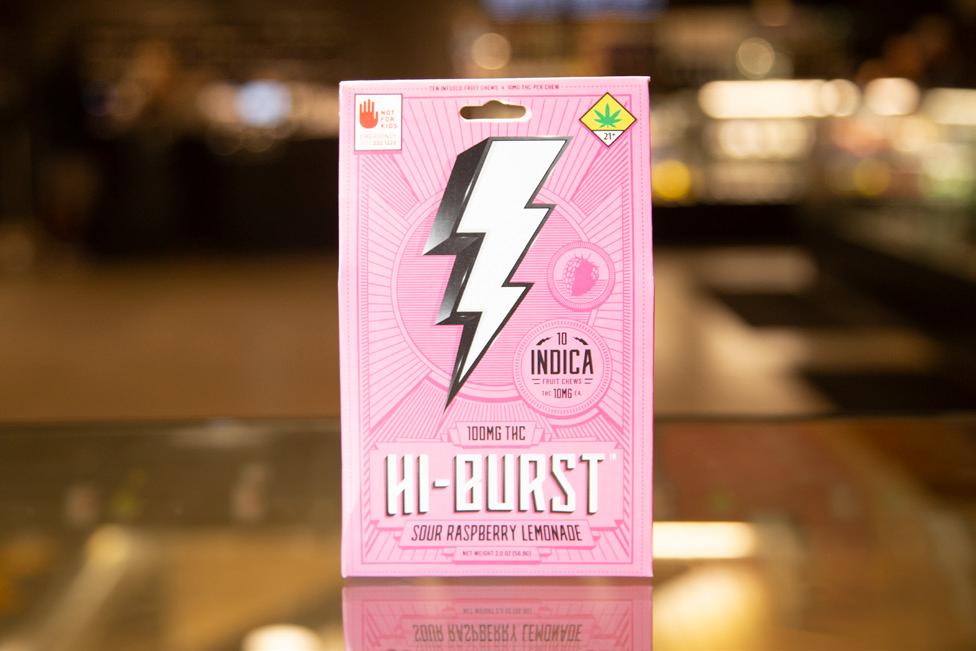







ALL YOUR FAVORITES, EVERY DAY OF THE WEEK. SIGN UP FOR OUR REWARDS PROGRAM TO LEARN MORE.

SPOKANE OTIS ORCHARDS MOSES LAKE
DEALS
DAILY
APEXCANNABIS.COM
PRODUCTS OPEN DAILY
3 SEPTEMBER-OCTOBER 2023 / OUTTHEREOUTDOORS.COM S ki p winter. Future you is on the Caribbean cruise you saved for. Open a First5 Savings Account and earn 5.09% APY on your first $500. You’ll be setting sail in no time.* Insured by NCUA. (509) 326-1954 | stcu.org/first5 *APY = annual percentage yield. APY is accurate as of the last dividend declaration date. No minimum balance required to earn the APY and no penalty for withdrawals. Balances above $500 earn 0.25% APY. Rate is subject to change and may change after the account is opened. STCU membership is required to open account and fees may reduce earnings. One First5 Savings Account per person.


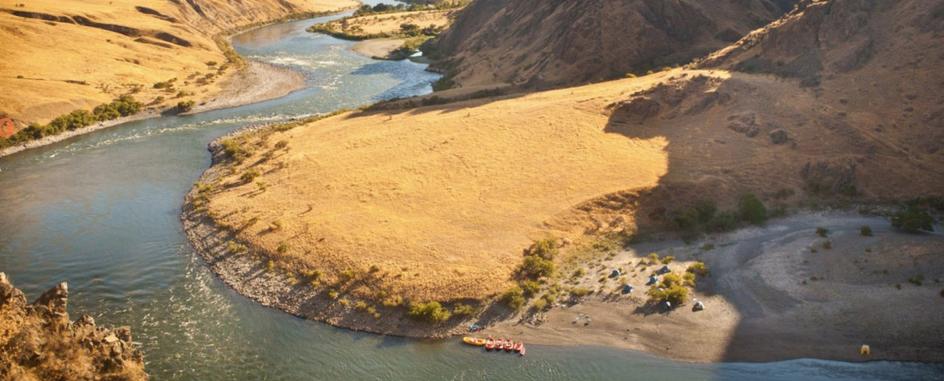


4 OUTTHEREOUTDOORS.COM / SEPTEMBER-OCTOBER 2023 In Every Issue 7 | Intro 8 | Dispatches 11 | Get Out There 18 | Provisions 46 | Last Page Feature 26 | Ranching in the Wild Departments 13 | Gear Room 17 | Outdoor Living 24 | Moto 25 | Biking Columns 12 | Everyday Cyclist 14 | The Trailhead 16 | Run Wild 20 | Literation 22 | Primitive Skills 23 | Out There Kids Special Sections 28 | Public Lands 38 | Fall Road Trips Maja DeWolf LeBron hiking in Mount Spokane State Park in order to train for three Cascade volcanoes in one summer. Cover Photo: Jon Jonckers CONTENTS specializing in deep tissue &sports massage www.HealingBalanceMassage.com Contact Lynn Short, LMP #60232419 M ASS A G E T H E RAPY HEALING BALANCE Specia l New Client Offer $5 off 60 minute massage $10 off 90 minute massge 36 MOBILE IV Hydration & Nutrition choose custom nutrition or from our menu: IMMUNITY BOOSTING HANGOVER OR INJURY RELAX YOUTH ELIXIR MIGRAINE RELIEF Locally owned and operated by a Spokane born and raised RN www.ivofferings.com 509-906-3464 Cold or Flu? we come to you! Upset Tummy? we got you honey! A bit hung over? we’ll come over!
Sandpoint is easy to fall for. With abundant trail systems for mountain bikers, hikers and trail runners alike, plus aquatic adventures for kayakers and boaters, and easily accessible scenic viewpoints - all within minutes of town - there is a piece of Sandpoint for everyone. And our great outdoors provides both place and inspiration for frequent events ranging from rides and runs to music and art happenings.

DON’T MISS THESE FALL EVENTS!
Schweitzer Fall Fest Sept 1-4

Artists’ Studio Tour Sept 2-3
WaCanId Bike Ride Sept 11-16
Find Your Strength 5K & 1K Sept 23

Utah Repertory Dance Theater Sept 27

Farmers Market Harvest Fest Oct 14
Crosstoberfest Cyclocross Oct 28
Less than 90 minutes east of Spokane, Sandpoint is nestled alongside magnificent Lake Pend Oreille amid two inspiring frontal ranges of the Rocky Mountains – the Selkirk Mountains that stretch north to Canada, and the Cabinet Mountains sprawling east into Montana. Don’t sweat the fall stuff! Find yourself in beautiful Sandpoint, Idaho.


5 SEPTEMBER-OCTOBER 2023 / OUTTHEREOUTDOORS.COM Get visitor information at 208-263-2161 www.VisitSandpoint.com
NATURE
OUR NATURE
FIND YOUR
IN
A FALL GETAWAY TO SANDPOINT! Scan the code to enter or go to VisitSandpoint.com
WIN
SEPTEMBER-OCTOBER 2023
WWW.OUTTHEREOUTDOORS.COM


PUBLISHERS
Shallan & Derrick Knowles
EDITOR-IN-CHIEF
Derrick Knowles
MANAGING EDITOR
Lisa Laughlin
DIGITAL EDITOR

Briana Loveall
SENIOR WRITERS
S. Michal Bennett
Carol Corbin
Adam Gebauer
Sarah Hauge
Amy McCaffree
Ammi Midstokke
Brad Northrup
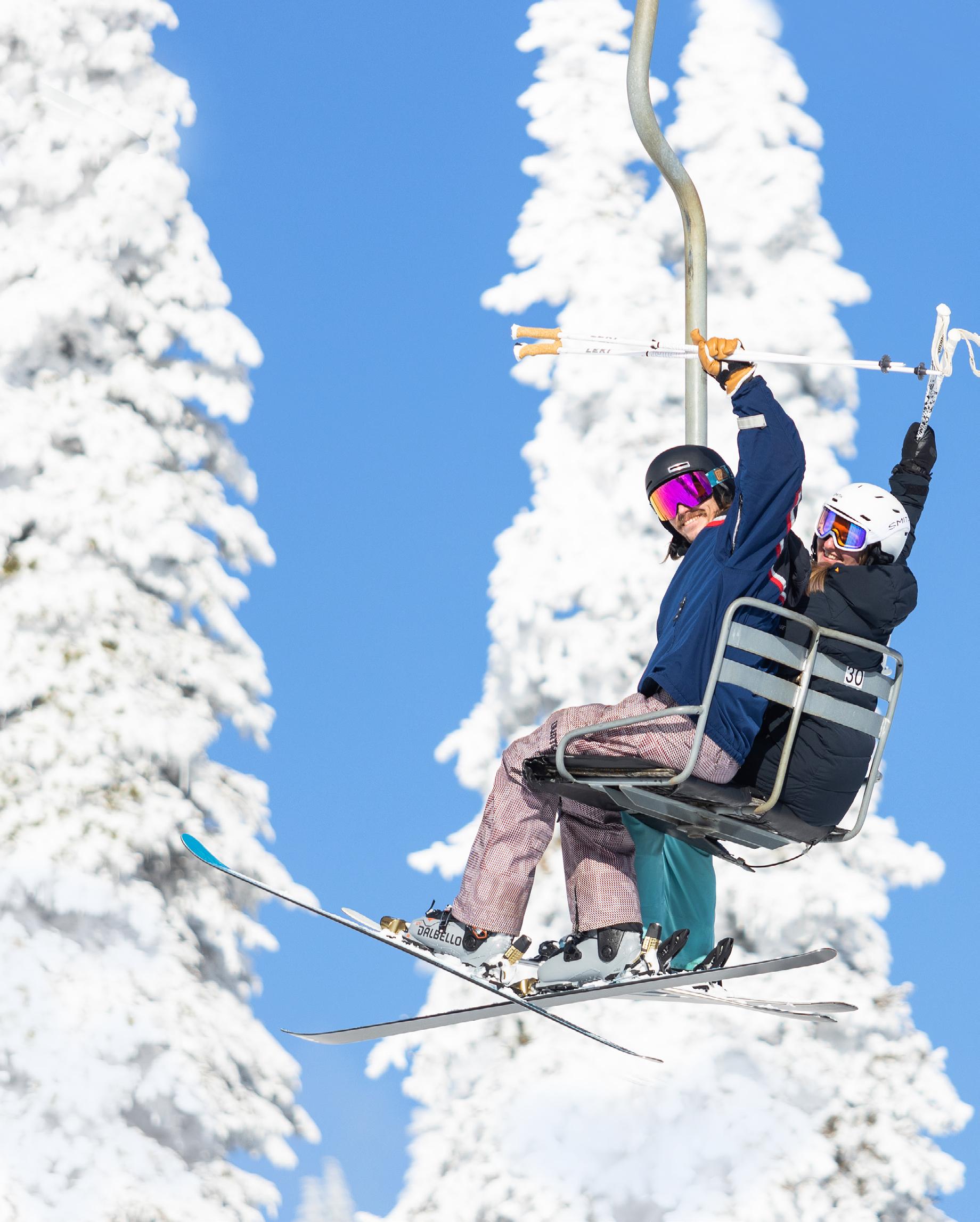
Justin Short
Aaron Theisen
Holly Weiler
CONTRIBUTORS
Jean Arthur
Bradley Bleck
Noah Botnick
Patrick Bulger
Kirsten Erickson
Ryan Flett
Tabitha Gregory
James P. Johnson
Karie Lee Knoke
Rich Leon

Mike Lithgow
Alana Livingston
Briana Loveall
Tanya Riordan
Rick Schafer
Todd Zeidler
ART + PRODUCTION
Jon Jonckers
Shallan Knowles
TO REQUEST COPIES CALL 509 / 822 / 0123
AD SALES Derrick Knowles: 509 / 822 / 0123 derrick@outtheremonthly.com

SUBMIT CONTENT IDEAS to: lisa@outtheremonthly.com
OUT THERE OUTDOORS
Mailing Address: PO Box #5, Spokane, WA 99210 www.outthereoutdoors.com, 509 / 822 / 0123
Out There Outdoors is published 6 times a year by Out There Monthly, LLC.
No part of this publication may be reproduced without written consent of the publisher.
©Copyright 2023 Out There Monthly, LLC.

The views expressed in this magazine reflect those of the writers and advertisers and not necessarily Out There Monthly, LLC.
Disclaimer: Many of the activities depicted in this magazine carry a significant risk of personal injury or death. Rock climbing, river rafting, snow sports, kayaking, cycling, canoeing and backcountry activities are inherently dangerous. The owners and contributors to Out There Monthly / Out There Outdoors do not recommend that anyone participate in these activities unless they are experts or seek qualified professional instruction and/or guidance, and are knowledgeable about the risks, and are personally willing to assume all responsibility associated with those risks.
PROUD MEMBER OF
SOLAR POWERED OUTDOOR MAG
6 OUTTHEREOUTDOORS.COM / SEPTEMBER-OCTOBER 2023
www.mtspokane.com BOOK SKI SCHOOL PROGRAMS & CAMPS TODAY! Mt. Spokane is the ultimate place to play for the entire family. Visit us online for operating hours, lift tickets, season passes, lessons, and special events happening all winter long. Limited space! Now accepting reservations for multiweek programs.
For the Love of a Place


was the beginning of heat exhaustion and overexertion. His face was pale. He was dizzy. He couldn’t catch his breath. We stopped for a long break in the middle of the trail.
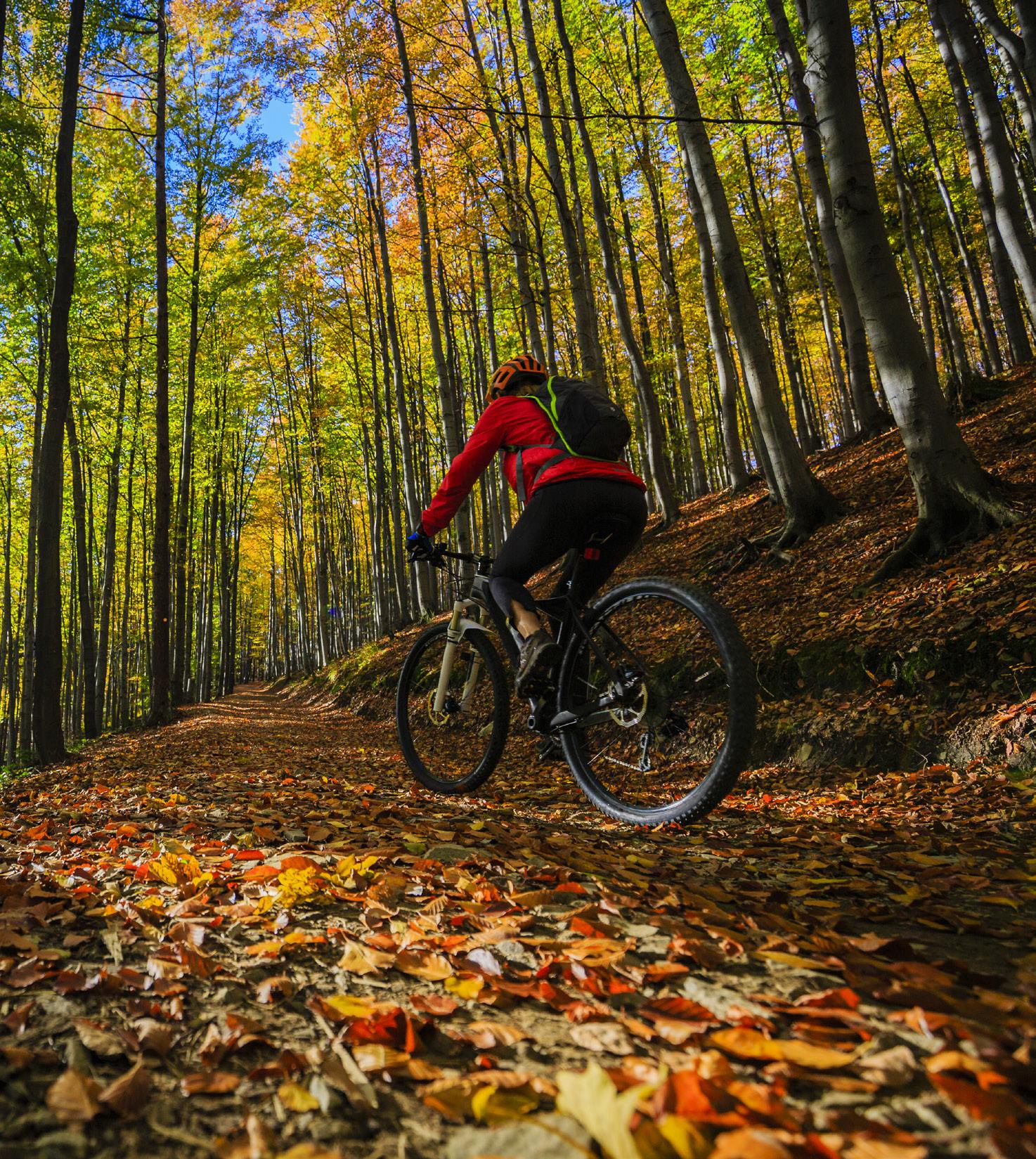
My dad had always been my guide in the wilderness; he was the sure-footed leader with generational knowledge of backcountry skills. After some soup and electrolyte chews—and a very long rest—my dad was able to pick up his pack again. But he barely made it into the lake that day, and he said it as we baby-stepped up the final set of switchbacks: it was the last time he would get into this kind of backcountry.
was somehow preserved.

All the backcountry stories we usually told came forward that night, and then some. My dad told a new one about my grandfather riding a motorbike into the area before it was designated a wilderness. My grandfather has been gone for a while, but the stories were as fixed to the place as the scree that lined the lake, or maybe the stars—shifting a bit with each telling, evolving as we did, but tied to that lake. It was a complicated solace to know that the place would remain even when my dad wouldn’t.
IT HAD BEEN FIVE YEARS since I’d hiked to the lake. It was a modest alpine lake in the northeast Cascades, tucked in the Lake Chelan-Sawtooth Wilderness, an area of public land that had accrued meaning for my family through years of trips and storytelling.
The area had experienced a wildfire in my absence. The trail was now lined with waisthigh fireweed, flaring pink in remembered flame. A sign at the trailhead warned hikers
that the charred trees might suddenly fall, burned roots giving out without warning. I went up with my brother and dad—4,000 feet in 8 miles—in the glaring sun, talking, as we did on every hike, of the relief the lake would be when we reached it.

Around mile three, my dad began to visibly suffer. It wasn’t the regular strain of hauling a 30-pound pack up rugged terrain (the kind where you surmise the trail was made with goats in mind rather than humans). It
His declaration colored the rest of the trip. Instead of crossing another pass on day two and hiking into a new lake, to route out a new loop, my dad sat in camp to recover. My brother and I hiked the pass and were rewarded with a stunning array of mountains to the west, Glacier Peak among them. I sat on that pass for a while. It was a view my dad would never see again.
My brother and I descended to the lake and spent the rest of the trip with our dad. We dodged mosquitoes and I tried my hand at fly fishing for the first time. As we cast, a thunderstorm rose and opened up on the valley below us. We watched rain fall in dark columns, but the sun remained in camp, giving the illusion that our time at that place
I’m grateful for that wilderness area, and that it can stay wild, whatever that looks like in the future. This is the power of the public lands we work to preserve, whether it’s for hiking, biking, hunting, fishing, or simply for the wildlife that live there. They’re places of stories, personal and communal, that date far back to the First Peoples who lived on the land.
Use the stories and resources in this issue—from fall road trips to a guide on what sort of recreation pass you’ll need—to make some memories with the next generation on our public lands. Sharing the wild places we cherish with others will give them the most powerful thing to fight for: love. //
Lisa Laughlin, Managing Editor


















7 SEPTEMBER-OCTOBER 2023 / OUTTHEREOUTDOORS.COM INTRO
(509) 671-5186 www.HighTechHighRec.com Find CONNECTION wherever life takes you in PEND OREILLE COUNTY Giga-bit speeds • Thriving Communities • Outdoor Recreation Scan now to explore! THE VIEW FROM CAMP // PHOTO: LISA LAUGHLIN
MOUNTAINFILM ON TOUR AT THE GARLAND SEPT. 28

WEDNESDAY NIGHT CYCLOCROSS SERIES RETURNS
SPOKANE, WASH.
The Jess Roskelley Foundation is hosting a local showing of Mountainfilm on Tour, featuring the best of the films awarded at the annual festival held each year in Telluride, Colorado. Join others for an evening of inspiring films to benefit local outdoor recreation projects. Doors open at the Garland Theater September 28 at 7 p.m. and the films run until 9:30 p.m. Beer and wine will be served and some great outdoor adventure prizes from The North Face, Lowa, YETI, Rambleraven Gear Trader, and Bloc Yard Bouldering Gym will be raffled off. Event tickets are $20 and are available in advance at Garlandtheater.com or at the door.
The foundation will be showing over a dozen of their favorite short films from the festival that will include outdoor adventure, environmental, political and social justice themes that the festival hopes will inspire viewers to go out and create a better world.
All proceeds benefit the Jess Roskelley Foundation’s pledge of $100,000 to help renovate John H. Shields (Minnehaha) Park and climbing area. Foundation board member John Roskelley says there is a complete renovation planned for the park. Once the City of Spokane and Spokane County have
completed the joint project, hopefully by late 2024, renovations will include a new parking lot, improved Centennial Trail access, ADA accessibility, a new restroom, and, thanks to the Jess Roskelley Foundation, a new children’s playground with multiple climbing features. “One of them will be a giant, climbable marmot made out of steel and cement,” explains John. “It will give families a chance to let their kids climb without having to go up on the rocks with ropes.”
In honor of the late Spokane native and elite international alpinist Jess Roskelley, the foundation exists to promote public projects and outdoor activities in the Inland Northwest that will benefit generations to come. Projects the foundation has helped fund so far include a climbing boulder in the Ice Age Floods Playground in Riverfront Park, a new restroom and trailhead at Deep Creek in Riverside State Park, and play features in Spokane’s Audubon Park.
In April 2019, Jess Roskelley was killed in an avalanche in the Canadian Rockies, along with two Austrian climbers. His family created the foundation to preserve the legacy of Jess and his love for Spokane parks. Learn more or make a donation at Jessroskelleyfoundation.com.
(Derrick
Knowles)
HIKE OR MOUNTAIN BIKE AND PLAY POKER FOR RIVERSIDE STATE PARK
SPOKANE, WASH.
Saturday, September 23 is the launch of a new fundraiser event for the Riverside State Park Foundation, with all proceeds going toward park projects and enhancements. This event features your choice of a mountain bike course or run/hike course. Each course features stations with a bean bag toss to earn a poker card at each of those five stations. Participants can win prizes for best hand and worst hand (rules will be posted onsite at check-in).
Event start times are self-selected, so you can start anytime between 9 a.m. to noon. Participants must finish by 2 p.m., when stations and courses close. The event is all about enjoying the trails and giving back to a park that is such a treasure to the community, so it isn’t timed. Each participant will
take home a custom pint glass.
Course options include a 5k for hikers, walkers, and runners, and a 10k for mountain bikers. All courses are non-technical and fairly flat and are suitable for younger children with hiking or biking experience. Children are not eligible for poker run prizes but get to participate in the bean bag toss at each station.
Since 2002, the Riverside State Park Foundation, a 501c3 nonprofit, has raised over $400,000 to support the park. This fundraising event starts and finishes at the 7-Mile Airstrip. The event is scheduled on a Free State Park Day, so no Discover Pass is required. Learn more and sign up at Riversidestateparkfoundation.org.
(Jon
Jonckers)
SPOKANE, WASH.
The Night Shift Cyclocross race series returns for its third year of Wednesday evening races at Riverside State Park in September. Cyclocross, explains series organizer Kyle Mensing, is kind of like a bicycle obstacle course that requires good bike handling over mixed terrain plus getting on and off your bike to make it over various obstacles . . . and maybe a little running. “It is amazingly fun and challenging,” he says, and doing it at night with course lighting (provided by Offroad Power Products) only adds to the excitement.
Mensing, a cyclocross fan who started racing eight years ago, says 75-100 participants typically show up each night. Each race is held at the same location, Riverside’s 7-Mile Airstrip, where the popular Wednesday Night Mountain Bike Race Series is also held in May and June.
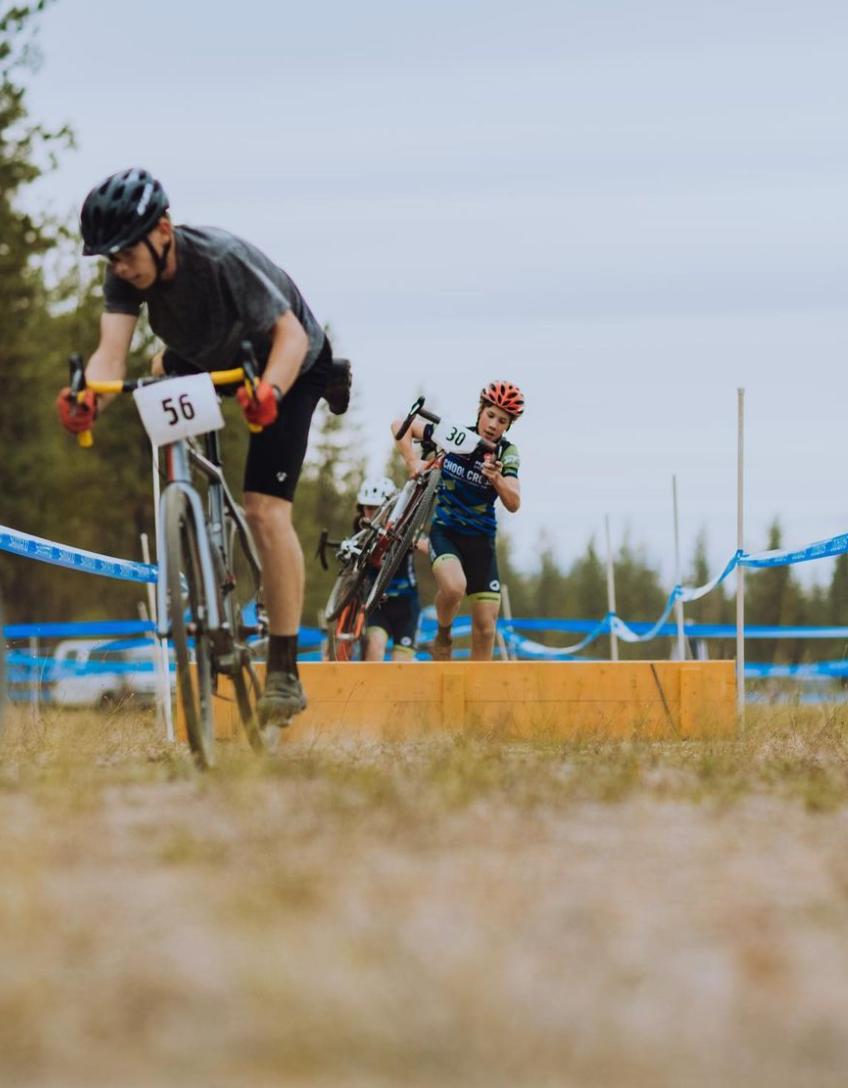
“It’s definitely a little different than other cycling disciplines,” Mensing explains, with a mixed surface course that includes dirt, gravel, and even some asphalt. While most
racers show up with gravel style bikes with bigger tires than road bikes, he says, you can pretty much race any type of bike. “We see a lot of people on mountain bikes. It has that mix of fun and challenge that’s really intriguing to a wide range of riders.”
The courses tend to be about a mile long and riders do as many laps as they can during the 30-40 minute time set for the category they sign up for. Race registration is $27 per night and kids ages 9-18 get to race for free thanks to support from School of Cross, Spokane’s junior cyclocross team.
Cyclocross racing also makes for an entertaining spectator experience, explains Mensing. “There’s some friendly heckling and cheering going on, and you get to see riders come by multiple times.” Hand-ups, where spectators hand out food and beverages to riders as they pass by, is also a big thing in cyclocross, he says. “Some riders race hard and others go slower and take all the food and beverages they can grab.” Register and find all of the details at Velonw. com. (Derrick Knowles)
8 OUTTHEREOUTDOORS.COM / SEPTEMBER-OCTOBER 2023
DISPATCHES
OBSTACLES ON THE TRAIL ARE ALL PART OF THE FUN IN CYCLOCROSS. // PHOTO COURTESY OF THE NIGHT SHIFT
SPOKANE, WASH.
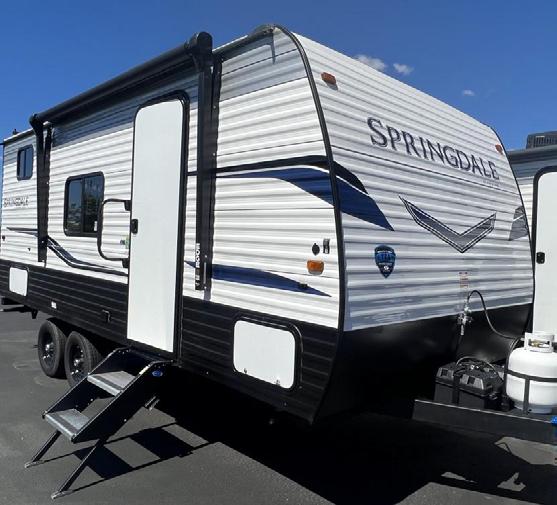
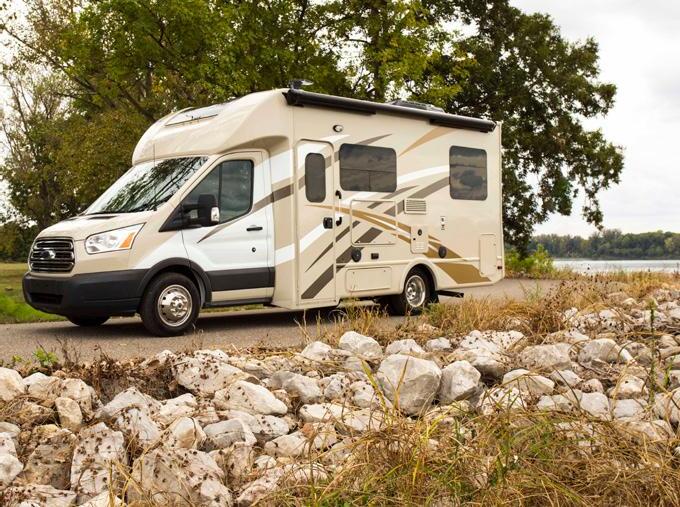



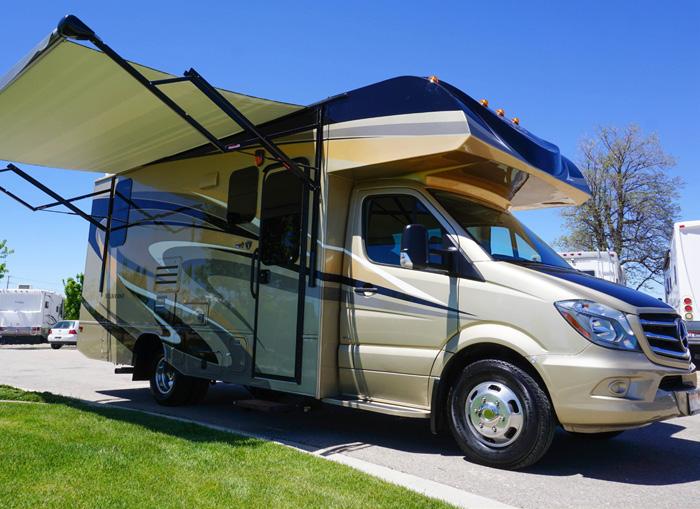
Over the Edge, a Habitat for HumanitySpokane project that raises thousands of dollars to help local families attain affordable homeownership, is looking for courageous and caring individuals willing to rappel 22 stories down the side of a building. On Saturday, October 14, Habitat for Humanity-Spokane will send 78 fundraisers literally over the edge of downtown Spokane’s tallest high-rise, the 288-foot-tall Bank of America Financial Center.

“I did it our first year,” says HabitatSpokane's CEO, Michelle Girardot. “It is definitely a thrill, but certainly not as scary as you might think.” A lot of the people who sign up have had a fear of heights, she adds, and many of them say the experience helped them get over their fear.
This unique campaign is intended to bring both awareness of and relief from the current housing emergency for families that might otherwise not be able to afford a home. As the housing crisis continues nationwide, the organization is determined to creatively raise funds for equitable homebuying opportunities in Spokane County. The demand for safe and affordable places to live has increased
dramatically in Spokane County too, with Habitat’s waitlist reaching over 1,000 families hoping for their opportunity to build stability through homeownership.
The actual rappelling typically only takes a few minutes; however, Girardot adds that some people take their time to enjoy the scenery and experience. Quite a few of the people who sign up have never done anything like this before, she explains, noting that the experience run by rappelling experts is incredibly safe. “You are roped in and have all sorts of safety equipment around you. It would be hard to get hurt in any way.”
Over the Edge spots are limited, but there is still time to register and start your fundraising effort. Registration is only $50 and goes toward the fundraising minimum of $1,000, which Girardot says is typically easy to raise with donations from family, friends, and co-workers given the quality of the cause. Habitat staff are happy to help rappelers reach their fundraising goals if needed too, and participants have until November 14.
For more information, to register, donate, or for sponsorship information, visit habitatspokane.org/over-the-edge. (OTO)
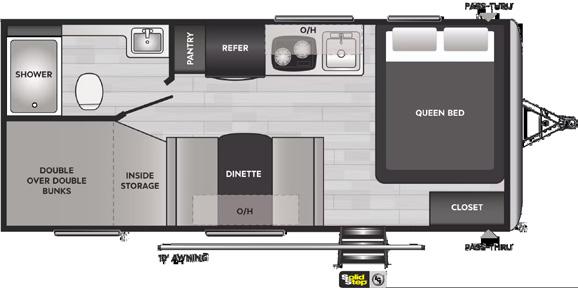
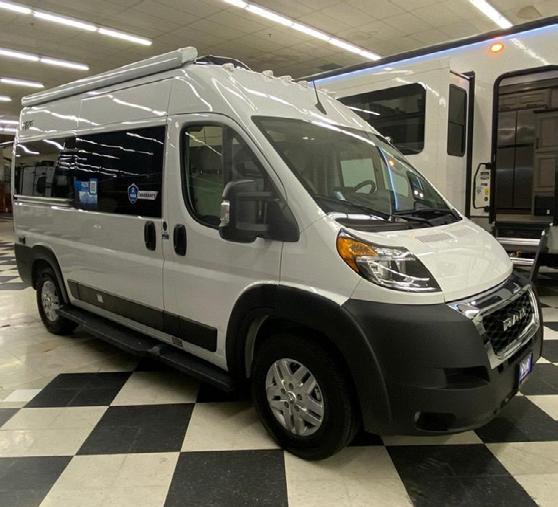

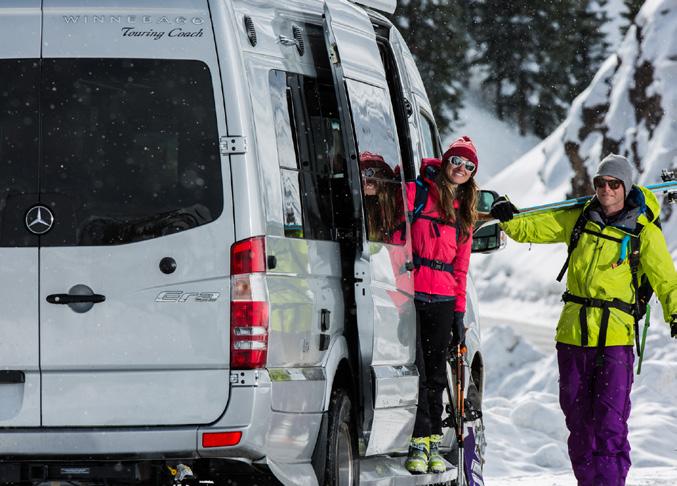
9 SEPTEMBER-OCTOBER 2023 / OUTTHEREOUTDOORS.COM RAPPEL OFF A BUILDING FOR A GOOD CAUSE VAN WORLD STOCK #75593 NEW! 2023 THOR RIZE 18M Sale $99,990 Was $119,881 NEW! 2022 SPRINGDALE 2010BH STOCK #14834 $244/MO* NOW $28,230 Was $33,531 Fall Clearance Save Thousands On 2023 Models! North Spokane - 509.244.5888 www.RnRRV.com Liberty Lake - 509.927.9000 *All offers OAC. 180 mo. @ 7.99% plus tax, title, license and 10% down. Subject to prior sale. Expires 10-31-23.
GOING OVER THE EDGE FOR GOOD. // PHOTO COURTESY OF HABITAT FOR HUMANITY SPOKANE
GONZAGA LAUNCHES CLIMATE PLANNING CERTIFICATE PROGRAM


MEAD OUTDOOR SCHOOL PROVIDES NON-TRADITIONAL LEARNING

SPOKANE, WASH.
Beginning this fall, a collaboration between Gonzaga’s Center for Climate, Society and the Environment and the university’s Center for Lifelong Learning will offer an online Climate Certificate Program. This program is among the first of its kind in the U.S. and seeks to arm community members—professionals and volunteers—with a way to build skills and effect positive change.
According to Dr. Brian Henning, the Center’s director, the certificate program was conceived as a tool to train residents (especially in small and mid-sized towns) to help their communities develop plans to reduce climate pollution and make their communities more resilient. Students will learn how to engage their communities; assess climate impact and vulnerability; measure, track, and mitigate greenhouse gas emissions; and implement climate and social justice strategies.
Henning says that students will learn foundational content and skills and leave with a clear plan for how to successfully
facilitate this work in their own communities and organizations. For example, participants can develop concepts and vet strategies for dealing with contemporary threats, including increased fire and smoke, longer stretches of high heat, and drought.
The program is open to potential students ranging from recent graduates to mid-career professionals. A bachelor’s degree or at least five years of any kind of work experience (may include jobs held during high school) are the only prerequisites. Because the classes will all be online, students anywhere may participate. For more information, visit Gonzaga.edu/ClimateCert. (Tabitha Gregory)
SEKANI TRAIL RUN REBUILDS MOMENTUM
MILLWOOD, WASH.
An annual 5k and 10k race that also includes a free kids’ 1k event, the Sekani Trail Run has become a fall tradition for runners and walkers of all ages and abilities to set out on together on the trails of Spokane’s Camp Sekani Park. Like in the past, this year’s event, held on Sunday, October 1, is the biggest fundraiser of the year for the Franklin Elementary School’s A.P.P.L.E program. Before the pandemic, the event attracted
hundreds of runners each year. Organizers hope to re-build momentum and inspire an even bigger turnout of trail runners, road runners, hikers, and walkers this year to come together to explore the park’s excellent singletrack trails and beautiful views. The 10k, with 700 feet of elevation, is a great challenge for those who want to push themselves too. Find more info and register at Sekanitrailrun.com. (OTO)
SPOKANE, WASH.
K-8th grade students in the Mead School District are thriving in the place-based learning that Mead Outdoor School (MOS) provides them at Camp Dart-Lo in north Spokane, Wash. This unique educational program is part of the district’s innovative, non-traditional offerings through Mead Learning Options.
At MOS, students attend classes outdoors two days per week, all school-year long, rain, sleet, snow or shine. This program focuses on project and place-based learning with emphasis on social studies and science.
Parents provide instruction in reading, writing, math and support for science and social studies throughout the remaining three days each week at home.
One particular day in science, for example, the class studied water filtration. The teacher brought small groups of students down to the Little Spokane River so that they could collect and analyze water samples. Back at main camp, other students were in their social studies block giving speeches about the importance of clean water for salmon. Much like a traditional school, these students conduct research, cite sources, construct a five-paragraph essay, and present in front of the class, but the scenery and connection
with nature is wildly different. The calming effect of being in nature also provides respite from cognitively-demanding academic tasks.
Interspersed between content blocks, students get to choose a “Connections Class” from a collection of interdisciplinary activities. These classes often focus on using the local environment as a context for learning. By studying the natural and cultural resources of their environment, students develop a sense of place and a deeper connection to their community.
“Not every child learns in the traditional classroom setting, and we want to make sure every child is successful in whatever way they can be successful,” Director Tracy Taitch says. “The site is perfect with meadows, a forest, rock outcroppings, wetlands, and the Little Spokane River. And maybe most importantly, there is a community of students, staff, and families who care deeply about providing a rich outdoor learning experience for our children.”
Interested in learning more about MOS or want to contribute to its mission? Visit Mlo.mead354.org/outdoor-school or contact MOS Director Tracy Taitch directly at tracy. taitch@mead354.org. (Kirsten Erickson and Todd Zeidler)
10 OUTTHEREOUTDOORS.COM / SEPTEMBER-OCTOBER 2023 DISPATCHES
TOP: SCREEN SHOT OF GONZAGAS WEBSITE TO ENROLL IN THE CERTIFICATE PROGRAM. LEFT: BRIAN HENNING, INSTRUCTOR OF THE PROGRAM. // PHOTOS COURTESY OF GONZAGA UNIVERSITY
AWESOME CLASSROOM. // PHOTO COURTESY OF MEAD OUTDOOR SCHOOL
Five Activities for Your Fall Bucket List






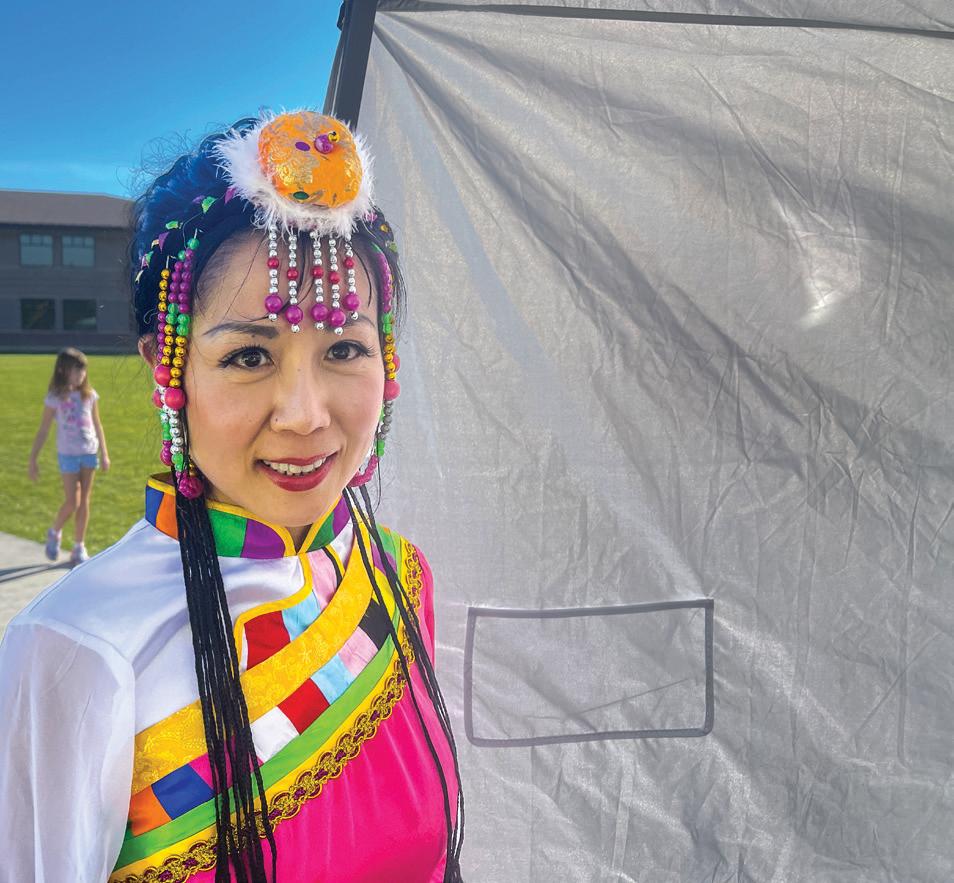
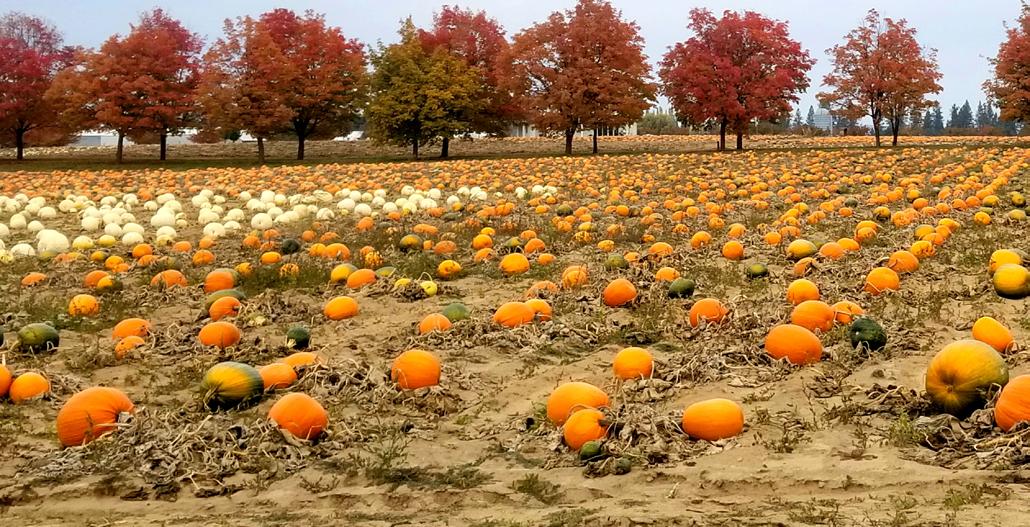
AS THE YEARS HAVE PASSED, I have noticed a change in my bucket list goals. While my younger self sought out adrenaline-fueled adventures like long marathons and mountain summits, my wiser self now craves a more holistic approach to experiences. I find myself drawn to activities that engage all my senses, providing both mental and physical achievements. Fall in particular is one of my favorite times of year to embark on my bucket list pursuits. Here are five outdoor goals for this season that you might want to consider adding to your own list.
1. Run the Jackass Half Marathon from Wallace to Kellogg, Idaho. This October race offers the perfect opportunity to immerse yourself in the beauty of fall foliage along the Trail of the Coeur d’Alene’s. Not a long-


distance runner? No worries! There’s also a 5K option and a kids’ cumulative half marathon, making it family friendly. You also get to pick out the style and color of your finisher t-shirt that is printed out for you by race day. Alternatively, try running one mile a day throughout October, totaling 31 miles—more than a half marathon distance while still enjoying the delightful fall scenery.
2. Stand Up Paddle Board the Little Spokane River. Fall provides a wonderful chance to savor the tranquility of the river while being surrounded by picturesque fall colors. The St. George to 9-mile takeout is a two- to three-hour journey. (Note: the shuttle service ends September 5.)
3. Sleep in a Treehouse. Among various


outdoor accommodations, sleeping in a treehouse has been a long-standing desire of mine. A Wee Place in the Woods, located in Priest River, is a communal retreat with several lodging options, including two treehouses. The Owl’s Nest Treehouse, nestled in the trees, promises a truly captivating experience, especially during October.
4. Enjoy the Fall Harvest. While apple picking and pumpkin festivals are delightful and I do look forward to them every fall, this year I have my sights set on squash. Eleven Acres Farm in Greenbluff boasts over 20 varieties and I feel challenged to try them all. They have your standard squash like delicata squash, acorn squash and spaghetti squash, but it’s the not-so-common I get excited about. How about sweet potato squash,
kobocha squash or banana squash? I am getting hungry just thinking about it!
5. Bike the Trail of the Coeur d’Alenes. This two-fold goal involves biking the whole 70.8-mile trail and incorporating bike camping along the way. I plan to take advantage of the chilly mornings and evenings that fall offers, as I tend to struggle with the heat. Whether completing the journey in two separate trips or all at once, this adventure is a must. For those seeking a shorter ride, the trail can be tackled in sections, offering equally stunning scenery, and there are non-camping lodging options along the way too. (Alana Livingston) // Alana owns Wander Spokane, a guided walking tour business. She will be enjoying a plethora of winter squash this fall.
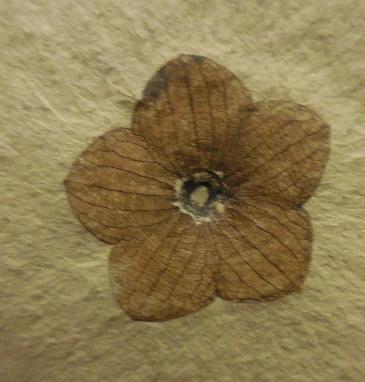
11 SEPTEMBER-OCTOBER 2023 / OUTTHEREOUTDOORS.COM GET OUT THERE
Join us for three fun-filled and festive days. Enjoy a parade, car show, live entertainment, vendor booths, beer and wine, science and technology, multi-sport Sunday, and CultureFest events (all for FREE!) SEPTEMBER 22–24, 2023 Free VALLEYFEST
FALL ADVENTURES. // PHOTOS: ALANA LIVINGSTON See What You Can Discover This Fall at the Interpretive Center StoneRose Fall hours: sept 6 - oct 31 // wednesdays - sundays 8 am - 4 pm & Eocene Fossil Site HWY 20 & Clark Ave, Republic, WA -509-775-2295 - Stonerosefossil.org Hunt through ancient shale layers to discover 50 million year old leaves, cones, insects, and maybe a rare fish or bird feather. Keep 3 fossils per day per person. (Significant finds may be retained for research)
The Full Moon Fiasco
By Justin Short
THE MOON’S GRAVITATIONAL pull causes the rising and falling of tides in our planetary oceans; we humanoid creatures composed of 70% water have no hope to escape the pull of the moon’s magic and mystery. So how can you not hop on a bike, head down to Soulful Soups & Spirits in down-
town Spokane, perhaps in a costume, to tool around town with friends on a gentle ambling route to some unknown destination—almost always another bar or pub— perhaps hooting, perhaps hollering with the full moon lighting the way? This is the Full Moon Fiasco (FMF).

My first exposure to FMF happened in 2013 on what is still the biggest ever FMF with 400 or so riders. I was biking across town to ride my wife home from work around 11p.m. when I encountered group after group of riders peeling off in all directions, most of them wearing costumes and riding bikes bedazzled with light shows worthy of a UFO abduction. What the hell had I just missed? That was to be the last FMF for a while, because original organizer Jeff Everett was moving to Portland and wanted to leave a blank slate for the local bike community to figure out.
How long had FMF been going prior to that? I caught up with current organizer, Joshua Hagen, to learn a little more. “I came to my first Fiasco 18 years ago,” he told me. There’s no telling when it actually began, but it probably coincided with Everett’s arrival here from St. Louis, whereupon he opened the Spokane chapter of the F%¿#ing Bike Club (FBC), a grassroots dis-organization of sorts existing in small but vibrant chapters all over the country. “The FBC doesn’t exist in any official capacity and is open to anyone at any experience level,” says the Chicago FBC blog page. “What we do is drink beer and ride bikes, the flagship ride being the Full Moon Fiasco every month.”
There is only one rule in the FBC: “Don’t be an a$$hole,” which implies things like wearing a helmet, following traffic laws


(which include not riding while intoxicated), and not being a creeper toward women on the ride. I forget exactly how one joins the FBC, but when you do you’ll become a “lifetime member for life,” and when you find yourself living in a town without an FBC, you have the responsibility to open one.
“They opened one in Sandpoint a few years ago,” continued Hagen, “they’re getting 100 riders at their Fiasco each month.” An interesting aspect of the FMF are the spoke cards featuring original designs from local artists. They’re a buck each, but you’ll most likely be handed one and never asked for your dollar.
To join the mayhem, hop on your clunker, commuter or carbon race machine and head down to Soulful Soups & Spirits at 7 p.m. on the next full moon. Just to avoid confusion, the ride will be on the calendar day of the actual full moon. Wheels roll at 8 p.m. and only one person knows where we’re going. Grant Shipley will be there towing his thumping sound system with a curated playlist that makes for a delightful soundtrack to the night’s adventure. If you’re lucky, that guy Ted will show up and light his bike on fire again … but not during smoke season. That would violate the one rule. //

Justin Short has a BA in English from California University of Pennsylvania where he spent five years avoiding responsibility and riding bikes as much as possible.
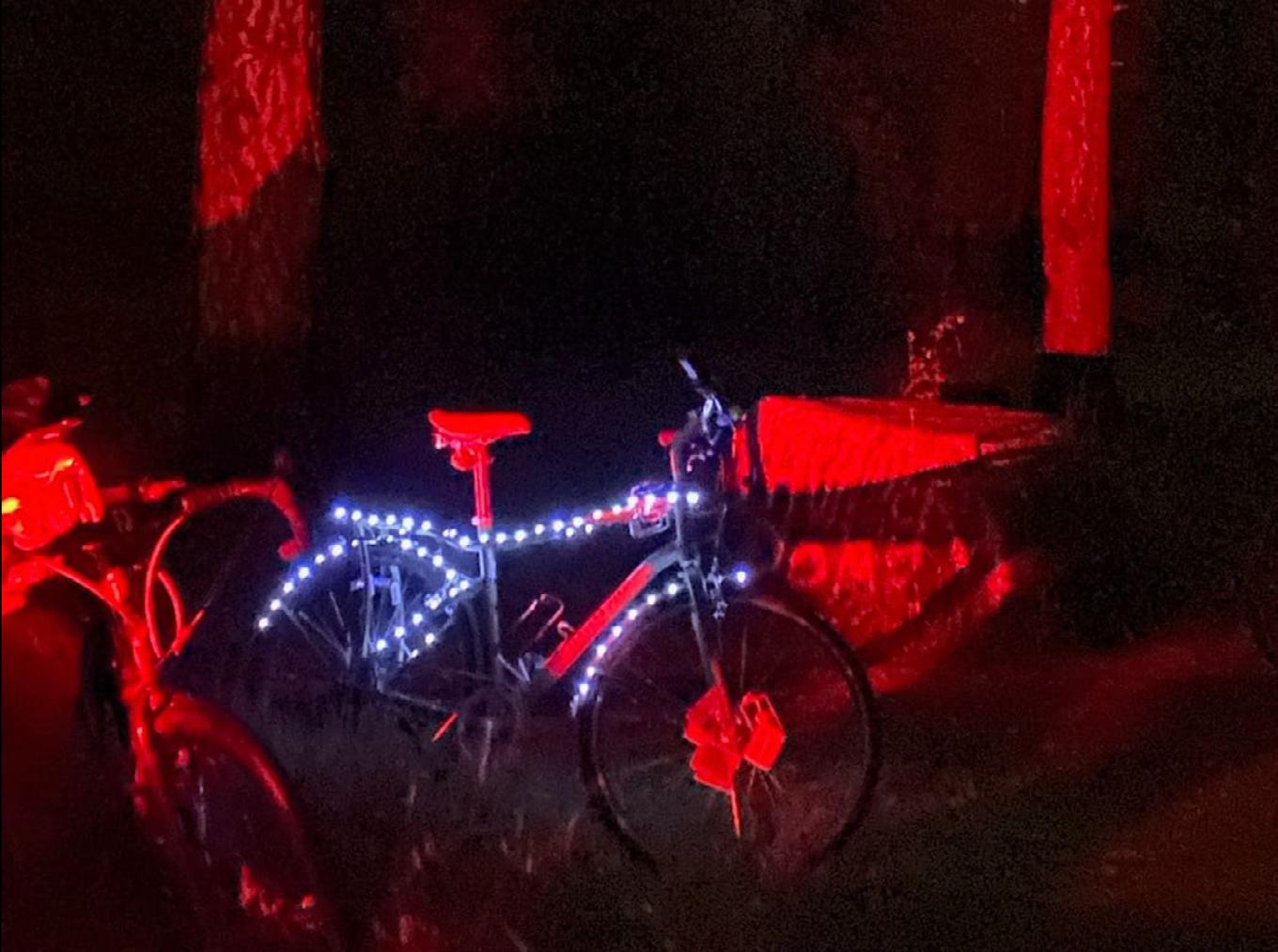
12 OUTTHEREOUTDOORS.COM / SEPTEMBER-OCTOBER 2023 EVERYDAY CYCLIST
PHOTO COURTESY OF THE FBC. //
PHOTO: JENN MEESE
GEAR ROOM
Fall Adventure Equipment
By Derrick Knowles
This brilliant, compact, and portable propane campfire and grill is packed into a stainless-steel ammo can-style package that makes it easy to stow away in your vehicle or RV. The FireCan Deluxe can be quickly transformed between grill or fire pit modes by removing the grill insert, which takes seconds. Adjust

the temperature for controlled grilling and put the lid on for quicker cooking. After dinner, crank up the dualburner campfire that’s raised off of the ground for ambiance and handwarming comfort. Everything you need comes packed in the can, including a 5-ft. quickrelease hose. MSRP: $299.99. IGNIK.COM

Luci Solar-Powered String Lights
By Jean Arthur
My elk hunting trips are often filled with walking and biking miles and miles behind closed gates, followed by bushwhacking down canyons and up the sides of mountains until dark. And all that sweaty work requires a jacket that can multitask for chilly mornings, stormy highcountry afternoons, and pitch-black walks back to camp. Enter the Sitka Mountain Evo Jacket. The Mountain Evo does everything a backcountry hunting jacket should do: it moves
with your body, protects from the wind and rain with GoreTex Windstopper, and has stretch panels for added breathability and movement where you need it on the underarms and back. I know this jacket will keep me warm and dry out in the woods this fall, and I’m hoping some of that magic might rub off on my bad luck streak and elkless freezer too, but I’m not holding my breath.MSRP: $329.
Sitkagear.com

DURING A RECENT RIVER TRIP, my paddle partner lit our evenings with a solar-powered Luci light string. The 18-foot cord with 20 LED lights providing 100 lumens is durable, lightweight and water resistant. I was amazed that one day when we forgot to leave Luci in the sun, it still lit up—we got 15 hours on a single charge.

Even more fantastic is that the light can charge a mobile device via a USB cord. Thanks to a salesperson at R.E.I., I discovered that charging my Luci via my computer USB allowed me to fully charge my phone from the 5-inch diameter Luci. Only once, though. Just by solar charging, I couldn’t get another phone charge. But there’s good news.
Now, the manufacturer of the Luci, MPOWERED, brightens my campsite even more with a 44-foot Pro Series Solar Light with mobile charging and colored string lights: pink, violet, blue, turquoise, green and white. The detachable solar-recharge battery charges my phone, which I use for photos when out on adventures. The flashlight mode beat our headlamps fourfold in lumens and ease.
The 44 feet of nylon-braided cord and 40
LEDs inside 20 shatterproof bulbs provide 140 lumens. (That’s a lot!) I can speed charge the Luci as well via USB. All this brightness derives from a 7-inch diameter by 2.87-inchhigh device that packs in at 1.6 pounds and costs $69.95.
MPOWERED, as a Certified B Corporation, aims for sustainable products and donates solar-powered products in global areas impacted by natural disasters and humanitarian crises. MPOWERED also offers a recycling program for Luci lights. Luci lights are a great light source for your next adventure, and even proved river-trip hardy.
A great pair of all-around adventure pants, these stretchy, DWR-coated (for water resistance) nylon britches are packed with features that come in handy out in the wild. Reinforced knee panels ensure added durability while communing with Mother Nature, whether you’re hunting for mushrooms on all fours or crawling around blowing on a campfire. A water-resistant side pocket protects your precious phone during amphibious episodes, and the two hip pockets have mesh sides that improve ventilation. One of my favorite features, with international travel in mind, is a hidden back zip pocket for stashing cash or other valuables. I also love that these pants come with a draw string and belt loops. MSRP: $99. Roark.com

German producer of outdoor gear Jack Wolfskin continues to carve out a U.S. niche with quality products like the Terraquest boot. While I haven’t been able to test them long enough to prove this, a quick inspection of the quality design and durable materials lends me to believe these boots are made to stand up to miles of rough trail abuse. In addition to a waterproof and

breathable membrane, I like how well built they are, with features like durable nubuck leather and abrasion resistant Cordura ballistic fabric, reinforced lace eyelets, and solid Vibram soles. All of that also means they weigh a little more than some other lightweight hiking footwear, but the trade-off in this case seems worth it. MSRP: $199.95.
Us.jackwolfskin.com
13 SEPTEMBER-OCTOBER 2023 / OUTTHEREOUTDOORS.COM
FIRECAN DELUXE FIRE PIT
SITKA MOUNTAIN EVO JACKET
ROARK EXPLORER ADVENTURE PANT
JACK WOLFSKIN TERRAQUEST TEXAPORE HIKING BOOT
The Trailhead
Inland NW Trail & Outdoor News
By Holly Weiler
OUTDOORSY EVENTS
• National Public Lands Day (NPLD) falls on Sept. 23 this year. It's a fee-free day for both National Parks and Washington state lands. Discover Pass fees will additionally be waived on Oct. 10 for World Mental Health Day.
• Spokane County Library District will be hosting a mushroom foraging for beginners class on September 20 from 6-8 p.m. in the North Spokane meeting room. Attend to learn about some of the edible mushrooms found in our region!
• Join the Methow Conservancy for a series of free events, both in person and online, during September and October. Highlights include an in-person presentation on lynx and wildfire, a field trip through the newly acquired Sunny M. Ranch property with a focus on the forest, and a Zoom presentation on bats from WDFW. (Methowconservancy.org)
• Free guided hike destinations with Inland Northwest Land Conservancy during September include Waikiki Springs, Palisades Park, and Saltese Uplands. (Inlandnwland.org)
• The Dishman Hills Conservancy's annual dinner and auction fundraiser will be held on October 16 at CenterPlace Regional Event Center. (Dishmanhills.org)
LET YOUR VOICE BE HEARD!
The Blue Mountains region, consisting of the Umatilla, Wallowa-Whitman, and Malheur National Forests, is currently undergoing a revision of its existing Forest Plan. A series of public meetings is planned throughout September and October, including an online Zoom meeting option on October 10. Join any of these and then consider providing formal comments to help guide the process. For more information, contact Sm.fs.bluesforests@usda.gov.
STEWARDSHIP OPPORTUNITIES
• The annual Spokane River Cleanup will be held on September 16. Sign up with The Lands Council for this self-guided event, with designated trash collection sites in multiple locations along the Spokane River. (Landscouncil.org)
• Friends of Scotchman Peaks Wilderness have several trailwork events planned through the month of September, including a NPLD project at Regal/Morris Creek on September 23. They will wrap up the trailwork season on September 30 with a project at Goat Mountain. (Scotchmanpeaks.org)

• Spokane Nordic will have several weekend days of volunteer trail maintenance in September and October in preparation for the upcoming Nordic ski season. (Spokanenordic.org)
• Evergreen Mountain Bike Alliance will be offering a fall weekend's worth of work parties in the Methow from September 29-October 1, with camping available at Upper Beaver Creek Campground and the work happening on nearby Blue Buck and Lightening Creek Trails. Food included, but advance registration required. (Evergreenmtb. org)
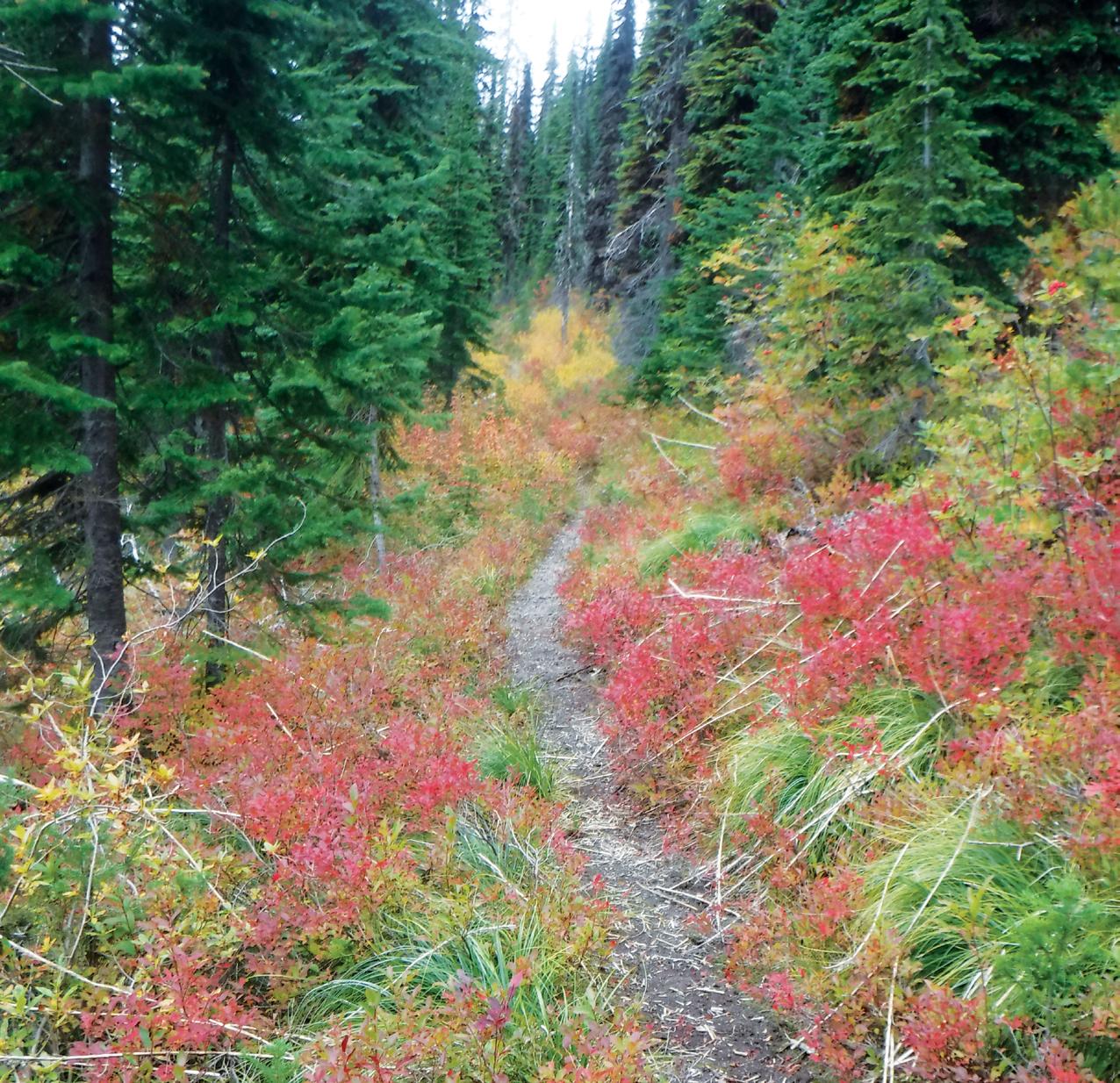
• Okanogan Highlands Alliance will be partnering with Pacific Northwest Trail Association on September 9 for a day of heavy restoration work on Beaver Lake Trail. PNTA will be hosting a variety of additional projects throughout September and into early October, working on the Kettle Crest and near Sullivan Lake. (Okanoganhighlands.org and pnt.org)
• Idaho Trails Association (ITA) and Washington Trails Association will be partnering on the Jackson Creek Trail in North Idaho near the Salmo-Priest Wilderness the first weekend after Labor Day. Join either crew as they work to meet in the middle at the WA/ID boundary! ITA will additionally be hosting a National Public Lands Day project at Chimney Rock in the Idaho Selkirks, while WTA will be celebrating the organization's 30th anniversary of the trail maintenance program with a return to Iller Creek Conservation Area in Spokane Valley for annual maintenance on September 18, as well as a project at Fishtrap Recreation Area near Cheney, Wash. (Idahotrailsassociation.org and wta.org) //
HIKE OF THE MONTH HUGHES FORK AND JACKSON CREEK
(SELKIRK MOUNTAINS, NORTH IDAHO)
Hughes Fork and Jackson Creek share a trailhead near Hughes Meadows in the Idaho Panhandle National Forest. Each can be a stand-alone day hike for visitors to nearby Priest Lake, remaining low to enjoy the old growth forest's lingering huckleberry patches in September or fall mushroom season as rains return in October. The area is home to numerous wildlife species, from lowly western toads to massive moose and relatively rare grizzly bears.
Those looking for a more challenging hike can opt for the backpack loop version, a route to rival the nearby and more popular Salmo Loop. With maintenance projects planned for late summer into early September by area nonprofit groups, the Hughes Fork and Jackson Creek Loop will likely be in the best condition it has been in for several years just in time for fall backpack trips. The trail passes through a recovering forest following the Hughes Fork Fire of 2017. The fire's impacts are evident on large portions of the loop, but most of the giant cedars along the route survived the blaze.
The best way to hike the full loop is counter-clockwise, heading up Hughes Fork. The trail starts parallel to and providing peek-a-boo views of Hughes Meadows before gradually beginning to climb toward the Shedroof Divide. The trail enters the Salmo Priest Wilderness at the Washington/Idaho state line, and pops out onto the Shedroof Divide at a shared intersection with the Shedroof Cut-off Trail (an alternate starting location from the Washington side). Turn south on the Shedroof Divide, enjoying the ridgeline views in a portion of the trail that saw the most severe fire impacts but also contains some of the best fall colors. The trail passes beneath Thunder Mountain, a fun side-hike option to a former fire lookout via an unmaintained spur trail. At the shared intersection with Thunder Creek (secondary alternate starting point from the Washington side), turn east on Jackson Creek Trail to descend and complete the loop.
At 26 miles total, this is best for a 2-3 day backpack trip if completing the full loop. Day hikers can turn back at whatever distance is desired. Once back at the start, it's worth the nearby side-trip to continue to the dead-end of NF 1662 to see the old Hughes Meadows Cabin.
USGS Maps: Upper Priest Lake, Continental Mountain, Salmo Mountain, and Helmer Mountain.
Getting There: From Nordman, Idaho, continue on N Nordman Road. This turns into West Side Road, or NF 302. The road crosses back into Washington, passing Stagger Inn Campground at 12.9 miles north of Nordman. The road re-enters Idaho at 4.4 miles past Stagger Inn; continue straight on NF 1013. Continue 2.2 miles, then turn left on NF 1662. Continue 1.5 miles to an unmarked NF 1399 on the left. When the gate is open, this road leads to trailhead parking for Hughes Fork and Jackson Creek Trails. The gate is closed from late summer through spring to protect grizzly habitat, but there is a small parking area to the side for hikers, adding roughly 1 mile roundtrip to the hike.
14 OUTTHEREOUTDOORS.COM / SEPTEMBER-OCTOBER 2023
FALL TRIALS. PHOTO: HOLLY WEILER
DISHMAN HILLS. // PHOTO LISA LAUGHLIN





15 SEPTEMBER-OCTOBER 2023 / OUTTHEREOUTDOORS.COM
RUN WILD Finding the Perfect Pace Lessons from Unexpected Teachers

 By Sarah Hauge
By Sarah Hauge
ONLINE INFLUENCERS , running group coaches, my much-faster friends: all have impacted my running life with their words and actions. Recently, I’ve been reflecting on a few of the unexpected teachers who’ve taught me lessons in pacing I certainly wasn’t expecting.
FROM THE “CLASS CLOWN”
In high school, I was deeply into books, Seinfeld, and hanging out with friends. I wasn’t very active, but there were a few times when I attempted to get into running. As I jogged down a neighborhood street, a boy I knew was outside too. To be “funny,” he literally ran circles around me as I continued on my way, keeping up an effortless, sassy conversation—his way of underscoring how mockably slow he thought I was. He thought he was pretty entertaining, but it sucked. What did I learn? First, it's deeply uncool to make a joke at someone else’s expense. Also, that some people care a lot about their pace, your pace, and how they compare. But my pace was my pace, regardless of what other people might think or say. If I were going to continue running, it would be for myself—not to impress anyone else.

FROM MY DOG
I have an incredibly friendly, smart, energetic dog who is better than me at all physical feats—except endurance running. He has zero interest in steady, consistent effort. For him, running is a means to the best end imaginable: exploring the

world! I see Felix’s priorities in his friendly expression and curious eyes: who you’re with, who you meet, what you smell, what squirrels you attempt to chase, the parks you pass through. His approach forces me to be more present to my surroundings. Yes, there are many speed adjustments and occasional sharp veers off the path. He sometimes simply flops on his side in the middle of the road, not out of tiredness but because there’s something he must look at, and otherwise I’ll succeed in rushing him away. Our pace? Unimpressive. But as Felix constantly conveys, the pace is so clearly not the point. We’re outside!!! Get excited!
FROM WITHIN
Sometimes, it’s my own inner voice that tells me exactly what I need to hear, when I need to hear it. I was struggling on a hot July day and wanted to pause for a break before running up a hill. I was slowing when these words crossed my mind, unbidden: “It’s running. It’s supposed to be hard.” This unprompted mantra put what I was doing into perspective. I didn’t choose running because it was easy, so why was I expecting it to feel that way? I shifted my perspective—the next section would feel hard, and that was okay. I ran on without needing that break after all. //
Sarah Hauge is a writer, editor, and grant writer who lives in Spokane with her husband and two kids. She’s looking forward to running the Sundae Sunday 10-miler in September—and (more importantly) the ice cream at the finish.
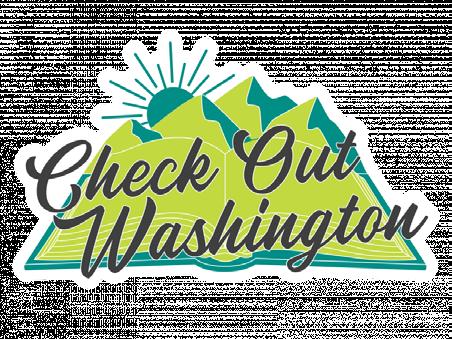
16 OUTTHEREOUTDOORS.COM / SEPTEMBER-OCTOBER 2023
www.scld.org CHECK OUT A New Adventure Borrow a Discover Pass Backpack from the library— now with a 28-day checkout! www.scld.org/check-out-wa
SPOKANE COUNTY LIBRARY DISTRICT
PACING PARTNERS CAN PROVIDE ENTERTAINMENT AND DISTRACTIONS! // PHOTO: CAROL CORBIN
Expand Your Tomato Eating Season:
By James P. Johnson
Creative Preservation Tips
window that Spokane’s climate allows, I strive to expand my tomato-eating season with creative tomato preservation.
Like other gardeners, I use old blankets topped with a tarp or plastic sheeting to cover plants whenever below freezing temps are forecast. I typically have 12 to 16 plants, and I used to cover them all. It was a headache. These days, I choose just two or three in the sunniest location that still have lots of fruit. I pick the other plants clean on the latest date possible, separate red fruit from green and put in trays in my basement. I’ve picked tomatoes into the second week of November. Though cool temps diminish taste and cause black spots to sometimes form on the skin, which I have to cut off, they’re still better than store-bought.

dish that benefits from ripe, summer tomato flavoring.
I also dry tomatoes using a dehydrator. It’s somewhat time-consuming, but the dried slices pile up quickly and are so sweet and tasty. Whenever I pull them out, usually adding to pasta, I eat a bunch as if they were potato chips.

I’VE HAD AN ORGANIC, backyard vegetable garden for over 35 summers, and tomatoes have been in every one. Having a glut of tomatoes as the weather turns cool means taking action. I once brought a potted tomato plant inside when the weather turned cold as an experiment. It survived, but there was no growth. I eventually harvested the fruit, which tasted good, but this
is little but an inefficient way of storage. How long the plant will last, I don’t know, but our days are too short to grow tomatoes in winter.
There’s a big taste difference between store-bought tomatoes and locally-grown. Realizing I couldn’t grow tomatoes in pots next to my slider door in winter, and without a greenhouse to extend the two or so month
I freeze bags of 12-15 summer tomatoes and, in winter, boil them down to make sauce, adding garlic, onions and other garden vegetables I’ve frozen, which takes a couple hours. I used to boil down several dozen and freeze the sauce. This was convenient for making quick, multiple, spaghetti meals, but boiling down so many tomatoes at once was time consuming, and I gave up this laborious task a few years ago.
I also freeze a bunch of bags containing just two or three tomatoes and add to any
I continually fetch the fresh ones I keep in the basement, which can number well over 100. As the red ones get eaten, the cool basement delays ripening, and the green ones slowly turn red, lasting into February. I occasionally pull out bad ones—it’s inevitable losing a few. Formerly green tomatoes eaten fresh in the middle of winter don’t compare to summer tomatoes, but they still have taste that beats store-bought. By protecting plants from frost when planting in April, I get ripe tomatoes by July. By storing in the basement, I’m able to eat fresh tomatoes seven months out of the year. Like that character famous for eating lots of cookies, my tomato eating entitles me the moniker, Tomato Monster. //
Though James P. Johnson really likes homegrown tomatoes, he appreciates and buys commercially grown when his supply runs out.
17 SEPTEMBER-OCTOBER 2023 / OUTTHEREOUTDOORS.COM
OUTDOOR LIVING
A BATCH OF DRIED TOMATOES FOR FUTURE USE. // PHOTO BY JAMES P. JOHNSON
“Comfortable, durable and completely reliable. Best socks ever, thank you.”
Deb Patten
provisions
(n.) food, drink, or equipment, especially for a journey.
VEGGIE SANDWICHES WITH A KICK
LENTIL SOUP FOR YOUR FALL ADVENTURE

DOMA COFFEE FOR PUBLIC LANDS
As a nature and wildlands enthusiast, I love any project that works toward securing and protecting the integrity of natural landscapes. I also happen to love coffee.
Enter DOMA’s La Bicicletta, a medium roast blend with notes of fruit, chocolate, and spice that was borne out of a love for bicycling and a desire to support the local community.

I remember the first time I had a cup of DOMA’s coffee (Boots Bakery circa 2015). Admittedly, I’ve only learned to appreciate black coffee in the last decade or so (previously I’d been a double white chocolate raspberry mocha type of gal), but that first cup of freshly brewed DOMA coffee was a game changer for me.
Recently, DOMA partnered with the Zion Forever Project, the official non-profit partner of Zion National Park. Together with Zion Cycles, a bike rental company located just outside Zion National Park, they are working to expand biking trails and building a new visitor center for their “Feel the Flow” project just east of Zion National Park. One dollar of each can of La Bicicletta goes directly toward creating over 70 miles of new mountain biking trails. As I sit to write this, I’m preparing to leave for Zion at the end of the month and am eager to explore the park from one of Zion Cycles’ mountain bikes. Even if Zion doesn’t fall on your destination vacations list, it’s pretty cool to know that every delicious sip of local La Bicicletta funds a project that highlights the continued need for open and accessible outdoor recreation opportunities throughout our nation.
(Bri Loveall)
Serving Size: 2-3
Inland Northwest tomatoes are in their peak season and their flavors are unmatched by those you find at the grocery store. Crispy feta balances the sweetness of candy-ripe cherry tomatoes and balsamic vinegar in this recipe. Serve on crostinis, with pasta, or alone as a warm salad.
INGREDIENTS
1 pint cherry tomatoes from Elithorp Farm, sliced in half
2 cloves garlic from Dogwild Farm, crushed ½ cup marinated feta from Brush Creek
Creamery
Balsamic glaze
Salt and pepper
1 sprig flat leaf parsley from The Corner Farm, minced
DIRECTIONS
Preheat the oven to 400 degrees F. Place the tomatoes, garlic, and marinated feta in a cast iron skillet and toss slightly. Drizzle with balsamic glaze and roast for half an hour until the feta is crispy. Enjoy! (Courtesy of LINC Foods—The Local Inland Northwest Cooperative @Lincfoods.com.)


When I hike, it’s often an all-day, 15-25 miler. I pack a variety of snacks, but I need a main item to raise my caloric intake to the mucho level. Let me introduce my veggie sandwich.
I’ve been making my own multi-ingredient, vegetarian sandwiches that have evolved over the years and really satisfy. A combination of cheese, condiments and vegetables that I source from my backyard garden makes a meal that I’m eager to pull out in the middle of my hike.
I usually make two sandwiches, using a hoagie or everything bagel. I lay on sliced cheese, tofu (I slice this myself), fresh dill, basil and an herb that really ups the deliciousness level—thyme. I pile on onions, pickles, tomatoes and an ingredient that sets my sandwiches apart: Serrano peppers, which I grow, dry and grind myself. This gives it a kick that makes me want to eat another and another.
Miner’s lettuce, a mild, small-leafed green that grows wild throughout the Northwest, tops off my sandwich. I had never heard of Miner’s lettuce until coming across it in a seed catalog and finding out it’s native to our area. Named for its use by 19th-century California gold miners who benefited from its high vitamin C content, which prevents scurvy, I’ve come across it in wild areas around Spokane and even in town. Mainly a spring and early summer crop, it re-seeds so profusely that I’ve never had to replant since its first year. When hot weather comes and the Miner’s lettuce declines, my garden romaine or red leaf lettuce takes its place in the veggie sandwich.
Look to your garden or forage at a local farmers’ market for fresh, late-season produce to make this knockout sandwich for your next day hike or road trip.
 (James P. Johnson)
(James P. Johnson)
My family first enjoyed this crimson-colored organic lentil soup during a river trip. I made the soup using Montana organic, heirloom Petite Crimson Lentils from Timeless Seeds and late-season veggies, herbs and spices from my garden and a local farmers’ market. I froze the soup to keep the cooler chilled during our multiday paddle. The cilantro remained fresh in loosely sealed wax paper.
INGREDIENTS
4 tablespoons olive oil // 1-2 chopped onions // 4-6 garlic cloves, minced 3-4 garlic scapes, sliced and halved into 4-inch long strips // 2 teaspoons ground cumin // ½ teaspoon salt // ½ teaspoon black pepper // ¼ teaspoon cayenne or red pepper flakes // 1-2 fresh or dried whole peppers such as habanero // 2 cups chopped tomatoes // 2 quarts broth (chicken or vegetable) // 3 cups water 2 cups rinsed organic Petite Crimson lentils // 2 large carrots, diced // Juice from 1 lemon // 1 cup fresh cilantro, chopped
DIRECTIONS
1. In large pot, sauté onion, garlic and garlic scapes in oil for 4-5 minutes.
2. Stir in chopped tomatoes, cumin, salt, pepper, and cayenne. Sauté for 2-3 minutes.
3. Add broth, water, whole dried pepper, and carrots. Simmer for 5 minutes.
4. Add 2 cups red lentils and simmer 30-40 minutes, partly covered.
5. Use an immersion blender to partially puree lentils and ingredients.
6. Add lemon juice. Remove from heat, cool, then freeze for the camp cooler.
7. Serve heated up and topped with fresh cilantro.
After a few days camping, my family experimented with additions to the soup, from jalapeños to salsa, chopped tomatoes, fresh basil, a squeeze of lime and even chopped ginger. While the recipe makes enough for eight large servings, no leftovers survived my four hungry boaters. (Jean Arthur)
18 OUTTHEREOUTDOORS.COM / SEPTEMBER-OCTOBER 2023
FETA ROASTED CHERRY TOMATOES
THE AIR IS COOL AND CRISP . When most people are thinking about tailgate parties and football, my thoughts turn to exploring the woods for fall mushrooms, whether edible or non-edible. It is always great to bring home edibles, but I more enjoy the thrill of finding something new or something I haven't seen in a few years. In this article, I will be taking you on a narrative mushroom foray to my favorite area in Mount Spokane State Park.
After we enter the state park, park at the first trailhead, which is across the road from the restroom. We will be taking trail 121. I barely get 20 feet on the trail when I spot my first edible mushroom. It is some flattop club coral. These can be eaten raw and have a sweet taste to them. A great way to start our foray.
Next I find some milk caps (lactarius deliciosus)—edible, but not delicious by any means. The next mushroom I find is some scaly vase chanterelle. Technically edible, but not recommended. Some people do eat them, but many people have also gotten sick from them. Not worth the risk.
When the trail reaches a wet area, I find some wood ears growing on an old log. They may not look it, but they are a prime edible. Many people dry these and use them in soups, which is perfect for fall. They can also be used in stir fry. They have an interesting chewy texture, but not a lot of flavor. If you cut them off close to the tree, they will come back again after a good rain.
Not far from the wood ears, I spot the best of all the fall mushrooms: a large bunch of oyster mushrooms growing on one of the trees.They should also be cut close to the

tree so they can grow back again.
A short distance from the oyster mush rooms, the trail splits and I can either take trail 290 back to the parking area or go on 120 until it reaches 122 and goes down to the trailhead. I take the latter and soon find a couple more great edibles. The first one is a nice batch of honey mushrooms. They get their name because they have the color of honey, not because of their taste. A short distance down the trail, I find some King Boletes (also known as porcini). These are the best-tasting of all the boletes and probably the only one worth bringing home.
I stop for a lunch break and look at the list of different mushrooms I have found. Besides the edibles, I found many non-edibles. A couple of interesting ones are an Elfin Saddle and a Witch's Hat. A very good day indeed, I think, as I make my way back to the trailhead.
If you decide to check out this Mount Spokane area, get yourself a good mushroom book. I recommend "All That The Rain Promises and More" by David Arora, although it’s always best to go with a mushroom hunting expert or two who can help confirm edible species until you are confident in your own identification abilities.
Here is my list of prime edibles to look for when you are out mushroom hunting this fall: oysters,king boletes, wood ears, honeys, bears’ head/lion’s mane, chicken of the woods, chanterelles, flat-top club coral, lobster mushroom, and shaggy manes. (Rich Leon)
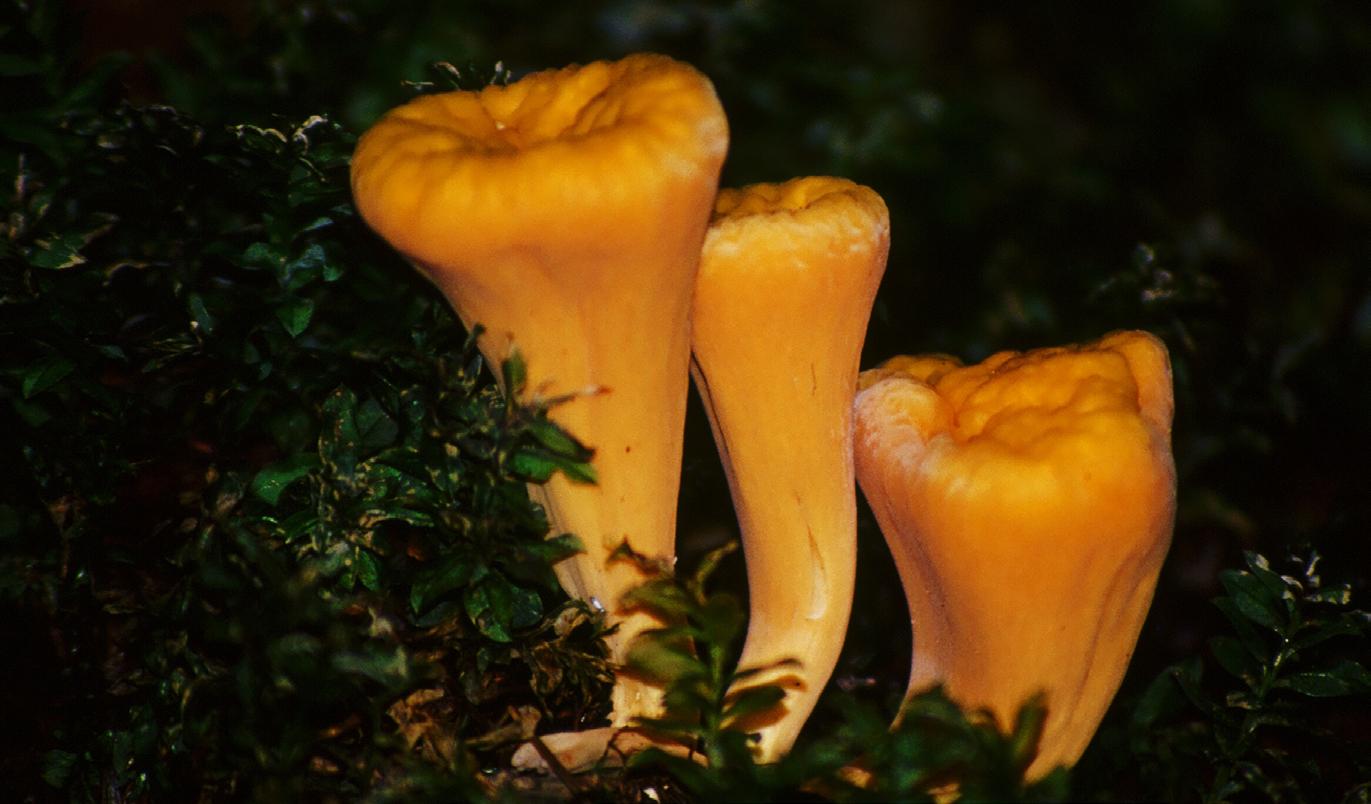
Rich Leon will most certainly be out mushroom hunting this fall, looking for something really unusual to photograph.
Fall Compost Fair & Leaf Festival
Saturday, October 28, 2023


11 am-2 pm
John A. Finch Arboretum
Spokane County residents who complete the activities may take home a free compost bin. Limit one per household. Bins provided by the Spokane County Regional Solid Waste System.
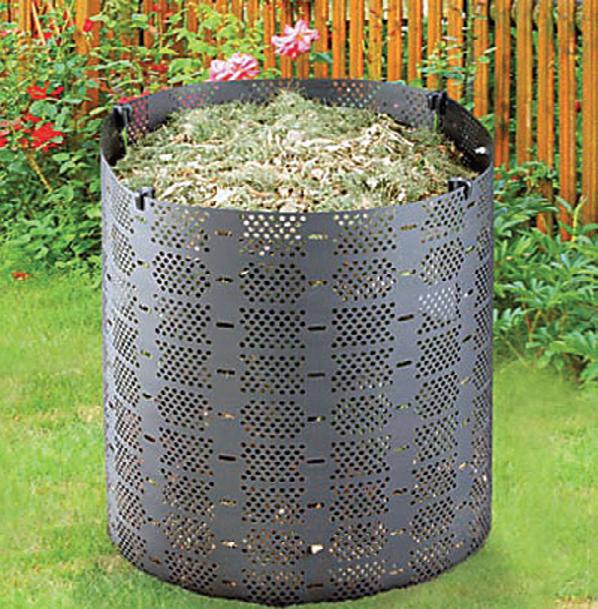
Please arrive no later than 1:30 pm and bring proof of residency.
For more information call 509-625-6580 or go to www.spokanecountysolidwaste.org
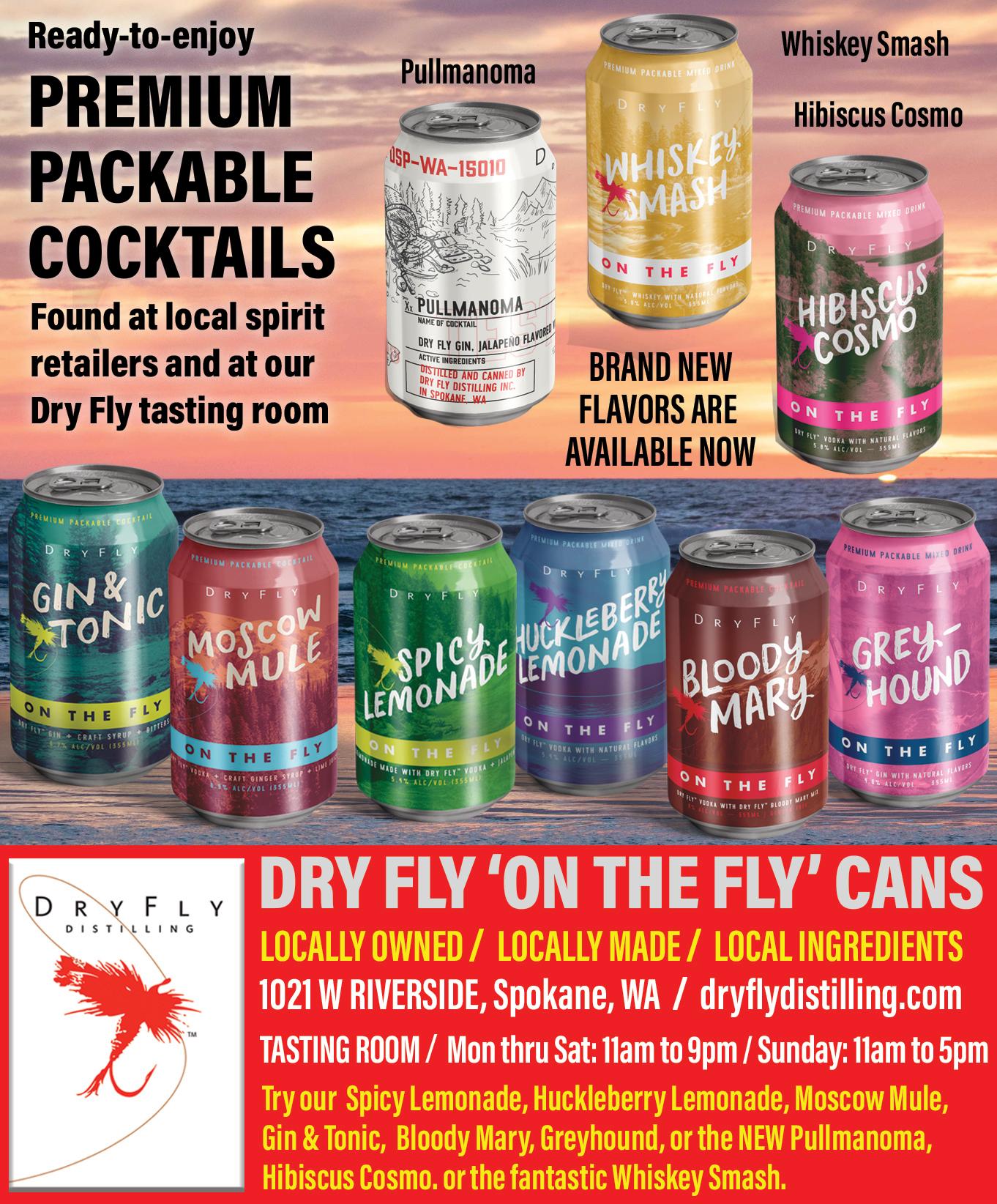
Spokane County Regional Solid Waste System

19 SEPTEMBER-OCTOBER 2023 / OUTTHEREOUTDOORS.COM
MUSHROOM
ON
Partial funding provided by WA State Dept of Ecology.
FALL
HUNTING
MOUNT SPOKANE
provisions, continued FLAT-TOP CLUB CORAL MUSHROOMS. BELOW: OYSTER MUSHROOMS. // PHOTOS: RICH LEON
Literation

Books and the Affordable Tourist of Time
 By Ammi Midstokke
By Ammi Midstokke
FOR THOSE OF US who are explorers of the world and senses, the curious of time and place, the tinkerers of history and optimists of science, books afford us a kind of tourism otherwise impossible. Whether by our inability to bend the space-time continuum or jet-set to Laos, we are left to the imaginations of authors to take us to those places and reveal their wonders.
The thought struck me as I journeyed through the Congo during its fight for independence. I could feel the red clay soil under the soles of my bare feet and smell the rain on jungle leaves. I heard unfamiliar birds and the way wind carries a different sound across the grass. I bore witness to ritual and landscape and culture without leaving my footprints or American dollars behind.
The author (in this case, Barbara Kingsolver in “The Poisonwood Bible”) crossed not only oceans and language barriers, but the divide of time, bringing us to a place in history where global powers clandestinely shaped kingdoms and countries. These stories matter, because history is our greatest guide, our greatest source of wisdom, and our greatest well of compassion and understanding.

There is a culture of sensationalism around travel—primarily for Instagram posts, as far as I can tell. As my friend Paul Lindholdt recently explored in his book, “Interrogating Travel,” those of us privileged enough to travel internationally invariably have unforeseen impacts when doing so.

We drive locals to selling sarongs on once-pristine beaches, then to relying on tourism for their economy. We infiltrate and distort their culture, bleeding our own into it until theirs is a dissipated and westernized version. We fly planes and drive cars and take boats to go to these places that are but memories of what they once were.
If you’re like me, you suffer from the knowledge that there are corners of this earth you will never see, that you must prioritize where you go. Is it more important to see the fjords of Norway or the Himalayan passes of Bhutan?
Over and over again, I am rescued from myself by reading. And something called “bioregional tourism,” which I think refers to riding my bike to the nearest ice cream parlor or venturing to learn about the Indigenous Peoples of our area. It turns out, rich cultural history and the shaping of civilizations can be found right outside our doors and in the minutia of our every day life.
There is so much available beneath our feet and at our fingertips. Scrolling the social-media-devil, I see a post about a sunrise run up some Indonesian volcano and the FOMO (Fear Of Missing Out) hits hard. Is my backyard hike small living? Are we missing out on something amazing by not traveling? Or could we go farther and wider with a trip to the library? //
20 OUTTHEREOUTDOORS.COM / SEPTEMBER-OCTOBER 2023
Ammi Midstokke lives in North Idaho, where she'll be spending the fall swinging a hammer on a new home building project. If she's lucky, she'll just be supervising.
NATURE Rodents of Restoration
By Adam Gebauer
support the fur trade and were one of the main drivers of colonial expansion into what would become the western U.S. The landscape has since changed dramatically with the construction of roads along rivers, agriculture in floodplains, and waterfront property.
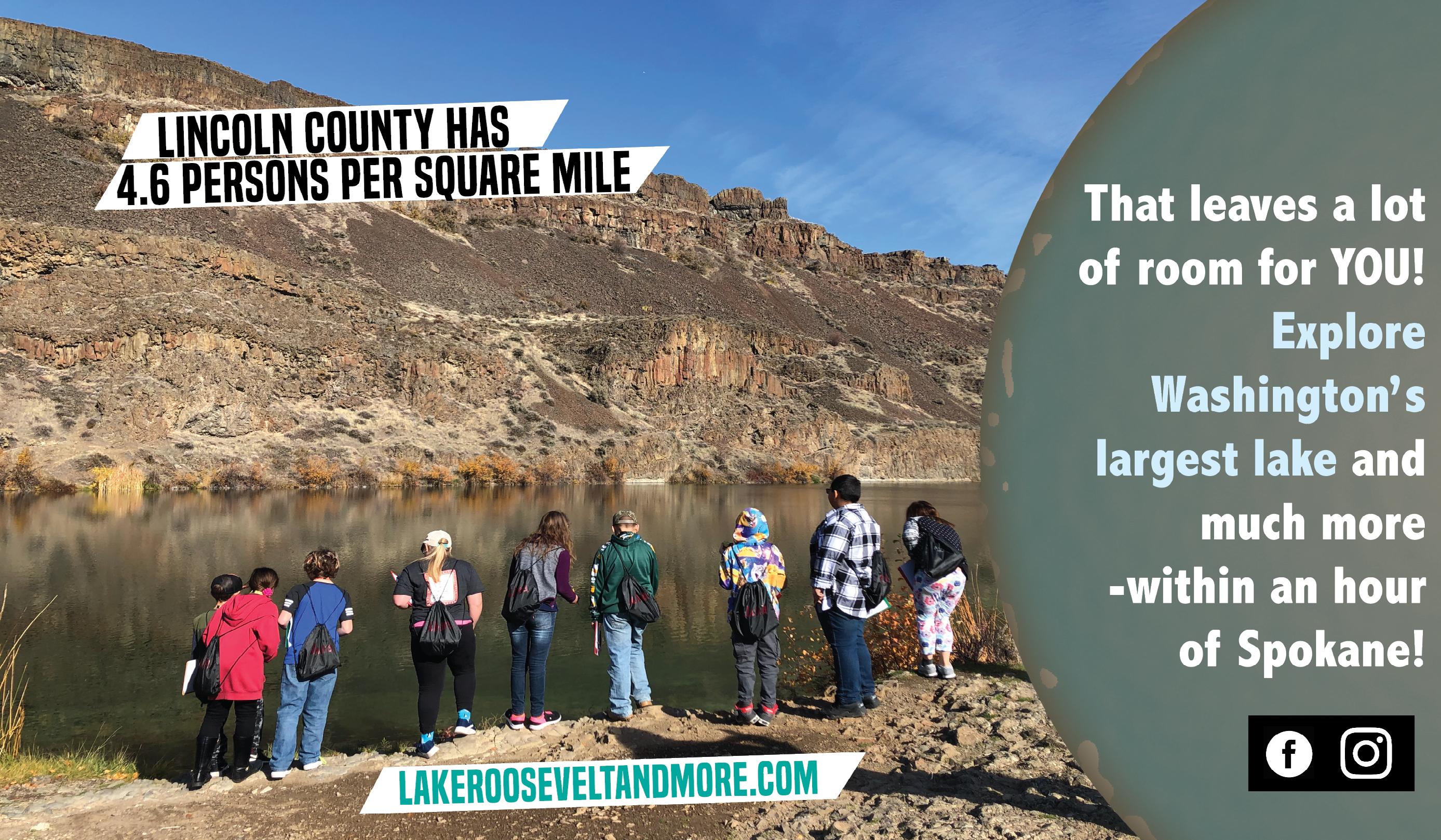
recognize the ecological benefit of beavers. The bill acknowledges that beavers foster biodiversity, restore habitat and build wildfire-resilient landscapes. The bill is also designed to mitigate conflict. It supports relocation efforts and requires lethal removal, when necessary, to be done in a humane manner.
There is also a bill before the Oregon governor that would shift beaver management from agriculture management to the Oregon Department of Fish and Wildlife (ODFW).
must complete training, have a husbandry facility, submit a relocation plan, and monitor post-release.
Recently, a WDFW biologist presented a white paper to the Washington Fish and Wildlife Commission on the ecological benefit of beavers. This action is to foster conversation and action on how to continue to increase the ecological benefits of beavers in the state.

BUSY AS A BEAVER is not just a quaint phrase. These rodents can transform a landscape in a matter of days, creating fastidiously managed dams, intricate lodges and food caches with underwater entrances. They can flood out large areas, making ponds that allow them to access more of their preferred trees. These activities have a lot of impact on the landscape—many of those are ecological benefits, while some conflict with the built world.
Beavers were once one of the most prolific rodents in North America. They were trapped to near extinction in the 1800s to
Yet studies demonstrate the ecological benefits of beavers and their engineering. Beaver dams create large areas of surface water, slowing stream flow, which allows more water to soak into the ground, increasing storage and allowing water to flow back into the stream later in the season. These dams retain sediments, preventing pollutants from entering lakes and larger river systems too. The wood beavers add to stream systems also provides important habitat for salmon and trout species, creates slow water pockets, and has been shown to increase spawning habitat. These wetlands also foster habitat for amphibians and waterfowl. California recently passed legislation to
In the Beaver State legislation, the animals would be reclassified from predator animals to furbearer on private lands similar to their status on public lands. A permit would be required before killing a beaver, and it would foster communication with ODFW staff about coexistence measures. This would better inform management and provide data on beaver removal.
Currently in Washington, landowners have three options to deal with nuisance beavers. They can hire a permitted Wildlife Control Operator to lethally remove the beaver, have a licensed trapper harvest beavers during the trapping season, or they can have a permitted relocation specialist move the beaver to suitable habitat.
This is a Washington Department of Fish and Wildlife (WDFW) pilot program to relocate conflict beavers, but it will soon become a permanent program. Relocators
Many Northwest conservation organizations working with beaver, such as The Methow Beaver Project and The Lands Council (my employer), are focusing on coexistence efforts. These are actions such as tree wrapping, flexible pond levers, or culvert fencing. These techniques are employed to reduce the conflicts that beavers can cause landowners and allow beavers to stay in habitats that already support them.
Some of the most recent research is showing that beaver habitat can act as wildfire breaks on public lands, creating wet refuges for wildlife and redirecting fires. There is limited data on how many beavers are out there, but we do know that there are many places, particularly on our public lands, that could use the benefits of beavers on the landscape. //
Adam is seeking out golden larch patches while getting out for fall mountain biking. He will also be poking around the woods looking to put some venison in his freezer.
21 SEPTEMBER-OCTOBER 2023 / OUTTHEREOUTDOORS.COM
THE AUTHOR HELPING RELOCATE A LONE BEAVER. //
PHOTO: ADAM GEBAUER
GO OVER THE EDGE FOR

Primitive Skills

What are Primitive Skills?
By Karie Lee Knoke
IT OCCURRED TO ME as I was reading my ing and creates connection to the natural environment around you.
There is something profound about primitive skills that resonates deep within us. Have you ever noticed when you’re picking huckleberries, you find yourself full of joy and excitement, and sometimes you just can’t quit? It brings up this primordial force within us. This force is a survival instinct that we all have and is buried and deemed unnecessary as modern convenience has taken over daily life. Connecting to this primal force is our birthright and stems from our hunter-gatherer ancestors. It is recorded in our DNA.
In the words of the late primitive studies expert Steve Watts, “Primitive Technology is our inheritance . . . it is a world heritage that knows no race, creed or color. It is foreign to no one. It is the shared thread that links us to our prehistory and binds us together as human beings.”
Brain tanning is just one of these skills that hits me in that deep way. Brain tanning is the art of making buckskin out of a hide using the brains of an animal. Today there is a resurgence of rewilding, where folks are making fashionable clothing made of buckskin. Rewilding is a form of remembering how our ancestors lived and applying it to modern times.
No matter which genre of bushcraft, the importance is that the knowledge and skills of our collective ancestry will live on if we are practicing and passing them down for generations to come. //
Karie Lee Knoke is a primitive wilderness skills instructor and founder of Sacred Cedars Wilderness School in Sandpoint, Idaho. Find more info at www.karieleeknoke.com or follow her on Facebook @ SacredCedarsWildernessSchool or Instagram @karie_lee_knoke.

habitat-spokane.org/over-the-edge
Fundraise to support families in Habitat for Humanity’s critically needed Homeownership Program, then rappel down the tallest building (22 stories!) in Spokane! Have fun & make a life-long impact with your support!
Rappel! Have Fun! Fundraise!

22 OUTTHEREOUTDOORS.COM / SEPTEMBER-OCTOBER 2023
sign up today!
14
Rappel 22 stories for a good cause! OCTOBER
WOMEN IN BUCKSKIN. // PHOTO COURTESY OF KARIE LEE KNOKE
OutThere Kids


Find Outdoor Time After School Hours


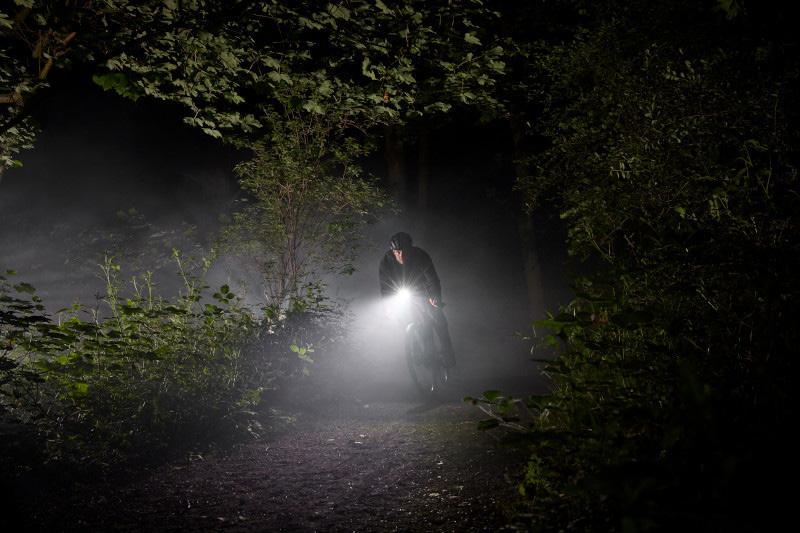
mer to school is bittersweet, even with the positive benefits of a scheduled routine, return to youth sports, and other extracurricular activities. For both students, teachers, and school staff, being indoors for 7+ hours a day is made harder when Inland NW weather is still sunny and warm. Which is why intentional efforts to spend time outside as a family are impor tant during fall.
A strategy for weekday afternoons after school is to find shared respite in nature, picnic in the park style. It doesn’t have to be complicated. Head to the nearest neighbor hood park or conservation area, a walking trail, or other urban (or near-urban) public land green space—or “blue space” with a view of water.
As for a picnic, anything works—whether leftover lunch items, to-go ice cream, fun beverages, or a home-prepared or take-out dinner before or after sports practice. Food is just the incentive for children to go along, especially for adolescents. Whether you sit or walk, eat or talk, or just be silent with your kid and enjoy the view, it will mean a lot that you took the time to be with them. No expectations—just time to relax and rejuvenate by using the power of nature to refresh mental-emotional health.
Visiting a green or blue space, no matter how small or big, helps people feel more connected to nature. And when this happens, well-being improves, including “a type of contentment that goes beyond just feeling good and includes having meaningful purpose in life,” according to the American Psychological Association (apa.org). On sunny fall days, Vitamin D and serotonin levels will be boosted by sunlight exposure, which improves mood and focus and reduces stress, according to Mental Health America (mhanational.org).
the Sunset Hill neighborhood.
• For sunset views: High Drive Bluff on the west edge of Spokane’s South Hill.
• Historic parks with ponds: Manito Park (don’t miss the Rose Garden—blooms last until early fall); Cannon Hill Park.

• Mirabeau Point Park (Spokane Valley): The trail to Mirabeau Springs with a waterfall and pond; Spokane River views along the Centennial Trail.
• Spokane River views in Post Falls-Coeur d’Alene: McGuire Park, Falls Park, Black Bay Park, and Johnson Mill River Park. //

23 SEPTEMBER-OCTOBER 2023 / OUTTHEREOUTDOORS.COM
Amy McCaffree is a longtime Out There contributor and writes the Out There Kids column for each issue.
ALL LIGHTS in stock 20 % off Through october All lights in stock 20% o thru October Let there be light....
AFTER SCHOOL EXPLORING. // PHOTO: CAROL CORBIN
The Evolution of Overlanding
By Noah Botnick
OVERLANDING IS THE ART of self-reliant motoring through remote destinations that often includes slow travel, sideexcursions, and camping. In a world where speed and efficiency dominate, overlanding offers a refreshing escape. The buzz of adventure, the allure of the unknown, and the call of the open road beckons those seeking to disconnect from the chaos of modern life.
Overlanding, and the gear and often modified vehicles that make it possible, has exploded in popularity in recent years. Hitting the roads less traveled has captivated the hearts of outdoor enthusiasts yearning for a unique and immersive backcountry experience. The term ‘overlanding’ likely originated in Australia and differs from the car-camping many backroad travelers have been enjoying for decades in that overlanding is less about the destination and more about the journey.
To better understand overlanding’s appeal, I turned to Spokane-area native Luke Shuman, who has years of personal and business experience with the vehicles and equipment at the heart of it all. Shuman's insights get at the essence of the overlanding lifestyle, which is based on independence and the freedom to explore.
Shuman is the 38-year-old owner of Hazzard FabWorx, a vehicle installation
and fabrication shop located on Trent Avenue in Spokane. At the age of 23, he was working for a small off-road shop when he saw a gap in the local off-road industry. There weren’t any shops out there with the knowledge of fabrication and suspension design for customers who wanted more than just bolt-on parts, he says.
In 2008, he started Hazzard FabWorx in his two-car garage. After a couple of years, and many high-end Ultra 4 race car builds and hundreds of truck builds, he was selected to build the flagship Jeep to lead the 2012 Ultimate Adventure, a seven-day offroad excursion on some of the hardest trails and roads in the U.S. That honor, on top of 10 years of experience, gained him recognition and helped the business grow into what it is today: a 20,000-foot facility with more than a dozen full-time employees that build over 60 trucks and Jeeps a month for customers all over the globe.
All of those years of servicing off-road vehicles eventually made Hazzard FabWorx a natural fit for outfitting the growing number of customers who wanted to modify their vehicles for overlanding-type outdoor experiences. Popular services Shuman and his staff offer include upgraded suspension systems, lifts, custom bumpers and tire carriers, gear and locker installation, custom metal fabrication, complete builds, and more.
Shuman contrasts overlanding with car
camping, which he describes as a rough way to go exploring by jumping in a vehicle with very little and heading into the woods to find a mountain trail and a spot to sleep in your car or tent. Overlanding, on the other hand, explains Shuman, “mixes a quick and easy camp setup with some amenities and better space efficiency to give you the perfect formula for a great backroad camping experience.”
Overlanding differs from camping in big RVs or trailers too, says Shuman, in that it relies on the simplicity of a rough-road capable small truck, Jeep, SUV, van, or other vehicle that’s set up with the right equipment to handle the elements of the unknown. And it strays from the traditional car camping in that the vehicles are built-out with comforts you typically don’t find in old-school carcamping kits.
“With the right set up these days, you can have a nice comfortable bed in a pop-up tent on the roof of your vehicle. Some pop-up tents can even add heat or AC now,” says Shuman. Other amenities that help define modern overlanding are running water to wash dishes or take a shower and a solid rack system with slide outs to hold and organize your gear that is constructed to handle the rough terrain.
When planning an overlanding outing, says Shuman, the route is the first thing he looks at, followed by identifying the goal of the trip, like visiting a certain peak or get-
ting to a trailhead to go mountain biking. Determining how long you want to be gone and the supplies you’ll need are next in the planning process, and then you can start packing it all in your overlanding rig.
Once you’re out there, admits Shuman, “there are always trails that are harder than you could imagine. That's why you want to make sure your rig is set up to handle the unknown.” Before you think about going overlanding, he says, you want to make sure your vehicle has some key elements, like a good set of tires, suspension that can handle the terrain, a heavy-duty winch, skid plates, and maybe even steel tubing surrounding the body for protection. Having a good suspension setup is key, he says. “It helps you go faster, farther and gets you to where you want to go more efficiently.”
Overlanding is a unique segment of the outdoor community and great way to explore our public lands. To see what it’s all about, reach out to Shuman and get your vehicle ready for backcountry adventure. Contact Hazzard FabWorx at Hazzardfabworx.com, at 509-995-1176, or on social media. //

Noah Botnick would rather be outdoors snowboarding, mountain biking, hiking, rock climbing, dirt biking or driving around back roads camping in the different RVs he gets to take out from R’nR RV Center as part of his job.

24 OUTTHEREOUTDOORS.COM / SEPTEMBER-OCTOBER 2023 MOTO
INTERVIEW WITH AN OVERLANDING EXPERT
OVERLANDING TAKES YOU TO THE TOP. PHOTO: KYLE MERRITT. // RIGHT: VEHICLE MODIFICATIONS CAN TAKE YOU TO NEW PLACES. PHOTO COURTESY OF HAZZARD FABWORX
Inland NW Fall Color Rides
By Aaron Theisen
IT’S A SCIENTIFICALLY PROVEN fact that fall is the best riding season. Cooler weather and perfect dirt are the payoff to a season’s worth of conditioning. But it’s the fall colors that seal the deal: the golden slopes of western larch and the yellow and orange corridors of aspen trees. Here are three fall classics that will have you skidding through leaf piles like a kid again.

BRUSH LAKE LOOP
This nearly six-mile loop north of Bonners Ferry is quite possibly the region’s best fall color ride, with larch and hardwoods providing nearly nonstop color on a trail purpose-built for bikes. The newly constructed Tungsten Mountain trail adds another 2,000 feet of climbing through noless-impressive fall foliage, with the added bonus of a spectacular view of the upper Pend Oreille River valley from near the top.
COEUR D’ALENE RIVER TRAIL
Although the lower six miles of this trail can be used as a jumping-off point for long backcountry loops in the Coeur d’Alene
Mountains, its stunning scenery warrants seeing the same view twice on an easily rewarding out-and-back. After the first 1.5 miles, the trail spends its time well above the Upper North Fork of the Coeur d’Alene River—all the better for vantage points of the larch and cottonwood in the canyon below.
BEAD LAKE
Although better known for its cedars, Bead Lake, just northwest of Newport, Wash., glows in autumn, when colorful shoreline shrubs and birch leaves contrast against the dark background of evergreens. The East Shoreline Trail traces the lake on good tread, with nearly constant views of the water. It’s nine miles out and back, with the option to make a long loop using 11 miles of forest road high above the lake.
Scan the code for more classic Inland NW fall color rides!


Gear Up for Fall Rides at Spokane Wheel Sport Locations
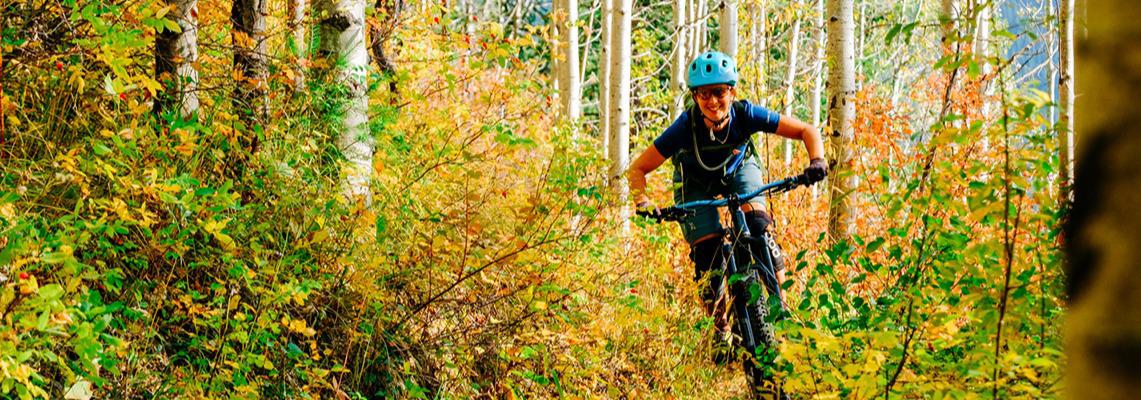
THULE EPOS BIKE RACK

Don’t waste a moment of those fleeting fall days fiddling with your bike rack. With an innovative telescoping bike attachment system and ability to accommodate long wheelbases and large tires, the Thule Epos bike rack easily transports bikes of all shapes and sizes.
45NRTH NOKKEN GLOVE
Keep the crisp autumn air from freezing your fingers with the 45NRTH Nokken glove. Wind- and water-resistant softshell material keeps digits warm without the bulk of thermal insulation, and the long cut to the wrist material closes off any jacket/glove gaps.

LIGHT AND MOTION SECA COMP 1500 HEADLIGHT
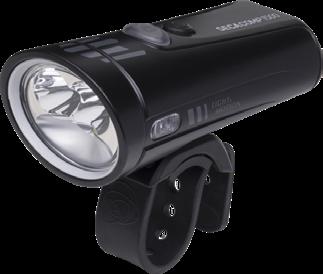
Bike lights have come a long way from the bulky battery hogs of 20 years ago. Today’s lightweight, bright, USB-rechargeable LED lights make night riding easier and safer than ever. With 1500 lumens of power, the Light and Motion Seca Comp 1500 will illuminate the entire trail, and the impact-resistant, waterproof body will ensure it holds up to whatever wild conditions autumn throws at you.
Sponsored by Wheel Sport Bicycles, Spokane’s E-bike headquarters. Check out their huge selection of e-bikes at Wheelsportbikes.com.


25 SEPTEMBER-OCTOBER 2023 / OUTTHEREOUTDOORS.COM
BIKING
North Spokane 9501 N Newport Hwy South Hill 3020 S Grand Blvd Spokane Valley 606 N Sullivan Three Spokane Locations 24HRSADAYONLINESHOPPING@WHEELSPORTBIKES.COM Scan to Shop Online Add some color to your fall rides! JERSEYS, SHORTS, GLOVES, OUTERWEAR, SOCKS, ACCESSORIES & MORE. PHOTO: AARON THEISEN
RANCHING IN THE WILD
The complex story of cattle grazing on public lands
 By Bri Loveall
By Bri Loveall
ON THE TOP OF A RIDGE NEAR the town of Republic in northeast Washington, I sat 15 feet away from a herd of wild horses. Foals nursed off their mothers. In the distance, a small group of cattle lowed, and I watched as rancher Bryan Gotham expertly navigated his horse around them, moving them onto the lower steppes of his private land in Republic, Washington. Soon, the cows would be moved to the Colville National Forest to graze on a public land allotment for the summer.
I was there to participate with the Gothams on their semi-annual cattle drive, called the round up. The Gothams have been raising cows since 1982 on both private and public land, and they’ve focused on animal and land health from the start. But public land grazing can be a contentious topic. Ungulates (hooved animals) have the power to contaminate watersheds, spread noxious weeds, destroy native vegetation, and disrupt the ecosystem. Ecological and environmental groups file lawsuits against the use of public grazing allotments while others lobby against it in government.
When we start to untangle this topic, though, there’s an unexpected pro of public land cattle grazing, at least in some places. When small ranch owners can stay in business, their deeded family homesteads, like the Gotham’s 2,200 acres in Republic, can remain wild and undivided for the benefit of wildlife.

"We need the lands connected to have a working ecosystem,” says Jay Shepherd with Conservation Northwest, an environmental organization that works to conserve local wildlife and wildlands. Habitat connectivity (a connected network of habitats that allows animals to move freely between spaces) is a cornerstone of Conservation Northwest’s mission. When private, undeveloped lands are kept intact, animals like deer, elk, grizzly bears, lynx, wolves and dozens of species of migratory birds and other wildlife are able to continue using and moving between habitat paths and corridors.
As the American West was homesteaded, rangelands were often overgrazed and mismanaged. In response to this, President Roosevelt signed the Taylor Grazing Act of 1934 to help regulate public grazing, maintain and improve soil quality, stabilize the livestock industry, and improve rangeland conditions. Currently, the U.S. Forest Service, Bureau of Land Management, and other offices oversee and manage grazing on public lands. When properly managed, public lands ranching can be done responsibly and provide the rancher the opportunity to stay in business. The Gothams are one of the single largest landowners in Ferry County, but it wasn't always that way. Over the years, the Gothams have watched their friends sell off their parcels 20 to 100 acres at a time.
For the last several decades, the Gothams have operated like this: permits are acquired from the U.S. Forest Service so that each spring cows, calves, and bulls can be moved from
26 OUTTHEREOUTDOORS.COM / SEPTEMBER-OCTOBER 2023
the Gotham’s private land in Colville to their private land in Republic, Washington. Then, before the end of June, the cows must be turned out to the designated public lands grazing allotment on the Colville National Forest where they will spend the summer grazing. (This is what the round up achieves.)
By the time I arrived for the round up, the Gothams were several days into the routine. Each morning, they saddled up horses, drank several cups of coffee as they discussed where to search for cows, then split into groups before riding for several hours. The terrain in this region is rugged. The riders urge their horses through thick brush and up steep, rocky scabs, searching for small groups of cows to move back toward the lower steppes. It’s a task that takes a lot of time in the saddle, and a lot of time is spent getting to know the contours of the land.
Everyone reconvenes at base camp (the family homestead) for lunch, discussing herd numbers while removing sweaty blankets from horses. After lunch, fresh horses are saddled and the whole process begins again. By the weekend, a majority of their 328 head of cattle will be ready to move the 18 miles to the adjacent property, where they will spend the summer grazing on their public land allotment. Of the 1.5 million acres of the Colville National Forest, the Gotham’s cows will graze on 80,000 acres of it, one of the largest single unit allotments on the forest.
If you’ve spent any time in the Colville National Forest, it’s likely you’ve seen evidence of cows moving through the land. Brandon Weinmann is the Range Program Manager with the Colville National Forest and knows firsthand the importance of sustainable land management. In 2016, he partnered with several other agencies (as well as permit-holders like the Gothams) to reconstruct several spring water development sites on Forest Service land in Northeast Washington.
Gravity springs are protected with fence and set up so small portions of water are channeled via pipes into a trough farther downstream. These sites, placed in the upland parts of the forest, help redistribute cattle and keep them away from lower-elevation spring sites and riparian areas. Weinmann reiterates that it’s important to remember that a water development site will look as though many animals have passed through it, because they have. But that doesn’t inherently mean the land is damaged.
“Grazing does cause impact, but it’s also sustainable,” Weinmann says, noting that they frequently work with specialists to evaluate land health by checking vegetative growth near spring sites. The agency is mindful of these impacts and works alongside NEPA (National Environmental Policy Act) to continually analyze the effects of grazing on public lands.
“Working ranches help maintain open space from being developed,” Weinmann says. “Grazing on public lands helps maintain these large open spaces that everyone from the public can go and enjoy.”
The Gotham’s cows winter over at their home in Colville, but cannot be turned out to their private land in Republic until late spring. That far north, the landscape doesn’t become viable for cattle (due to grass growth and the possibility of soil compaction) until the first week in May. Gotham says the cows (and horses they raise) will eat an average of 1,300 tons of hay during the winter. They are able to grow about 900 tons on their 230 acres in Colville and must supplement the rest. If their cows couldn’t graze on public allotments, the cost of supplemental food would put them out of business within months.
“In the current economy, you couldn’t afford to come out of college and start a farm,” says Gotham, adding that it’s nearly impossible to purchase land without considerable capital. As more family farms fall to developers, the landscape becomes uninhabitable to much of the natural world.
“When we start fragmenting the landscape,” Shepherd says, “we’re affecting an animal’s ability to move from point A to point B.” Dozens of animal species then become incapable of continuing normal migration patterns.
Public land grazing is perhaps an imperfect solution, as cows aren’t a native species and have caused damage to riparian areas and springs when mis-managed, but ethically-raised animals in an American foodscape that remains obsessed with beef could be a healthier way forward that works with our public lands, not against them.
While the conversation remains muddled, Shepherd says, “There’s a lot of common ground, you just have to look for it.” For the Gothams, it’s about creating a family legacy of good animal husbandry while practicing good land stewardship—a goal they share with Conservation Northwest and all who recreate on public lands.

As my time at the round up came to an end, I was left with an impression of camaraderie. During the quiet moments, everyone swapped stories about past round ups, comedic mishaps and equine behavior. I was the outsider who was asking sticky questions.
“Do you consider yourself an environmentalist?” I asked Gotham as we sat around a campfire in between rides. Gotham leaned forward, his arms covered in bruises and cuts from herding cattle out of thick brush. His shirt was ripped from an incident with a horse earlier that day.
“I think cattle ranchers and farmers were some of the first environmentalists before the term was even created,” he says. It’s about working toward a common goal of keeping small family ranches intact and the wild land, wild. //
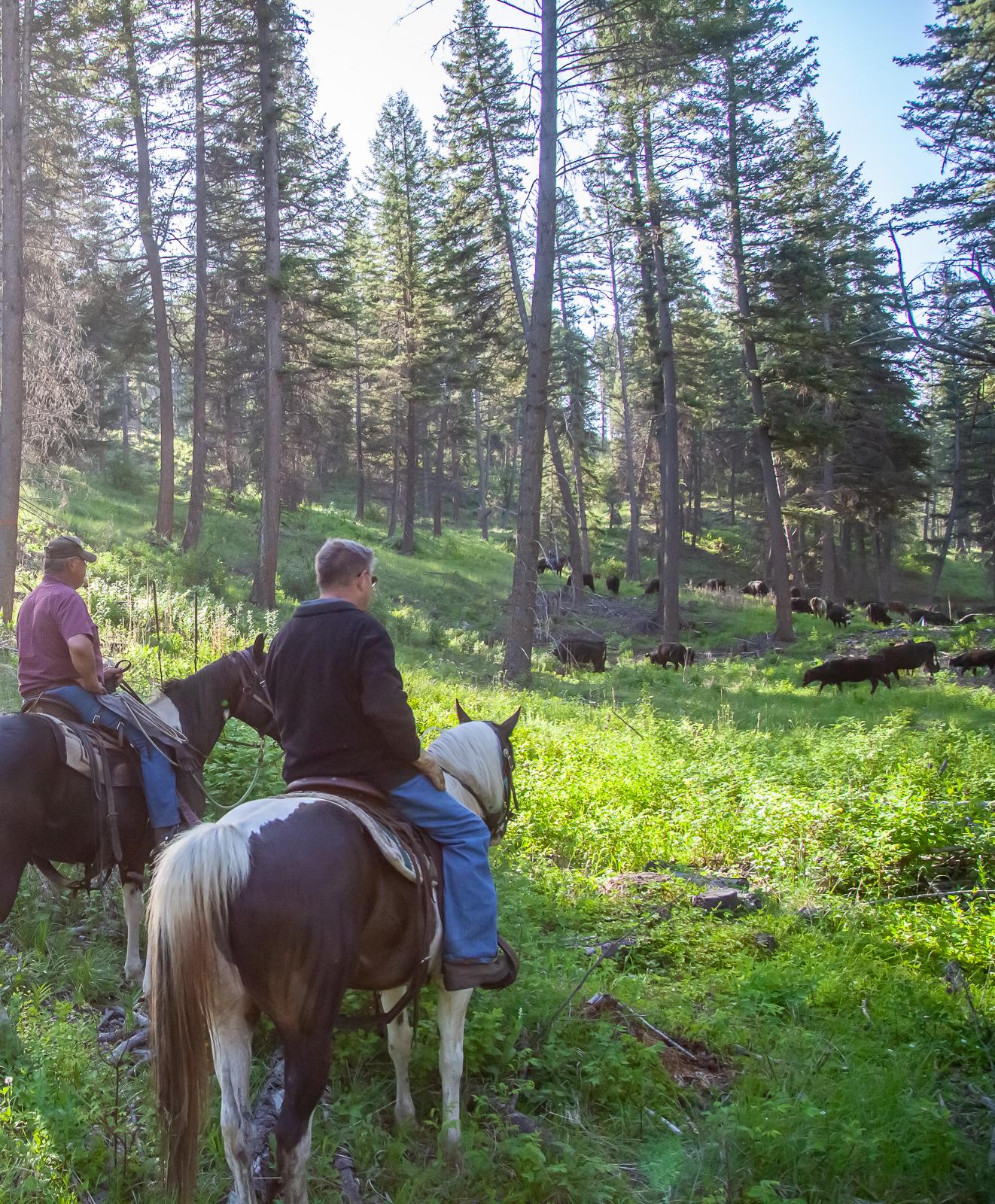

SEPTEMBER-OCTOBER 2023 / OUTTHEREOUTDOORS.COM
Bri Loveall is the Digital Editor for Out There Outdoors. When she isn't tending to her family, you can find her in the garden, begging her plants to grow.
TOP LEFT: BRYAN GOTHAM MOVING CATTLE IN REPUBLIC WASHINGTON. BOTTOM: YOUNG RIDER ROPING CALVES
DURING ROUND UP. ABOVE: BRYAN GOTHAM. BOTTOM RIGHT: BRYAN GOTHAM AND TIM LOVEALL PAUSING TO CHECK THE HERD. PHOTOS: BRI LOVEALL
THE NAMES BEFORE WE NAMED THE PLACES WE LOVE
The importance of local indigenous place names
By Bradley Bleck
LAND ACKNOWLEDGEMENTS have been de rigueur the last few years, with many organizations and events acknowledging that they are on the traditional lands of the indigenous nations that had historically inhabited that land. The Native Governance Center suggests that one way to build upon a land acknowledgment is to investigate the indigenous history of the land, to learn the place names, locations, and landmarks of indigenous significance in the area.
This is where learning about Traditional Cultural Places (TCP) comes in, as these places had names millennia before you and I came along. Confederated Tribes of the Colville Reservation Chairman Jarred-Michael Erickson says that one reason for Out There Outdoors readers and others to learn and be aware of these names is that recognizing “the traditional names gives a better understanding of the people who came before us, where we are coming from as tribal people, and to foster an appreciation of the ways of our ancestors.”
TCPs can be religious areas, resource gathering areas (plant, animal, fish and mineral), places associated with stories and legends, archaeological and ethnographic sites, habitation sites, camp sites, rock images, trails, and more. In some respects, this definition covers pretty much the whole of the Inland Northwest, if not North America and the world.
These place names are not to be confused with such acts as renaming Fort George Wright Drive as Whistalks Way. This renaming honors Whistalks, wife of Yakama Chieftain Qualchan. These re-namings matter in a different way because they carry cultural and historical connections that might otherwise be lost despite not being connected to a specific site of indigenous significance.
Probably the most visited TCP site in the Inland Northwest is Riverfront Park and the area around the Spokane Falls itself, which was the largest fishing village in the area. Commemorating that history is the “Place of Truths Plaza,” where statues of indigenous figures can be viewed netting and spearing fish alongside metal figures representing Interior Salish creation myths. But there are many more.
Not only was the area around Riverfront Park a prime fishing location, Marsha Wynecoop of the Spokane Tribe says the area hosted a gathering of the people to not just harvest and cure salmon, but engage in stick games, story telling, dancing and other social activities. Within the park is the former Canada Island, snxw meneɂ, for Salmon People. In many respects, Riverfront Park has returned the area to its original use.

Many place names and their history are in danger of being lost due to anglicized naming, while some places have been uniquely inundated behind the waters of the Grand Coulee Dam.
One such place is Kettle Falls—known to the Colville, in the English transition, as “Roaring Waters”—where the falls previously fell over 50 feet, ensuring that only the hardiest of fish made it farther upstream to spawn, strengthening the stock for future generations. This run was stopped by the construction of the Grand Coulee Dam. One legend behind Kettle Falls has Coyote bringing Salmon up the Columbia River, creating a diversion to help the fish break the blockade created in the Dalles by Seagull, Kingfish and Snipe. In the process, Coyote also created Okanagan Falls from a pile of salmon bones.

One place that has not been inundated is Palouse Falls, pelúuc. There are two legends behind the creation of the falls. One legend is that four giant brothers had run out of beaver oil, and in attempting to get more, as they fought with beaver, he thrashed about, creating the canyon walls, causing the river to bend and change. The other is that beaver was making a canyon and those living in the area wanted to stop him from doing so. A warrior went to kill beaver, and in the fighting, the canyons and falls were created.
These generally available place names and legends are not even the tip of the iceberg concerning the original names of the places we live in and enjoy in the Inland Northwest. The traditional lands of the Colville Confederation cover 39 million acres that stretched from Eastern Oregon to British Columbia. That range has been reduced to 1.4 million acres of the present reservation. There are mountains, mountain ranges, and so much more not included in current records.
One goal Chairman Erickson has is to get the Washington State Department of Transportation to put indigenous place names on road signs, an effort he hopes will soon be underway. This can help foster awareness of the history of the first people of the region, reestablishing the indigenous legacy and the long-established history of the land. “Place names are important because they show evidence that we have been here since time immemorial, that we have a connection to the place and what is in our history,” says Erickson.
Learning place names, the stories behind them, and bringing those names into current signage is a respectful first step to truly acknowledging the land upon which we live and play. //

28 OUTTHEREOUTDOORS.COM / SEPTEMBER-OCTOBER 2023
Bradley Bleck loves digging into the history of the Inland Northwest. He last wrote about Soap Lake and its healing waters for the July/August issue of OTO.
RIGHT: SALMON CAUGHT AT KETTLE FALLS. SALMON HARVESTING AT KETTLE FALLS. // PHOTOS: SPOKANE PUBLIC LIBRARY, INLAND NORTHWEST SPECIAL COLLECTIONS
Healthy salmon populations are vital to our region's ecosystems, Tribal cultures, and economy.



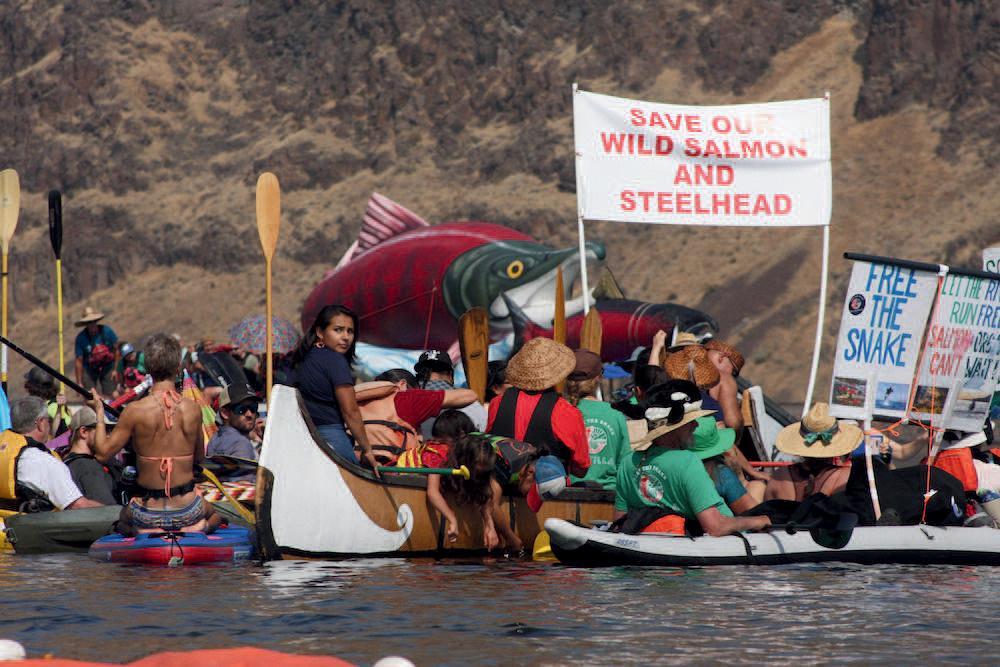
Restoring the lower Snake River will reconnect salmon to the greatest spawning habitat remaining in the continental United States. We can have a future with abundant salmon and steelhead, clean and affordable energy, modernized transportation and agricultural infrastructure, economic opportunities for everyone, and uphold treaty responsibilities to Tribal Nations. We must act now! Once salmon disappear, we cannot replace them or the many benefits they bring to our lands, waters, cultures, and wildlife.
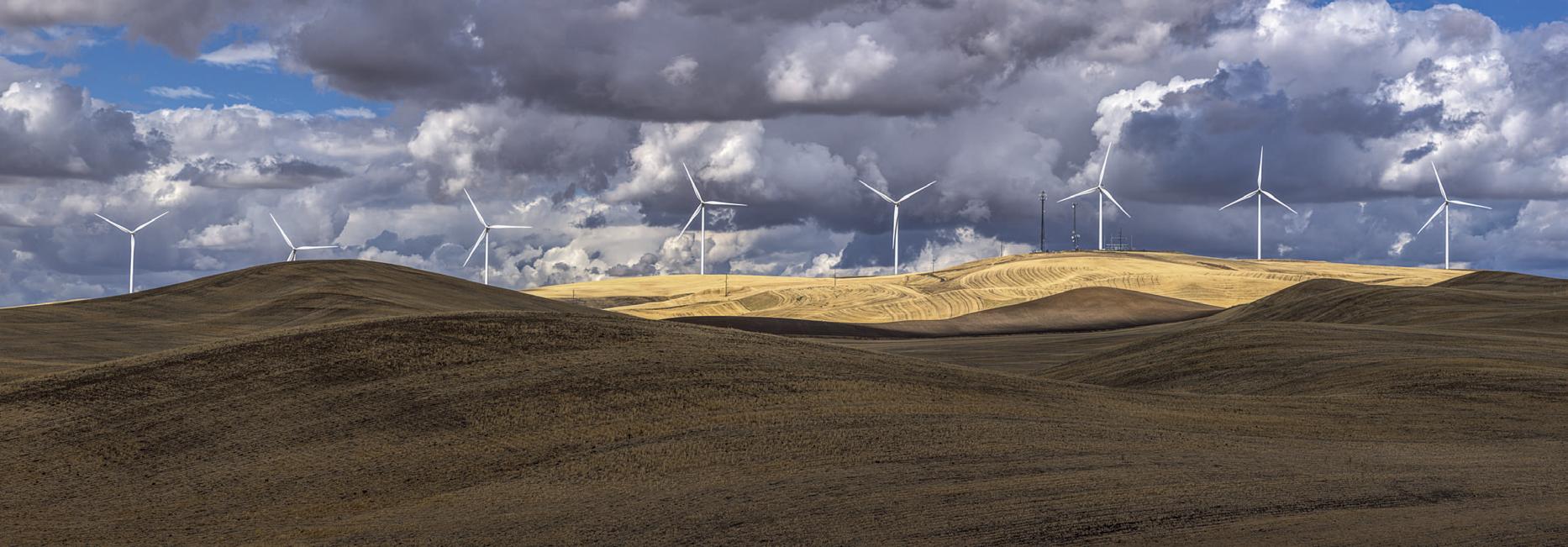

29 SEPTEMBER-OCTOBER 2023 / OUTTHEREOUTDOORS.COM
GET INVOLVED AT WWW.WILDSALMON.ORG
The time is now. Restore the lower Snake River and stop salmon extinction!
JOIN US. TAKE ACTION NOW.
WHERE DO WATERFOWL GO IN WINTER?
The Kalispel Tribe is working to track down the flyways of northeast Washington migratory birds
By Mike Lithgow
AS YOU HEAD NORTH down the Pend Oreille River in northeast Washington, you will come across a beautiful wide valley carved by ice and water. This valley contains some amazing waterfowl habitat, and the Kalispel Tribe’s Natural Resources Department (KNRD) is trying to better understand this migratory bird flyway

Wildlife Biologist TC Peterson has jumped headfirst into studying the ducks and geese of this remote corner of Washington with waterfowl banding. Bands placed on a duck’s leg are made of lightweight aluminum and have a unique number on them. If the duck is captured, killed, or found dead, the number on the band can be reported to the USGS Bird Banding Laboratory. Information regarding the location and cause of death will be documented by the USGS. This information is incredibly important in helping advance our understanding of how these migratory birds utilize the landscape.
Though this research is in its infancy, the preliminary findings are very interesting. “So far, we have learned that we likely have a large breeding population of wood ducks and that they


winter in California, mostly around Sacramento,” says Peterson. “We have also been able to learn that a large portion of the mallards winter on the Columbia near Tri-Cities and that the teal in the valley end up in Texas, but we don’t have enough bands on teal to have a good idea of what they are doing yet.”
In the future, KNRD hopes to expand the waterfowl banding program and deploy GPS trackers on species of interest to better understand the habitat use dynamics and migratory patterns during the spring migration. As this study matures, public outreach efforts will ramp up. Engaging the public through volunteer opportunities, web/social media content, and public presentations serves an important roll in building an advocacy for waterfowl and the habitat they depend upon.
If you would like to learn more about KNRD and its conservation efforts, contact mlithgow@ kalispeltribe.com or call 509-370-8794.
30 OUTTHEREOUTDOORS.COM / SEPTEMBER-OCTOBER 2023 September 23 2023 START TIMES: Start anytime between 9:00am - Noon Stations & Courses close at 2:00pm $25.00 ENTRY Fee Kids 17 & under FREE! SIGN UP & More INFO: www.riversidestateparkfoundation.org “Free Day at the Park” -No Discover Pass RequiredPRIZES for “best” and “worst” hands and drawings for prizes. Custom Pint glasses for entrants! Enter at 7 MIle Trailhead RUN-HIKE or MTN BIKE POKER A RIVERSIDE STATE PARK FOUNDATION FAMILY-FRIENDLY FUNDRAISER! LOCATION: 7 Mile Airstrip Proceeds go to RSPF to fund Riverside State Park projects. SATURDAY
PHOTOS COURTESY OF THE KALISPEL TRIBE
PUBLIC LANDS ORGANIZATIONS GUIDE 2023
There are dozens of outdoor recreation, wildlife, and land conservation organizations and public lands agencies that protect, enhance, and help manage Inland Northwest public lands. They work to protect and maintain trails and other recreation destinations, wildlife, and natural resources. Find one or more that strike a chord with you and support them and our public lands!

OUTDOOR RECREATION GROUPS
MOUNTAIN BIKE TRAIL ORGANIZATIONS
These organizations build and maintain Inland Northwest mountain bike trails with volunteers, and they advocate for mountain biking access on public lands. Help them clear some trails and dig some dirt or make a donation.
Evergreen East (Spokane, Wash.)
Evergreen Mountain Bike Alliance – Central Chapter (Central Wash.)
Evergreen Mountain Bike Alliance – Methow Chapter (Methow Valley, Wash.)
Kootenay Columbia Trail Society (Rossland, B.C.)
Lake City Trail Alliance (Coeur d’Alene, Idaho)
Moscow Area Mountain Bike Association (Moscow, Idaho)
Pend Oreille Pedalers (Sandpoint, Idaho)
HIKING/BACKCOUNTRY TRAIL GROUPS
Hiking and backcountry trail organizations help remove downed trees and maintain trails near major towns and in backcountry areas for hikers, equestrians, trail runners, and mountain bikers with a mostly volunteer work force. They are also often involved in the creation of new hiking trails. Lend a hand and give back to our trails!
Backcountry Horsemen Inland Empire Chapter (Spokane, Wash.)
Idaho Trails Association (North Idaho)
Methow Trails (Winthrop, Wash.)
Pacific Northwest Trail Association (Northeast WA / North Idaho / Western Montana)
Selway Bitterroot Frank Church Foundation (Missoula, Mont.)
Wallowa Mountains Hells Canyon Trails Association (Wallowa County, Ore.)
Washington Trails Association (Spokane, Wash.)
BIKING / WALKING PATH & RAIL TRAIL GROUPS
These organizations look after our region’s incredible, long paved pathways, gravel trails and rail trails and help raise funds for improvements, maintenance, and expansions.
Ferry County Rail Trail Partners (Malo, Wash.)
Friends of the Centennial Trail (Spokane, Wash.)
Friends of the Trail of the Coeur d’Alenes (Wallace, Idaho)
North Idaho Centennial Trail Foundation (Coeur d’Alene, Idaho)

Palouse to Cascades Trail Coalition (Spokane, Wash.)
CONSERVATION ORGANIZATIONS
LAND TRUSTS
These non-profit organizations help private landowners protect their rural farms and forests from future development with conservation easements. Some land trusts also raise funds to help purchase private land for wildlife, recreation access, and open space that they either manage themselves or transfer to public lands agencies. Support your local land trust!
Chewelah Valley Land Trust (Chewelah, Wash.)
Dishman Hills Conservancy (Spokane Valley, Wash.)
Inland Northwest Land Conservancy (Spokane, Wash.)
Kaniksu Land Trust (Sandpoint, Idaho)
Palouse Land Trust (Moscow, Idaho)
PARKS/NATURAL AREA ADVOCACY
Our city, county, and regional parks and natural areas don’t always have the funding needed to take care of all of the trail and park maintenance and programs. These organizations help fill that gap by raising funds and providing volunteer labor. Some even advocate on behalf of the parks, access, and wildlife.
Spokane Parks Foundation (Spokane, Wash.)
Friends of the Bluff (Spokane, Wash.)
Friends of the Little Pend Oreille National Wildlife Refuge (Colville, Wash.)
Friends of the Little Spokane River Valley (Spokane, Wash.)
Friends of the Pend d’Oreille Bay Trail (Sandpoint, Idaho)
Friends of Tubbs Hill (Coeur d’Alene, Idaho)
Friends of Turnbull National Wildlife Refuge (Cheney, Wash.)
Riverside State Park Foundation (Spokane, Wash.)
OUTDOOR CLUBS
These clubs don’t just climb, hike, and ride on our public lands and trails; they give back to the places where they play with hours of volunteering. Some of them provide invaluable outdoor education experiences as well.

Bower Climbing Coalition (Spokane, Wash.)
Inland Northwest Hikers
Northwest Whitewater Association (Spokane, Wash.)
Spokane Bicycle Club (Spokane, Wash.)
Spokane Mountaineers (Spokane, Wash.)
Spokane Canoe & Kayak Club (Spokane, Wash.)
SheJumps Eastern Washington & North Idaho
COLLEGE/UNIVERSITY OUTDOOR PROGRAMS
Eastern Washington University’s EPIC Adventures (Cheney, Wash.)
Gonzaga University’s Outdoor Pursuits (Spokane, Wash.)
North Idaho College Outdoor Pursuits (Coeur d’Alene, Idaho)
University of Idaho Outdoor Program (Moscow, Idaho)
Whitworth University’s Whitworth Outdoors (Spokane, Wash.)
31 SEPTEMBER-OCTOBER 2023 / OUTTHEREOUTDOORS.COM
PHOTO COURTSEY OF THE FERRY COUNTY RAIL TRAIL PARTNERS
VOLUNTEERING TO MAKE OUR REGION BETTER. // PHOTO COURTESY OF INLC
WILDLIFE/WILDLANDS/RIVER & LAKE CONSERVATION GROUPS
These non-profit organizations turn donations and volunteer time from people like you into advocacy and education for our region’s amazing public lands, wildlife, lakes and rivers. Find ones that advocate for your favorite places or critters and support them.
Spokane Audubon Society (Spokane, Wash.)
Mission: Advocate for birds and their habitats in the Inland Northwest and connect people with nature.
Conservation Northwest (staff across Washington)
Mission: Connect the big landscapes, restore iconic wildlife, and protect our natural heritage for future generations, from the Washington Coast to the British Columbia Rockies.
Friends of the Clearwater (Moscow, Idaho)
Mission: Protect the public wildlands and rivers in the Clearwater Basin of North Central Idaho through grassroots organizing, education, advocacy, and litigation.
Friends of Scotchman Peaks Wilderness (Sandpoint, Idaho)
Mission: To make sure the rugged Scotchman Peaks roadless lands along the IdahoMontana border are kept wild forever.
Greater Hells Canyon Council (La Grande, Ore.)
Mission: To connect, protect, and restore the wild lands, waters, native species, and habitats of the Greater Hells Canyon Region.
Idaho Conservation League (Sandpoint, Idaho)
Mission: To create pragmatic, enduring solutions that protect and restore Idaho’s air, water, land, and wildlife.
Idaho Rivers United (Boise, Idaho)
Mission: To protect and restore the rivers of Idaho.
Kettle Range Conservation Group (Republic, Wash.)
Mission: To defend wilderness, protect biodiversity, and restore ecosystems of the Columbia River Basin.
Kootenai Environmental Alliance (Coeur d’Alene, Idaho)
Mission: To conserve, protect and restore the environment of the Idaho Panhandle and the Coeur d’Alene basin.

Nimiipuu Protecting the Environment (Lapwai, Idaho)
Mission: To facilitate and organize tribal youth and adults in activities for the protection, enhancement, and promotion of mother earth and the Nimiipuu culture.
Okanogan Highlands Alliance (Tonasket, Wash.)
Mission: Encourage and support education and public participation in decisions involving our community and environment.
Rock Creek Alliance (Sandpoint, Idaho)
Mission: To protect the water quality of the Clark Fork-Pend Oreille Watershed, and to protect the Cabinet Mountains Wilderness Area from the proposed Rock Creek Mine.
Save Our Wild Salmon (Spokane, Wash.)
Mission: To protect and restore abundant, self-sustaining fishable populations of salmon and steelhead to the Columbia-Snake River Basin for the benefit of people and ecosystems.
Selkirk Conservation Alliance (Priest River, Idaho)
Mission: Engage the public in southern Selkirk resource and land management issues through cooperation, scientific inquiry, education, and economic diversity.
Spokane Falls Trout Unlimited (Spokane, Wash.)
Mission: To fix rivers and streams, bring people together, and make waters and communities more resilient to the effects of climate change.
Spokane River Forum (Spokane, Wash.)
Mission: To create materials, events and activities that promote regional dialogues for sustaining a healthy river system while meeting the needs of a growing population.
Spokane Riverkeeper (Spokane, Wash.)
Mission: To protect the river’s ecological health, vibrancy, and aesthetic integrity, as well as the healthy connections that communities have to the river now and into the future.
The Lands Council (Spokane, Wash.)
Mission: To preserve and revitalize Inland Northwest forests, water, and wildlife through advocacy, education, effective action, and community engagement.
Washington Native Plant Society (Eastern Washington Chapter)
Mission: To promote the appreciation and conservation of Washington's native plants and their habitats through study, education, and advocacy.
HUNTING & FISHING WILDLIFE CONSERVATION GROUPS
These conservation organizations, largely made up of hunters and anglers, have an active presence in the Inland Northwest. All help with fish and wildlife habitat conservation projects on the ground and advocate on behalf of public lands, wildlife, and responsible hunting and fishing policy.

Backcountry Hunters & Anglers (state chapters and active local members throughout the Inland NW)
Inland Empire Fly Fishing Club (Spokane, Wash.)
Inland NW Wildlife Council (Spokane, Wash.)
Rocky Mountain Elk Foundation (nation-wide with local fundraisers and habitat projects) Spokane Fly Fishers (Spokane, Wash.)
SO, WHOSE LAND IS IT?
It can be super confusing to answer that question when you’re out there trying to explore your public lands. Fortunately, there are a few good websites and apps to help navigate this question:
o In Idaho: Parksandrecreation.idaho.gov/motorized-trails
o In Washington: Rco.wa.gov/reports-and-studies/public-land-inventory
o In Oregon, state-owned only: Oregon.gov/dsl/land/pages/sli.aspx
o In Canada: Thecanadianencyclopedia.ca/en/article/national-parks-of-canada-interactive-map
o CalTopo has both web-based maps and a free version of its app that show a public land layer (with color coding, but lacking details).
o Gaia also has web-based maps and an app, but requires a subscription to access the public land layers (as well as the private lands layer, which is helpful for accessing private land that is open to the public).
o OnX also offers a subscription plan for both public and private land layers on its app.
o Topo Maps+ is a Spokane-based navigation and trip planning app for hikers, hunters, skiers and snowshoers, and cyclists that has public lands layers. (Holly Weiler)
Editor’s note: To be a part of the 2024 Out There Outdoors Public Lands issue, contact us at derrick@outtheremonthly.com
32 OUTTHEREOUTDOORS.COM / SEPTEMBER-OCTOBER 2023
BACKCOUNTRY HUNTING IN THE COLVILLE NATIONAL FOREST. // PHOTO: DERRICK KNOWLES
A QUICK AND DIRTY GUIDE TO YOUR PUBLIC LANDS
Which passes you'll need and what activities you can do on different lands
By Holly Weiler
For anyone who has ever been a bit confused by the breakdown of various land managers, which recreation pass is required where, and what activities are generally allowed, this guide will serve as a handy reference and starting point to explore your public lands! Always do your own research for specific locations, as rules may vary from park to park, and even from one season to the next. This reference is divided into categories of local, state, and national public lands.
LOCAL PARK & CONSERVATION LANDS

Local parks and conservation areas are the first category of public lands, generally managed by either cities or counties. They tend to have the most restrictive use rules, generally with specific open hours, but also frequently offer amenities. Most (but not all) do not allow camping as a permitted use. Most are fee-free too. Examples include Camp Sekani Park managed by the City of Spokane and Antione Peak Conservation Area managed by Spokane County.
STATE LANDS
State-owned lands are the second bucket of public lands. They additionally fall into different categories of state land. These lands frequently require an access fee. Non-motorized recreation is a major aspect of what state parks provide to the public, and these parks typically offer developed trail systems. Many provide fee-based developed camping, at least seasonally. Hunting is typically not allowed. Local examples are Riverside State Park in Spokane and Farragut State Park near Sandpoint.
State wildlife management agency lands, like the Sherman Creek Wildlife Area in Northeast Wash., are also state-managed lands, but with an emphasis on wildlife habitat and with hunting and fishing being the main forms of recreation. Other forms of non-motorized recreation are generally permitted, although there may be seasonal closures to protect wildlife. Dispersed camping is frequently allowed.
Department of Natural Resources lands are state-managed lands that have an emphasis on timber harvest, generally to provide funding for schools. Recreation is typically permitted, although not all DNR lands will have developed trail systems and there may be closures due to timber harvests. Hunting is typically allowed, and dispersed camping is frequently permitted.
In Washington, a Discover Pass ($30 annually/$10 daily) is required on state-owned lands. In both Idaho and Montana, the fee is different for in-state versus out-of-state visitors. In Oregon, passes are $5/day, $30/year, or $50/2 years.


FEDERAL LANDS
Federally-owned lands are the last category, and vary widely in what is allowed. Many offer both motorized and non-motorized recreation. Most allow hunting (although not in national parks) and either developed or dispersed camping. These include United States Forest Service Lands like the Idaho Panhandle National Forest, Bureau of Land Management lands like the Juniper Dunes Wilderness in eastern Wash., National Parks (both U.S. and Canada) such as Glacier National Park, and National Wildlife Refuges like Turnbull west of Spokane.
Fees are frequently required on federally owned lands, but the fee structure varies among different types of federal ownership. National Parks generally require daily entrance fees (or an America the Beautiful pass in the U.S.) and backpacking generally requires a permit. USFS lands sometimes have site-specific fees (frequently covered by an annual NW Forest Pass) but also have numerous dispersed camping areas that are fee-free. BLM and Wildlife Refuges are generally fee-free. BLM typically allows dispersed camping.

33 SEPTEMBER-OCTOBER 2023 / OUTTHEREOUTDOORS.COM
CHEWELAH’S NEW GOLD HILL TRAILS
The improbable story behind the Gold Hill Community Forest
 By Derrick Knowles
By Derrick Knowles
BACK IN 2017, Jake Wilson, co-owner of Quartzite Brewing in Chewelah, Wash., got tired of just wishing there were singletrack mountain biking trails nearby and instead started figuring out how to make it a reality. Wilson began meeting with other locals who shared his vision and they formed the Chewelah Valley Land Trust (CVLT) with the lofty goal of raising nearly a million dollars to buy 408 acres of timberland just five miles out of town. The land trust applied for two grants to purchase the property not long before the pandemic hit. Fortuitously, their requests for $300,000 from the Forest Service Community Forest Program and another $675,000 from the Recreation Conservation Office Community Forest Program were granted. Not long after that, the land trust purchased the property that became the Gold Hill Community Forest.


Wilson and his fellow CVLT board members soon set out to start building the biking and hiking trails that had inspired the whole enterprise in the first place. “We got a grant from Evergreen Mountain Bike Alliance’s Give Big program for $7,000 to cover excavation rentals for trail building,” explains Wilson. “For the first trail we hired a contractor to build the climbing trail and the rest of the funding was used for renting the heavy equipment to build the new flow trail.” Wilson says CVLT was lucky to have volunteers who were experienced in running the equipment, and they were able to make the
money go a long way. “We got a lot of new trails built out of that grant funding from Evergreen.”

This fall, mountain bikers, trail runners, and hikers can head up to the Gold Hill Community Forest and explore 15 miles of trails that include several new singletrack trails and old, closed logging road double track. From the gravel parking lot, the Easy Upsy Daisy climbing trail gains around 400 feet of elevation and is the starting point for your choice of three great mountain bike descents: the fast and fun Balsamroot Bomber flow trail with plenty of berms; the M.U.S.T Trail, a cross-country descent with an old school feel; or the Ponderosa Trail, a memorable ride with awesome views up top and big, swooping turns through a gully near the bottom. All of the trails, with the exception of the downhill-only flow trail, are open to hikers going either direction. There’s also a short, kids’ mountain bike practice loop just below the parking lot.
It's pretty amazing what CVLT has been able to accomplish in just five years, and board members and volunteers have even more plans to improve the property. The group has several projects in their sights, including parking lot and trailhead improvements, an eventual restroom facility, an extension of the Ponderosa Trail, a skills park near the top of the trail system, and other trails and connectors in the coming years. Learn more or get involved by visiting Chewelahvalleylandtrust.com.
34 OUTTHEREOUTDOORS.COM / SEPTEMBER-OCTOBER 2023
CELEBRATING NEW TRAILS. // PHOTO COURTESY OF CHEWELAH VALLEY LAND TRUST
Climate Change
BACK TO LOCAL WATERS
FOR MILLENNIA, seasons in the Inland Northwest were marked by salmon moving through our waterways and creating symbiotic and sustaining relationships with the local ecosystem. A keystone species for the INW, salmon have been cut off from some of their historic habitat in the Upper Columbia Basin for more than 100 years. But the Upper Columbia United Tribes hopes to change that in the coming decades. They are in the midst of a 20-year plan to bring the salmon home and provide healing for lands, waters, and people long bereft of their presence.
This collaborative effort has received substantial support from a wide breadth of stakeholders, including state and federal legislators. Inland Northwest Land Conservancy (INLC) has been thrilled to support these efforts in direct partnership with the Spokane Tribe of Indians by protecting land along the Little Spokane River. In 2021, Spokane Tribal Fisheries released 50 Chinook salmon into the Little Spokane River at Waikiki Springs Nature Preserve—owned and managed by INLC since 2020.

This August, the Tribe released another 50 salmon into the Little Spokane River at Glen Tana Farm, another active project area of INLC. The permanent protection of lands and waters where our community can experience and fall in love with the natural world is at the core of INLC’s mission to conserve, care for, and connect with lands and waters essential to life in the Inland Northwest. Learn more about our work at InlandNWLand.org. (Carol Corbin)


Polluters
Urban Pressure
November 16th
Montvale Event Center
5:30 pm to 8:00 pm
Enjoy: Food, Beverages, Friends
Engage: Authors, Speakers, Films
Make an impact for your river!



SPOKEN RIVER : 2023
Join

YOUR PHOTOS OF EASTERN WASHINGTON CAN WIN PRIZES AND MAKE A DIFFERENCE



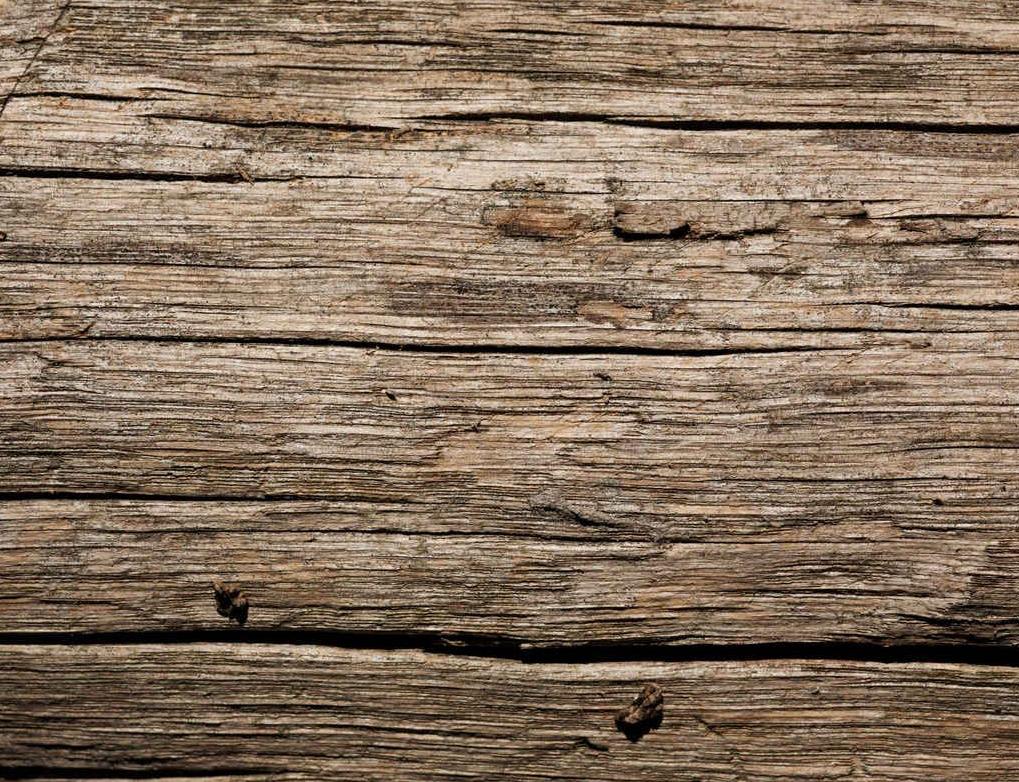
Do you have a favorite photo from an outdoor adventure? Submit it to Washington Trails Association’s annual photo contest, Northwest Exposure.
Whether you’re a pro, a hobbyist or enjoy capturing beautiful moments on your phone, you can win prizes and get featured in WTA’s calendar, magazine and social media.
Northwest Exposure’s 2023 bonus category, East of the Cascades, welcomes unlimited entries featuring the varied landscapes of Eastern Washington. WTA also invites submissions to recurring categories featuring trailscapes, hikers, animals and plants.
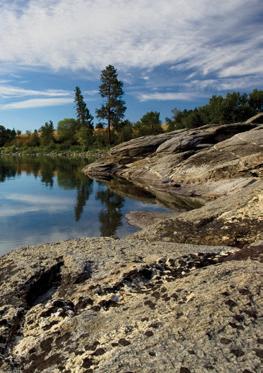


WTA is a nonprofit on a mission to ensure everyone has access to trails. Your photos enable the organization to tell visually compelling stories that inspire stewardship for the outdoors.
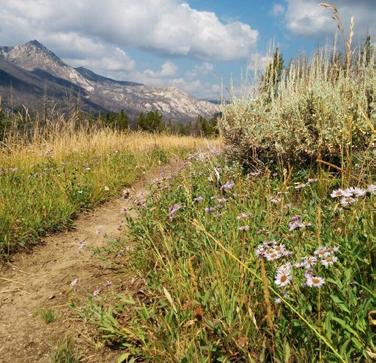
Enter your photos by October 17 to share the wild places you love. (OTO)
It’s

35 SEPTEMBER-OCTOBER 2023 / OUTTHEREOUTDOORS.COM
HOLLY WEILER HOLLY WEILER LOREN DRUMMOND TIFFANY CHOU
PHOTO: TODD DUNFIELD. s p o k ane RI V ERKEE PE R
BRINGING SALMON
www.spokenriver.com
us for this inspiring literary event and benefit for your Spokane Riverkeeper. Your support helps us make our Spokane River more resilient.
Your River, We Protect It.
IT’S TIME TO BRING THE SALMON HOME TO A RESTORED LOWER SNAKE RIVER
Guest Editorial
By Tanya Riordan
NOT LONG AGO, the Columbia-Snake River Basin was the most prolific salmon-producing landscape in the continental United States. Dozens of populations across this great basin, however, have been driven to extinction. Today in the Snake River, the Columbia River's largest tributary, less than 1% of the historic keystone species—salmon and steelhead— return each year to spawn.
Pacific Northwest Tribes have honored their relationship with salmon and its role as a keystone, connective, and indicator species since time immemorial. We must now uphold our nation’s treaty responsibilities to protect and restore this irreplaceable fish.

The importance of salmon across the Pacific Northwest goes well beyond the availability of a beautiful fish for us to catch and consume. Salmon are a profound part of tribal cultures, and they transfer vital nutrients from the ocean to rivers, streams, forests, plants and wildlife, providing irreplaceable nutrients to our ecosystem. When salmon teeter on the edge of extinction, the health of ecosystems across the region also hang in the balance.
A freely flowing lower Snake River once connected over 5,500 miles of pristine, cold, freshwater spawning habitat. Now, salmon are struggling to survive primarily due to multiple harmful effects caused by lower Snake River dams and the dangerously high temperatures in their large, stagnant reservoirs.

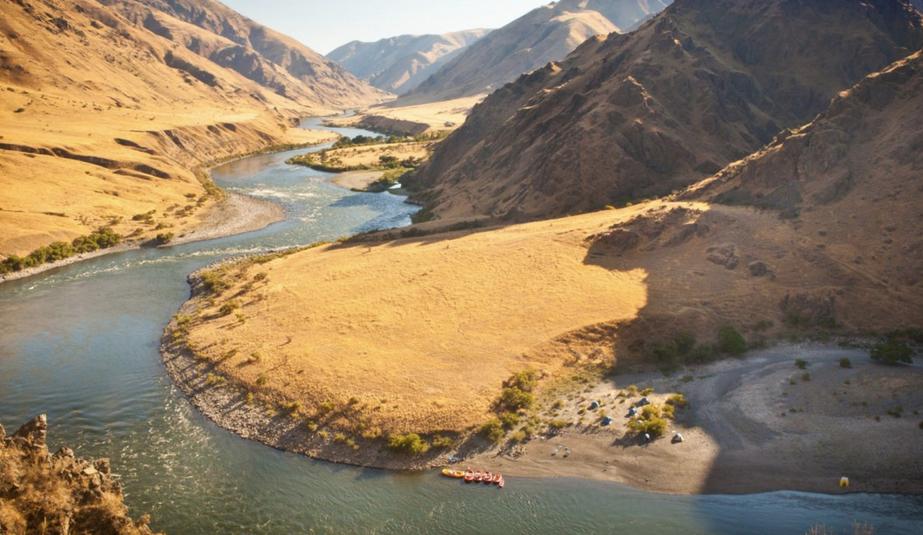
Despite spending $26 billion on mitigation efforts, we’ve failed to recover even one of the 13 populations teetering on the edge of extinction today. This year, summer steelhead are returning at the lowest level in history.
Decades of scientific and economic analyses are clear: stopping the extinction of salmon, steelhead, and the southern resident orcas that depend on Snake River Chinook as their primary food source requires restoring the lower Snake River. We must urge policy makers to break free from a failed and costly status quo and work together to address large scale issues such as climate change. This is a once-in-a-lifetime opportunity to achieve the largest river restoration in history.

Is it possible? For salmon to survive and for our ecosystems to be healthy, we need to come together around urgent and shared solutions. We can effectively replace the limited transportation, energy, and irrigation services of the four lower Snake River dams with reliable, affordable, modernized systems. We can do this for the lower Snake River and its salmon, but it will require all of us working together.
Once salmon disappear, we cannot replace them or the benefits they provide to our land, waters, cultures, and life. To work together to bring the salmon home, honor our nation’s treaty responsibilities to Tribes, and ensure a healthy ecosystem for our children and theirs, get involved with Save Our wild Salmon at Wildsalmon.org.

36 OUTTHEREOUTDOORS.COM / SEPTEMBER-OCTOBER 2023
SALE & SALE & SALE & SWAP SWAP
&
OUTDOOR EQUIPMENT OUTDOOR EQUIPMENT Thursday, November 9 6 - 8 p.m. A d m i s s i o n : $10 to sell your gear Set up starts at 5 p m $5/person from 6 - 6:30 p m $1/person from 6:30 - 7 p m Free after 7 p m UI Students and children under 12, always free Event located in the Student Rec Center at 1000 Paradise Creek Street For more information visit: uidaho edu/outdoorprograms I @ui outdoorprograms
Tanya Riordan is the Policy and Advocacy Director for the Save Our Wild Salmon Coalition.
SALE
SWAP
FREE FLOWING SNAKE RIVER // RIGHT: SOCKEYE SALMON // BELOW: FREE THE SNAKE FLOTILLA PHOTOS COURTESY OF SAVE OUR WILD SALMON COALITION
PUBLIC LANDS ARE SOURCES of clean air and water for all of us. These large tracts of healthy land provide habitat for wildlife, a place to reconnect with family and friends, and increase physical and mental health. Public lands are so woven into the fabric of American culture that it might be easy to disregard these places or think that they will always be accessible, when, in fact, many of these places exist today due to the extraordinary leadership of local conservation activists and advocacy groups.

In the Inland Northwest, we are lucky to have regionally-focused, longstanding non-profit groups that work directly to protect the places we love. Behind these organizations stand dedicated individuals who drive their missions forward. Run by a small but highly motivated staff, one such organization, The Lands Council (TLC), exemplifies the power of passion and work ethic that our regional conservation non-profits embody. For nearly four decades, TLC has been at the forefront of protecting our beloved public lands through conservation


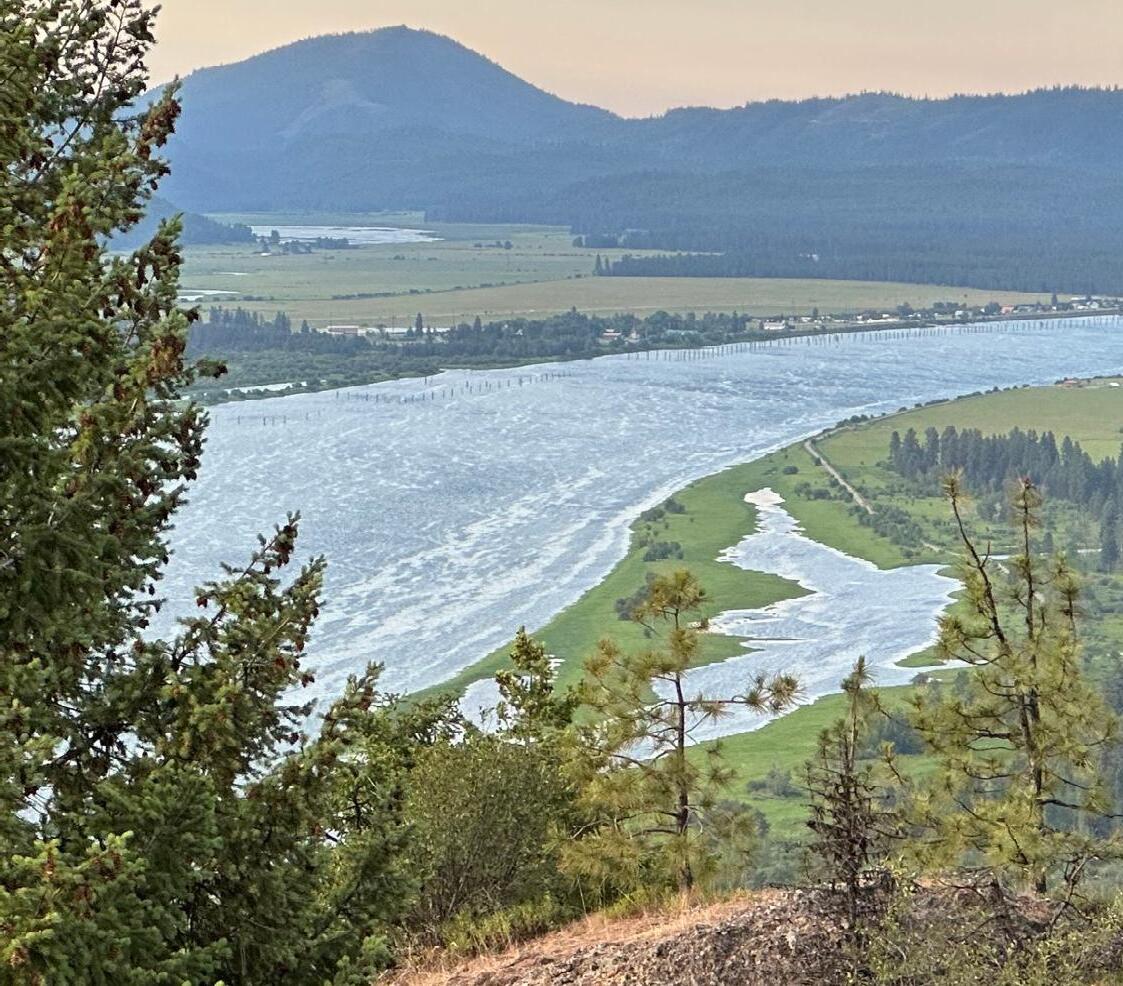
The Lands Council
and education programs.
Regional nonprofits play a pivotal role in safeguarding public lands, which encompass vast expanses of forests, wetlands, mountains, and more. Organizations like TLC act as a conduit for government agencies and distill the complex nature of public lands management for greater public engagement. TLC has responded to public lands challenges by initiating collaborative efforts in our region and becoming an active member of the Northeast Washington Forest Coalition. Working with timber companies, county commissioners, recreationists, and rural leaders, they have started to find common ground on managing our public lands. The results are better restoration projects, increased forest health, protection of large fire-tolerant trees, and support for permanent protection of the most pristine parts of the forests. TLC is also working to keep public lands open to all citizens and not turn them over to private ownership. They work with elected officials to increase funding for public lands and increase the pace of forest restoration.
While public lands advocacy is a cornerstone of TLC’s efforts, they also serve our community with public education and outdoor experiential learning. By fostering awareness and a sense of responsibility towards public lands, they inspire individuals to take ownership of their surroundings. Educational programs at TLC offer a deeper understanding of the connections between ecosystems, wildlife, and human activities. This knowledge helps people make informed choices to positively impact the environment.
Supporting regional nonprofits like TLC is not just an option; it is a necessity to preserve our public lands. The reach and scope of regional nonprofit work like that done by TLC is significantly amplified by community support. Nonprofits are often hampered by capacity, be it financial or feet-on-the-ground help with their work. Without financial contributions and volunteer support, the ability to drive change diminishes. Public lands are a shared resource and safeguarding them requires collective action—one that you can participate in today.
To get involved, financially support our work, and learn more about The Lands Council, visit Landscouncil.org. (OTO)


37 SEPTEMBER-OCTOBER 2023 / OUTTHEREOUTDOORS.COM
NON-PROFIT SPOTLIGHT
Escape to the great outdoors with all the comforts of home at Kalispel RV Resort. Enjoy your stay in a premium RV site or cozy cottage, then find gaming excitement at Kalispel Casino, dining at Wetlands, adventure on the International Selkirk Loop, and more right next door. kalispelrvresort.com | 370 Qlispe River Way | Cusick, WA Come for the scenery. stay for the amenities.
LANDS COUNCIL CREW IN THE FIELD. // PHOTO COURTESY OF TLC
THE
YOUR FALL ROAD TRIP DESTINATION KALISPELL, MONTANA
IF THERE’S ONE THING WE KNOW in the Northwest, it’s that fall is the prime time to set out on a long weekend road trip. With colorful foliage, pleasant daytime and crisp evening temperatures, and fewer people exploring our highways and byways, fall was made for road trips. And Kalispell, Mont., is an easy, scenic road trip destination.
A four-hour drive from Spokane, Kalispell is the hub of northwest Montana and sits in a lush valley surrounded by the Rocky Mountains. Although it’s technically the largest city in the area, Kalispell remains a mountain town that’s well-versed in combining easily accessible outdoor adventures with a vibrant downtown, charming shops, local restaurants, arts and culture, and watering holes. It has abundant amenities you’d expect to find in a larger community, and it’s within easy reach of Flathead Lake, Glacier National Park and the Flathead National Forest.
If you’re ready to soak up autumn close to home, here are five ways to make the most of your fall road trip to Kalispell.

VISIT GLACIER NATIONAL PARK.
Fall may be the park’s loveliest season, with oranges, yellows and reds covering the landscape as snow starts to dust the area’s highest peaks. While there are fewer visitors during this time of year, it’s still easy to hit the trails, drive the Going-to-the-Sun Road (which typically closes mid- to lateOctober) or set out on a guided tour or activity in and around the park. Plus, start-
ing September 11, no vehicle reservations are needed for any of the park’s entrances, meaning you can visit any time of day.
SPEND TIME DOWNTOWN.
The heartbeat of Kalispell is its downtown. While you’ll find historic buildings lining Main Street, don’t let that fool you into thinking its out of date. Downtown is a hopping neighborhood with unique shops, stores, restaurants, watering holes, coffee shops and museums. The best way to explore it is to take your time and stroll along its streets and avenues. After shopping (with no sales tax), be sure to learn more about the history of the area with a stop by the Conrad Mansion Museum, Northwest Montana History Museum, and the Hockaday Museum of Art. If you want to catch a performance or concert, make the quick drive to the new Wachholz College Center at Flathead Valley Community College.
FISH, KAYAK OR CRUISE.
The largest natural freshwater lake in the West, Flathead Lake is gorgeous in fall. As part of your road trip, plan to cruise the loop around the lake on U.S. Highway 93 or Highway 35, taking in the changing landscape along the way. If you’re ready to get out on the water, set out on a guided kayaking tour with Sea Me Paddle or take a boat tour (or guided fishing trip) to Wild Horse Island with Howe’s Fishing. Scenic floats and fly-fishing trips are also
available on nearby rivers, while you can enjoy the waters of Lake McDonald on a historic wooden boat with Glacier Park Boat Company.
TASTE MONTANA.
A big part of any trip is the food, and Kalispell is no exception for great eats. From farm-to-table restaurants to cideries, light bites, and steakhouses, there are many options to experience the flavors of northwest Montana. Rub elbows with the locals by snagging a burger or huckleberry shake at Norm’s News, sipping on a made-inKalispell brew at Bias Brewing, or digging into a perfectly-cooked steak at Mercantile Steakhouse.
HIKE TO YOUR HEART’S CONTENT.
With its location in northwest Montana, Kalispell has a range of trails from easy, in-town routes to more technical trails that weave through nearby mountain ranges. In town, you can walk or ride the Parkline Trail, Great Northern Rail Trail, or the
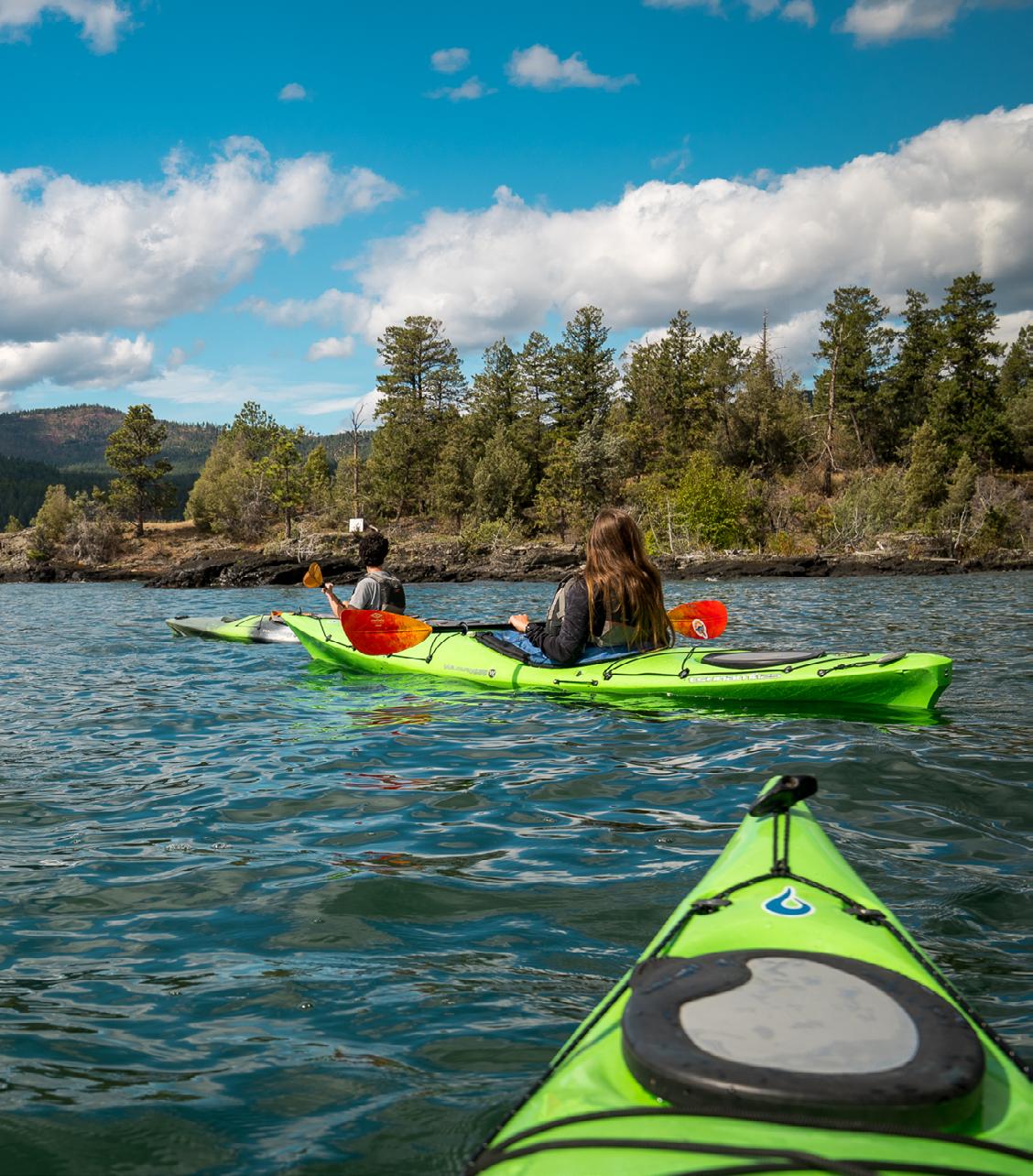

trail system at Lone Pine State Park. If you’re looking for views or higher-elevation options, head to Jewel Basin, Foy’s to Blacktail Trail at Herron Park, or Glacier National Park. Want to go with a guide?
Check out the offerings from Glacier Guides or Glacier Institute.
There are also plenty of places to hang your hat during your visit. Experience the vibrancy of downtown by staying at the Kalispell Grand Hotel or Sherman Lodge. Earn points while you vacation with a stay at Red Lion Hotel Kalispell, Springhill Suites by Marriott Kalispell, My Place Hotel or Best Western Plus Flathead Lake Inn and Suites, to name a few. If you’re bringing the camper or RV over, enjoy the 50 acres at Montana Basecamp RV Park. No matter where you stay, Kalispell will get you great access to fall outdoor adventure.
For the full list of lodging properties and to start planning your trip, visit Discoverkalispell.com. (Provided by Discover Kalispell)
38 OUTTHEREOUTDOORS.COM / SEPTEMBER-OCTOBER 2023
PHOTOS COURTESY OF DESTINATION KALLISPELL
A CHARMING MOUNTAIN TOWN FOUR HOURS FROM SPOKANE

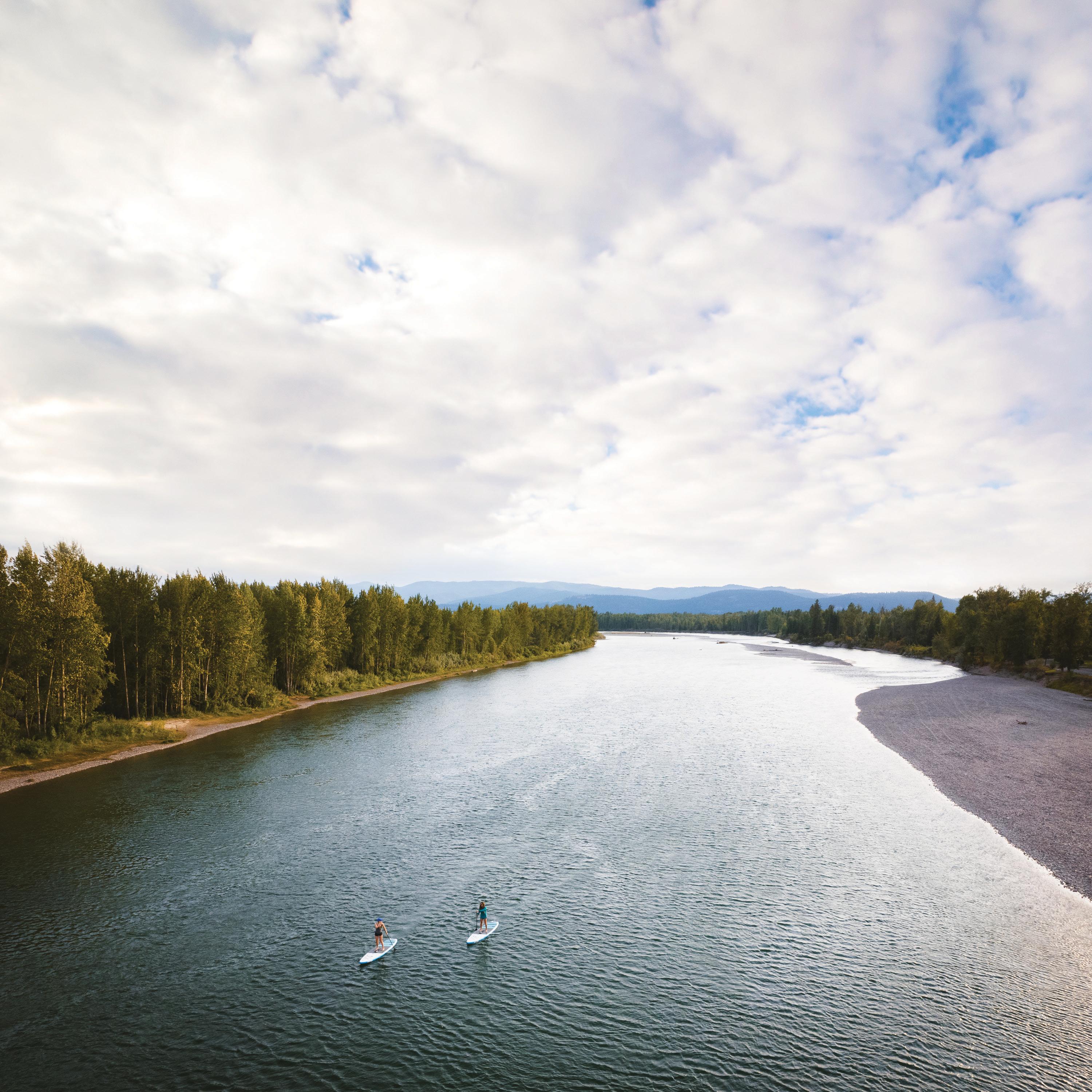


 Be Our Guest:
Paddleboarding on Flathead River, Kalispell, MT
Be Our Guest:
Paddleboarding on Flathead River, Kalispell, MT

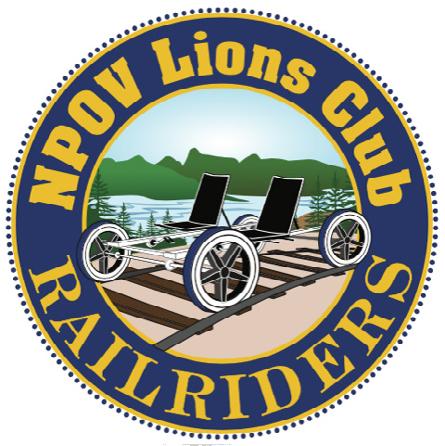





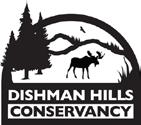
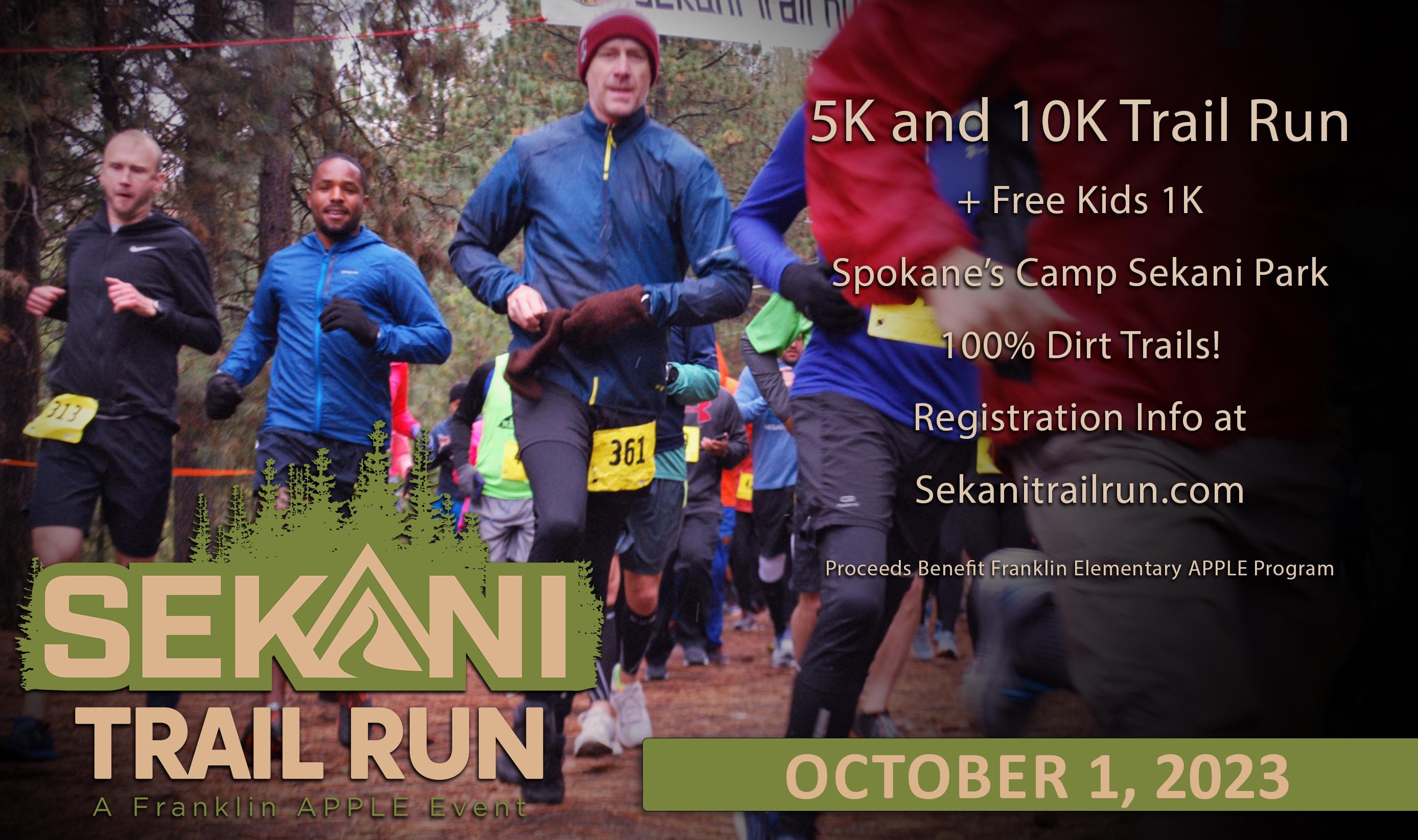
40 OUTTHEREOUTDOORS.COM / SEPTEMBER-OCTOBER 2023 2023 NPOV LIONS RAILRIDERS AUTUMN RIDES September 16 & 17 September 30 & Oct 1 October 7 & 8 Sat & Sun 9 am & 12 pm Ride the Rails in Northeast Washington Rain or Shine...Bring Weather Appropriate Attire reservations recomended LionsRailRiders.com / 844.724.5743 Dishman Hills Conservancy Fundraiser O c t o b e r 1 6 t h , 2 0 2 3 5 : 3 0 - 8 : 3 0 p m Buy Your Ticket Today! $125 www.dishmanhills.org/events A u c t i o n a n d D i n n e r
RIDE THE IDAHO PANHANDLE
EXPLORE ALL SIX OF THE TRAILS OF THE COEUR
D’ALENES

LABOR DAY USHERS in moderate temps and clear skies. Deciduous trees flare with color. Our bike trails are more easily traversed. And our unique eateries are over the summer rush. These are a few reasons why it’s a great time to bike and play in the Idaho Panhandle’s Silver Valley.
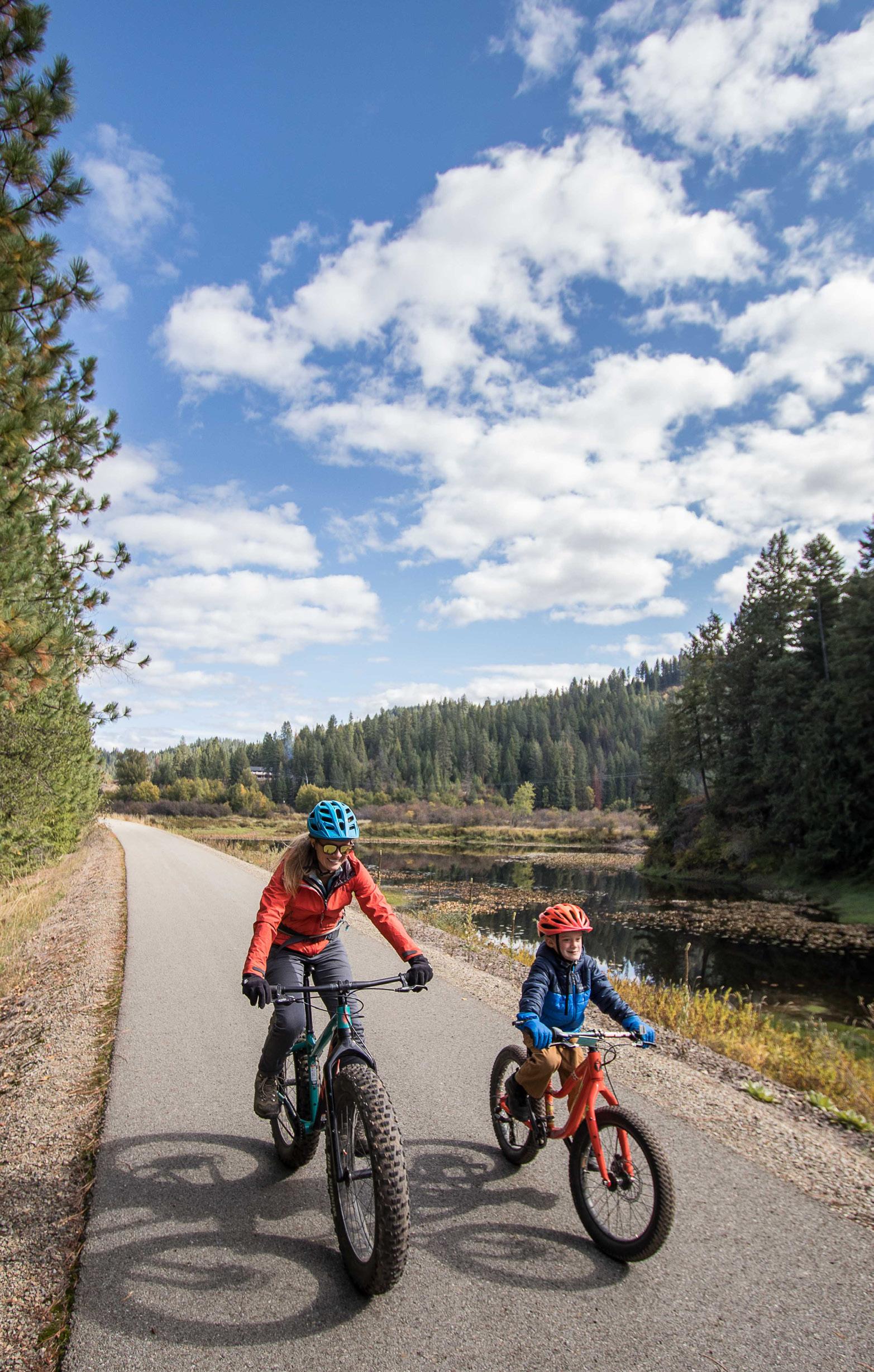

The varied trails of the Coeur d’Alenes— the Hiawatha, Nor-Pac (Northern Pacific), Milwaukee Road, Olympian, Trail of the Coeur d’Alenes, and the Centennial—remain open and ready for your fall visit with fall colors and local history along the way.
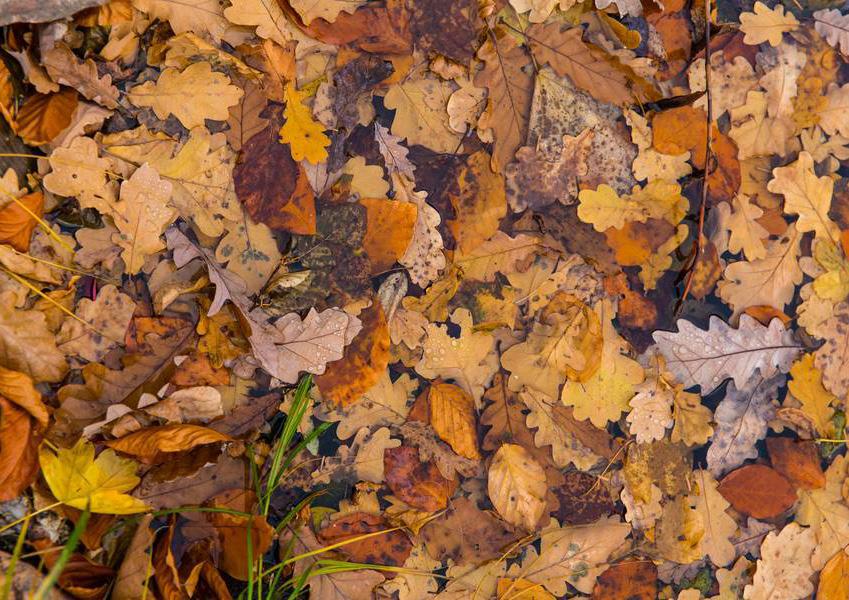
The incredible, downhill Route of the Hiawatha rail trail with its 10 tunnels and seven trestles takes riders from Interstate 90 smack dab into the Idaho backcountry via the St. Paul Pass tunnel (Taft Tunnel). Coursing through the Bitterroot Mountains, the “hardly have to pedal,” user-friendly path drops 1,000 vertical feet over its 15-mile length. Take the leisurely one-way downhill cycle and then a timely, on-the-trail shuttle back to the top. Or, make it an even bigger day with a round-trip pedal. The last day of the season is September 17 so don’t delay. Contact Lookout Pass for trail and shuttle passes and rental gear.
The Northern Pacific Trail (Nor-Pac) rail trail connects the Hiawatha with the Trail of the Coeur d’Alenes on its non-paved, multiuse track over Lookout Pass. The Nor-Pac runs 21 miles from Taft, Mont., to Mullan, Idaho, offering more recreational seclusion and fun. Along its route, the trail passes leftbehind railroad structures. Take the easy detour around the closed Borax tunnel.
Rail-trail extensions of the Hiawatha through the East Portal (Olympian) east to St. Regis, Mont., and from Pearson (Milwaukee Road) west all the way to St. Maries, Idaho, via Avery offer more miles of backcountry biking. Uncrowded trails, primitive USFS and private campsites, and other varied lodging venues exist where deer and elk outnumber people. The Milwaukee Road is part of the Bitterroot 300 (B300), a 185-mile route
that includes the Trail of the Coeur d’Alenes, Nor-Pac, and Hiawatha trails as well as other connectors for an unparalleled loop ride. To make the most of your B300 ride, start in historic Wallace, going clockwise to get the primary climb over Lookout Pass out of the way. Also, be sure to acquire a shuttle from St. Maries to Heyburn State Park (Trail of the Coeur d’Alenes) to avoid a precarious pedal on Idaho State Rt. 5.
The 73-mile paved, non-motorized Trail of the Coeur d’Alenes, part of the Great American Rail Trail system, crosses the Idaho Panhandle with multiple trailheads, allowing cyclists, rollerbladers and trekkers to enjoy untamed flora and fauna and small-town charm in Wallace, Harrison, Kellogg, Mullan, and Cataldo. History of our storied mining heritage—inclusive of mining wars, union uprisings, fortunes gained and lost, the Buffalo Soldiers, and the Big Burn (aka the 1910 Fire)—abounds along the trail.
Further west, the paved Centennial Trail explores Post Falls and Coeur d’Alene along its 23-mile length. Along the east end of the trail from Higgens Point, ride this recreational delight with super lake views and many historical markers, benches, and restrooms. Heading west into Coeur d’Alene, Tubbs Hill and City Park are gateways to the city’s eateries, breweries, shopping, carousel, museums, and more. Farther west the trail follows along the Spokane River into the Riverstone complex with more urban amenities before continuing on to Post Falls and the state-line junction with the Spokane River Centennial Trail.
Our North Idaho trails offer great opportunity for families, individuals and friends to experience a short visit on foot or bicycle or a multi-day cycling excursion. Take time to explore the local lodging, eateries, watering holes, and historic and cultural attractions. For fall trip ideas, inquiries, or free trail maps, contact Prime Minister Rick at Friendsofthecdatrails.org. (Provided by Wallace, Idaho’s official Prime Minister and local trail advocate Rick Schafer.)

41 SEPTEMBER-OCTOBER 2023 / OUTTHEREOUTDOORS.COM
TAKING BREAKS FROM PEDALING TO LEARN ABOUT THE NATURAL HISTORY ALONG THE TRAIL. PHOTO: SHALLAN KNOWLES
BUGS!
HEAT!
CROWDS!
RAIN!
PROBLEMS!
TIMES ON
OF MILES OF
TRAILS. GO! PACKAGE ON THE COEUR D’ALENE TRAILS FRIENDSOFCDATRAILS.ORG FALL ADVENTURE PLAN YOUR
STAY
NO
NO
NO
NO
NO OTHER
JUST GREAT
HUNDREDS
STRESS FREE
CYCLE &
FALL ADVENTURES CHEWELAH, WASH.
AN HOUR NORTH OF SPOKANE in the beautiful Colville River Valley, Chewelah is best known by outdoorsy types for its proximity to 49 Degrees North Mountain Resort. Yet the ubiquitous natural beauty and proximity to huge swaths of public land have buoyed the development of new trails and opening of unique local businesses. Choose your own road trip adventure with a mix of hiking; mountain, road, or gravel biking; backroad exploring and wildlife spotting; or in-town imbibing.
HIKING QUARTZITE MOUNTAIN & GOLD HILL

Despite being built by the Boy Scouts back in 2004, the Quartzite Trail, which climbs steeply for 1.5 miles to the top of Quartzite Mountain, is still not that well known. It’s well worth trekking up the steep trail to the top for stunning views atop Chewelah’s iconic peak. (Note that young children may struggle with the terrain.) Keep an eye out for a mailbox near the top that has served as a summit register for hikers. Find a map and trailhead directions at Wta.org.
Another new Chewelah hiking option a few minutes’ drive out of town is the trails at the Gold Hill Community Forest. A project of the Chewelah Valley Land Trust, there are miles of newly-built trails and old forest roads that climb the forested property where great views await. Hikers should keep an eye out for the occasional mountain biker on the singletrack trails, and there’s one downhillonly bike trail that’s best to avoid. To find the trails, drive north on 395 through Chewelah to Sand Canyon Rd. to Golf Course Rd., then follow the signs.
FALL HIKING AND MOUNTAIN BIKING AT 49 DEGREES NORTH
September and October are great months to head up to the mountains at 49 for a hike or mountain bike ride. Autumn comes early in the higher peaks around the resort,
EXPLORE NEW TRAILS AND OLD FAVS IN THIS EVOLVING MOUNTAIN TOWN
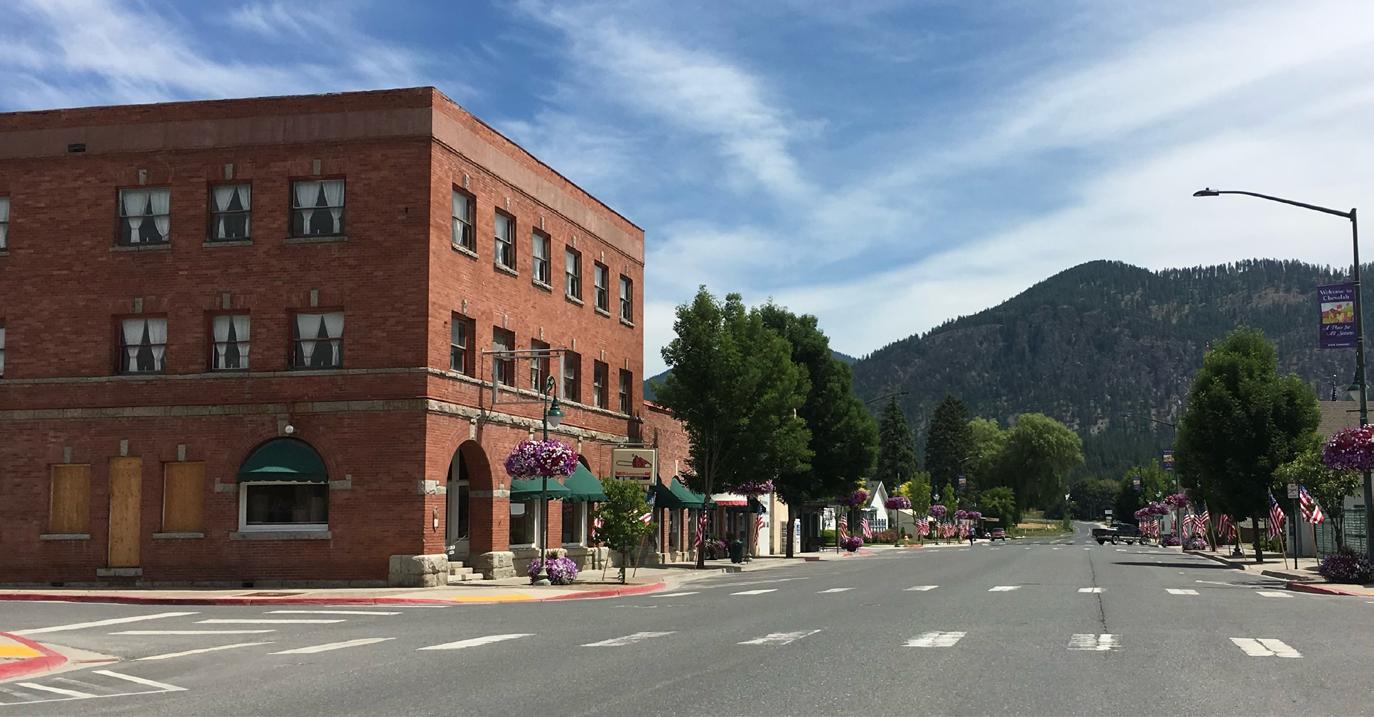
making it a nice place for spotting fall colors on the sprawling acres of the surrounding Colville National Forest.
Mountain bikers looking for a short out-and-back pedal through the forest or a choose-your-own-speed workout climb to the top of the mountain will be rewarded with great views and fall colors followed by a fast descent back down. The resort recommends several service roads in the west, central and east basins that make for excellent mountain bike rides. The Nordic trails also offer a great tour on a mountain or gravel bike.
49 is accessible via hiking during the summer and fall as well. Hikers can explore the forest and fall colors on the Nordic trail system, service roads and, for an added challenge, the ski runs themselves. For an easier way to the summit, 49 recommends taking Portal to Silver Ridge.
When visiting the area in the summer or fall, keep an eye out for heavy machinery at work on the resort and don’t block any gates or roads when parking. The best place to park is the main lot or Nordic area lot. Visit Ski49n.com/mountain-info/summer for a map and more info.
NEW MOUNTAIN BIKE TRAILS NEAR CHEWELAH
Just a few minutes’ drive from downtown, the new Gold Hill Community Forest trails offer 15 miles of routes that include new singletrack and old doubletrack logging roads that are open for mountain biking and hiking. The biking trails include a new machine-built flow trail, the downhill-only Balsamroot Bomber, as well as a great climbing trail and two other fast and fun more xc-oriented trails. Several laps will put a good dent in your day, a smile on your face, and a thirst in your throat for a cold drink back in town. Check out Trailforks for more info.
WORLD-CLASS ROAD BIKING
The Chewelah and Colville areas are blessed with miles of smooth, lightly-trafficked yet highly scenic paved roads that seem to go on forever. There are plenty of hill climbs and flat valley cruisers to choose from. Many of the rides in the area were popularized and promoted by the Rotary Club of Colville in a regional road biking map. These options were recommended by Dave McGrane in a 2016 Out There article covering road rides in the area. There are several possibilities that wind through the valley, he wrote, including Zimmer, Old Hwy, Sand Canyon, Cozy Nook, Burnt Valley and Cottonwood Roads. These roads also make for a great back road drive.
“Try the flat Chewelah Valley Loop,” writes McGrane. “Ride Hwy 395 south to Farm to Market then cross Waitts Lakes Rd. to Long Prairie and Forest Center. Come back on Hwy 231 to Valley and return to Chewelah on Hafer and Cottonwood (32 miles, 955 elevation gain).” For more area road bike ride ideas, check out McGrane’s full article at Outthereoutdoors.com/fiveepic-road-rides-in-northeast-washington.
RE-FUELING IN HISTORIC DOWNTOWN

Despite the blow the community felt when a recent fire destroyed Chewelah’s Sety’s Ace Hardware and the 100-year-old build-
ing where it was located, the community is thriving like never before. In the past decade, new businesses have begun to take root in the town that serves as the gateway to 49 Degrees North and thousands of acres of public land. Quartzite Brewing, which has indoor and outdoor seating where you can enjoy their highly lauded craft beer, opened in 2016, and other new businesses and old favorites are giving visitors and travelers more reasons to stop and check the town out.
This past summer, Andie’s Sandwiches & Sports opened downtown, offering a huge selection of sandwiches and other sports bar fare. Right next door, longtime Chewelah watering hole and eatery Sporty’s Bar & Grill has a massive menu full of Americana favorites. Be sure to wander around the shops at the Mountain Market on Main and check out the fine dining menu at Salt Bistro. Also downtown, the Yale Press coffee shop and café make a great stop before heading out for a day of hiking or biking.
Chewelah makes for a close-to-home fall road trip with plenty of outdoor adventure and intown amenities to create a memorable and restorative weekend getaway. (OTO)
42 OUTTHEREOUTDOORS.COM / SEPTEMBER-OCTOBER 2023












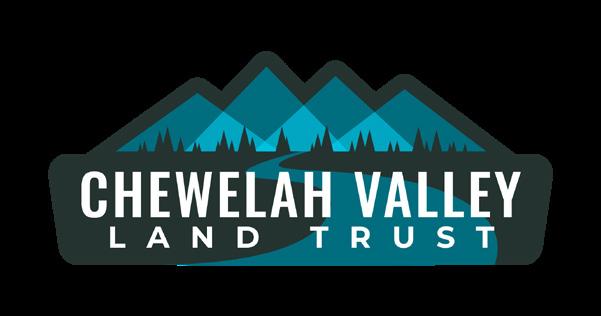





Find New Fall Adventures in Chewelah, WA! Gateway to the Colville National Forest Road Trip Worthy Biking Hiking Scenic Drives 49 Degrees North Fall Colors Historic Downtown Great Food & Brews
HEAD NORTH FOR A SINGLETRACK ROAD TRIP ROSSLAND, BC

SEPTEMBER AND EARLY OCTOBER in the Spokane area often feel like a never-ending addendum to summer, with hot temps and moon-dust dirt the new norm on the trails. All the while, two hours north, the cooler mountain air and larch-and-fir-filled forests that see more frequent trail-restoring showers make it worth a shoulder season road trip to the mountain bike mecca of Rossland, British Columbia.
It may have been the 18-mile Seven Summits Trail that put Rossland on the mountain bike destination map, but that classic alpine ride is but a highlight on the town’s hard-earned riding resume. Nearly 150 miles of mountain bike trails, mostly community funded and built by the Kootenay Columbia Trails Society, form a vast trail network around the historic mining town. This expansive trail system connects mountain town amenities like Rossland Beer Company; cafés, restaurants, and cool shops; and adventure provision providers
like Ferraro Foods market with trails that span from the U.S. border northwest to RED Mountain Resort and Nancy Green Pass. All those trails make it all too easy and fun to set out on a ride from your hotel room, rental, or campsite and end up connecting trail after trail that quickly turns into a mind- altering adventure ride.
If solidly-rated black trails are what you’re looking for, stop by Revolution Cycles for recommendations that may include the likes of Whiskey/Whiskey On The Rocks, Redhead, and Paydirt. Or, if the Seven Summits Trail is on your trail wish list, September (and sometimes into October) can be the perfect time to finally tackle this legendary peak-hopper. Make life way easier on yourself and schedule a Seven Summits shuttle with Kootenay Mountain Biking (Kootenaymountainbiking.com)—they run shuttles on other popular local trails too and offer group mountain bike clinics and private lessons for all abilities.
While Rossland has its fair share of gnarshredding expert trails, there are plenty of flowy blue trails and a growing number of beginner-friendly green trails. The Mxitp Xewílh (Cedar Trail)—a new 11-mile, more moderate grade green trail that twists and turns through patches of old growth forest— is now open to ride. Plan to give this new ribbon of dirt a pedal on its own or as part of a longer ride. The full trail connects the town of Rossland to the start of the Seven Summits Trail (up your badassery by starting this epic from town). Or use the Cedar
GOLF CLUBS GONE WILD
Trail to access the growing trail network at RED Mountain or the awesome Larch Ridge/ Monticola/COG loop, which features some fun, sporty climbs and a joyous blast down the seemingly endless rollercoaster-like tread of the Monticola Trail that’s most certainly double-lap worthy.
Some of the best riding conditions of the year on uncrowded, awe-inspiring trails await up in Rossland as the larch and other fall foliage fireworks begin. Plan your adventures at Tourismrossland.com. (Derrick Knowles)
If you like swinging a club anywhere near as much as you like ripping down singletrack, or just need a day out of the saddle, Rossland has a hidden golf gem. The Redstone Resort, say many visitors, is the most beautiful golf course in Canada. The 18-hole, championship alpine course is surrounded by the wild mountains and views of the Rossland Range and open to the public. Play a quality round and gawk at the fall colors—just keep an eye out for wildlife! More info at Redstoneresort.com.
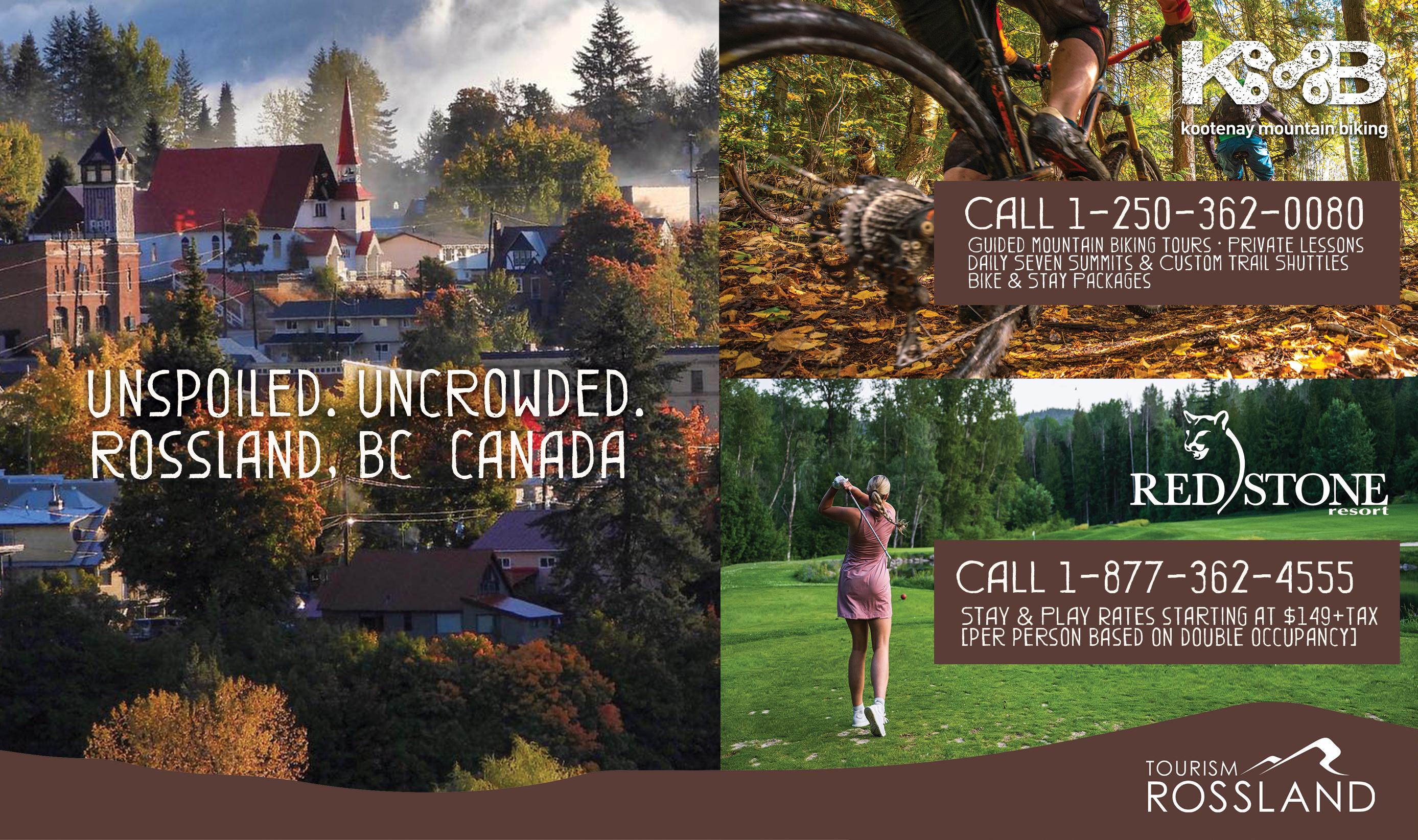
44 OUTTHEREOUTDOORS.COM / SEPTEMBER-OCTOBER 2023
FALL RIDING COMES EARLY IN THIS CLOSE-TO-THEBORDER MOUNTAIN TOWN
PHOTO: RYAN FLETT. // COURTESY OF TOURISM ROSSLAND
DISCOVER HISTORY, LOCAL FOOD, AND SCENIC BACK ROADS COLVILLE, WASH.


THE NORTHEAST WASHINGTON community of Colville makes a great weekend or mid-week fall road trip. Colville has several restaurants, bars, breweries, lodging options and a walkable, historic downtown surrounded by beautiful mountains. Plus it’s just minutes away from Lake Roosevelt. For a unique getaway, explore the region’s history at the Keller Heritage Center & McDowell Museum and then take a scenic driving loop with some stops for local produce, wine, and brews.
EXPLORE LOCAL HISTORY AT THE KELLER HERITAGE CENTER & MCDOWELL MUSEUM
The town of Colville was founded in 1882 and the first school was built from handhewn logs not long after that. The area has a rich military, trapping, mining, logging, and agricultural history that you can still explore today thanks to local efforts to preserve the town’s historic buildings and other artifacts.
Built in 1910, the Keller House is a modified bungalow-style house that exemplifies the English Craftsman movement. The 7-acre center includes the museum, Keller House and Carriage House, lookout tower, Colville’s first log school, a
homestead cabin, mining exhibit, miner’s cabin, dynamite shack, trapper’s cabin, blacksmith exhibit, sawmill and machinery exhibit, and more. The museum and center are located at 700 North Wynne St. in Colville, with daily hours from 1-4 p.m. through September 30.
TAKE A SCENIC MOUNTAIN & LAKE DRIVE
This approximately 70-mile driving loop includes stops for local produce and food, a scenic drive over the Huckleberry Range mountains, and a drive along Lake Roosevelt. We highly recommend that you plan your fall road trip on a Saturday to start your day at the Colville Farmers’ Market, where you can pick up fresh produce and other craft food items for the drive as well as artisan goods. The market, which has been around since 1974, is located at E Astor and Oak Street between the library and court house in Colville and is open 9 a.m. -1 p.m. on Wednesdays and Saturdays through October. More info at Newfarmersmarket.org
SCENIC DRIVING LOOP DIRECTIONS: From the Colville Farmers’ Market, drive south on Highway 395 to your next stop at Front
Porch Farm, 9 miles from Colville near the town of Addy. Shop for local food, fresh seasonal produce, and antiques (fall hours are 12-6 p.m. on Tuesdays, Thursdays, and Saturdays), then continue south on Hwy 395 to Addy and then west and up over the Huckleberry Range mountains on AddyGifford Rd. until you reach Hwy 25 and Gifford, Wash.
At Gifford, stop and spot the IncheliumGifford Ferry, which is operated by the Colville Confederated Tribes and makes trips across Lake Roosevelt between the town of Inchelium and Highway 25. The free vehicle ferry has been in operation since 1898. Driving north along beautiful Lake Roosevelt, your next stop is the Bradbury Day use area on Lake Roosevelt. Stretch your legs and have a picnic with any local produce
and other farm-fresh goodies you picked up along the way. There are picnic tables, barbeque grills, restrooms, and public access to the lake. Bring a kayak, paddleboard, or canoe and work an afternoon paddle into your road trip.
Continue north on Hwy 25 to Hwy 395 and head back south through Kettle Falls and on to Colville. For a great end to an afternoon drive, park downtown and walk the historic streets and sample local craft beer and food at the Colville Pour House and Fired Up Brewing. Stay the night in one of Colville’s many hotels and rental homes and find a nearby hike for the following day at the local online trail resource Newashingtontrails.com.
45 SEPTEMBER-OCTOBER 2023 / OUTTHEREOUTDOORS.COM
(OTO) FLOWERY TRAIL. // PHOTO COURTESY OF COLVILLE
OF COMMERCE
CHAMBER
Living with a Wonky Ticker
By Patrick Bulger
WHO REMEMBERS THAT FEELING, when you were young(er), and all signs pointed to the likelihood of living forever? There was always a new challenge to accept. The time to play was always there, and the ability to at least attempt was never in question.
Well, that’s only partially true, folks. Life is a timed event.
Let me provide some perspective on my own journey with mortality. I promise this has a reasonably happy ending.
In February of this year, I woke up with a strange feeling in my chest. The best way to describe it would be the sensation of a beginning percussion class full of tiny seven year olds attempting a jazz beat on my heart. My resting pulse, usually below 60 BPM, was as consistent as spring weather in the Northwest. All over the place. I was tired. I couldn’t climb a flight of stairs without getting winded.
So I went about my days, until my Apple Watch told me I was in trouble. The device I associated with texts and changing the song was now telling me I needed to get to the ER, STAT.
Let’s just say that Kareem Abdul Jabbar and I now have something in common. Atrial Fibrillation is defined as an irregular

and, at times, rapid heart rate that sets the top chambers of the heart (atria) and the bottom (ventricles) into a tempo that basically resembles the sound and feel of those moments when two cars blasting their stereos come to the same stoplight. The atria are cranking the syncopated jazz while the ventricles are sticking to mellow soft rock. It also, all joking aside, puts the likelihood of stroke about five times higher. Medications that thin the blood, limit the heart’s maximum rate, and a new friend in the form of a Cardiologist were now a regular part of my life.
This wasn’t fair. I have been a cyclist since the time of LeMond. Since the time of pedals with toe straps and leather helmets. I’ve taken reasonably good care of my body. I’ve been fit my entire adult life. Well, fit enough.

To tell me I couldn’t potentially ride my bike is the equivalent of telling Santa Claus he can’t deliver presents. It is what defines me, and I was staring down the prospect of a house full of bicycles, a podcast and business about bicycles, and drawers of lycra all being useless paper weights.
So, after a few weeks of sulking around and waiting for a proper doctor’s appointment, I decided to speak with some people who know what they’re talking about. Lennard Zinn is an accomplished bicycle builder, mechanic, and author of “The Haywire Heart,” a book that discusses cardiac issues that can develop in endurance athletes. The good news is that it isn’t overly common. The bad news is that, according to Zinn, the research is just beginning to present itself. Athletes who began endurance sports in the 1970s, about the time of the original running boom, who have been pushing their cardiac muscles to their limits
since the time of disco, are now beginning to experience heart failure issues.
Think about it this way: Zinn described it using the skin on the back of the hand. As one ages, the skin on the back of the hand becomes thinner and less flexible. Over 40? Try it right now. Notice that the skin is not as pliable as it was in your 20s. That process is happening all over your body. Continuing to ask for that same kind of blood volume in your 50s, asking the heart to enlarge as it would in your 20s, when it is no longer as flexible as it was, leads to what Zinn refers to as “micro tears in the myocardium.” When those micro tears heal, they cause scar tissue, which then can cause disruptions in the electrical signals in the heart.
I had a “wonky” heart, as the kids would say, because I chose to push myself for multiple decades.
The good news is there were, and are, options. The first, a glorified reset of the heart called a cardioversion, is simply applying an electrical shock to the heart to allow it to find its original rhythm, like when an IT worker tells you to turn your computer off and on again. While for many this is the only step required, mine only lasted about two weeks. The second was a bit more of a “surgical” procedure called an ablation, where the electrical signals causing the AFib are actually, well, destroyed, but in a good way. It sounds nasty, but was a procedure that only took about three to five hours in a hospital (some stay overnight). That happened May 1 for me.
I’m a very lucky person. I’ve been able to return to the sport that I love, and ride and race against my friends, and, most impor-
tantly, my son. What would I have done if that hadn’t been the case? I’d have continued. I’d have purchased an e-bike to still feel the wind in my face. I’d have supported my fellow cyclists.
I’ve learned to listen to my body. I’ve learned to check my watch for features
other than skipping songs by Steve Miller. I’ve learned that regular doctor visits are a good call, even when nothing is wrong. I’ve learned that one can be a cyclist even though they don’t necessarily ride a bike. I’ve learned to get outside as often as possible, because as I stated earlier, life is a timed event, and fortunately my clock is still ticking along at or around 60 BPM. //
Patrick Bulger has been an active and competitive cyclist for decades. He is also the host and creator of The Packfiller Podcast, a weekly show featuring the world of road, mountain, and gravel cycling.

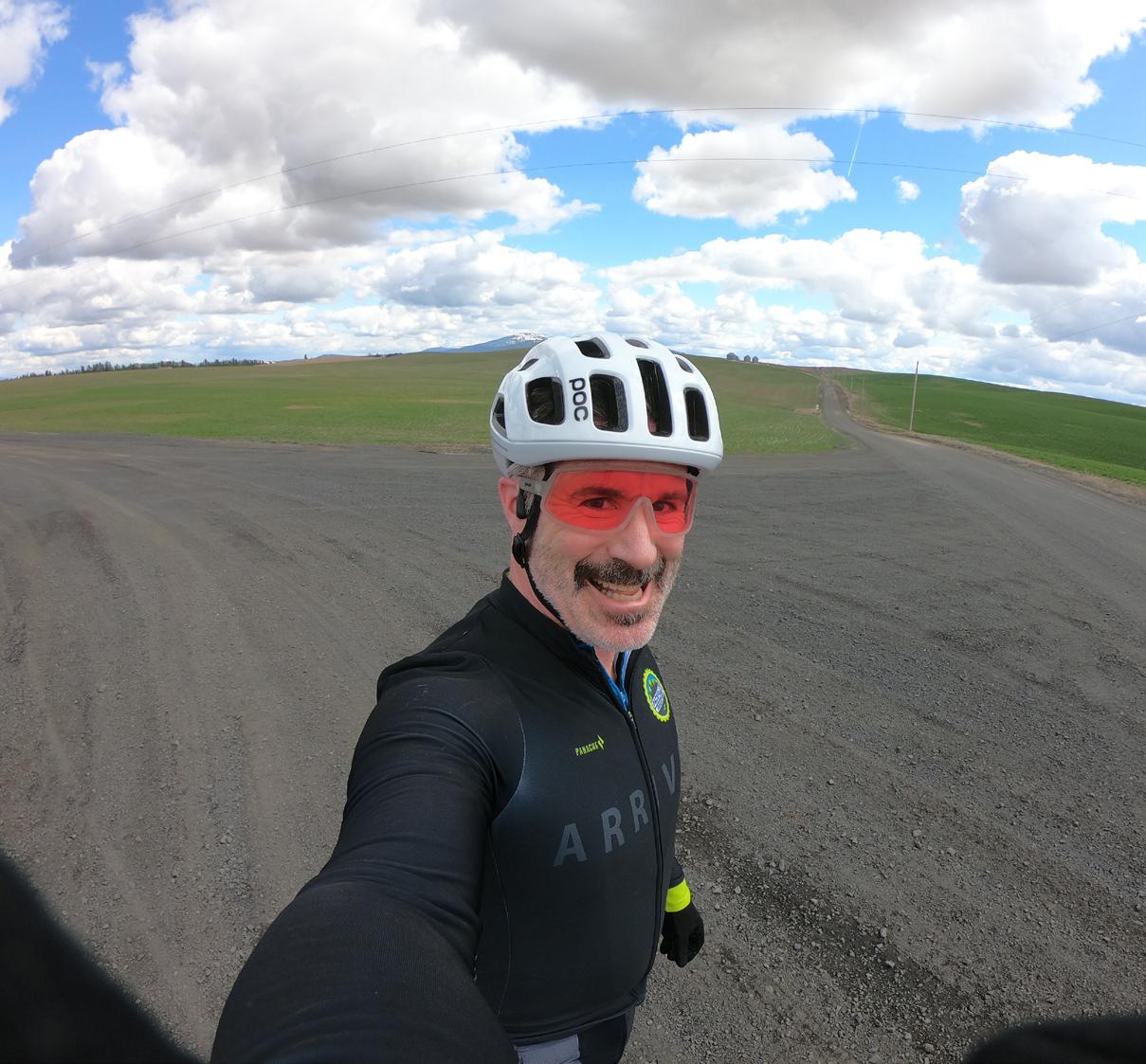
46 OUTTHEREOUTDOORS.COM / SEPTEMBER-OCTOBER 2023 LAST PAGE
TO TELL ME I COULDN’T POTENTIALLY RIDE MY BIKE IS THE EQUIVALENT OF TELLING SANTA CLAUS HE CAN’T DELIVER PRESENTS.
FEELING GOOD // MIDDLE: PRE
CARDIVERSION // RIGHT: RETURN TO RACING WITH MY SON BEHIND ME. BOTTOM: AFIB.
PHOTOS: PAT BULGER
Spokane Alpine Haus is the place for all your ski/snowboard and apparel needs in Eastern Washington and Northern Idaho. With multiple Master t certi ed boot tters, a boot t guarantee, and more than 1,100 google reviews with an overall rating of 4.9 stars. You will nd it’s the place people trust most.

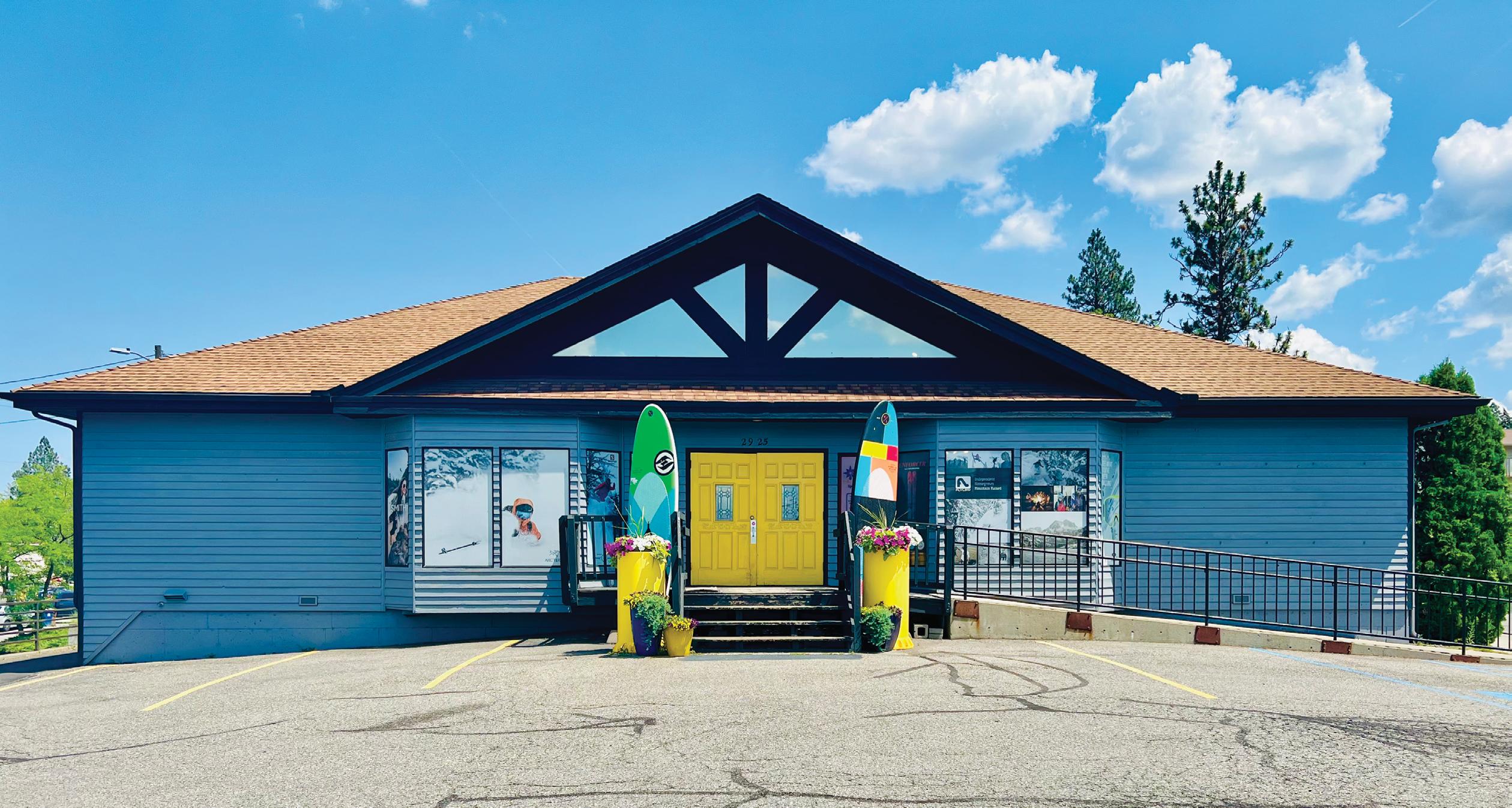
The amazing team at the Alpine Haus have made it a point that it doesn’t matter your ability level, they have the gear for you. From season lease, to buy back programs, as well as the newest gear from the hottest brands, they have something that ts your needs and your budget!
At the Alpine Haus, they know it isn’t always about new gear but maintaining what you currently have.
Their state-of-the-art tuning & boot tting equipment will get you out on the slopes ripping down the mountain.


And nally, we realize that skis, boards and boots aren’t the only items you need on the hill. Spokane Alpine Haus has a carefully curated apparel and accessories assortment that is sure to t everyone’s needs. Getting out on the mountain is such a fun place to blend fashion and function together and they do it best! While they have an assortment of prices to t everyone’s budget, they never scrimp on quality. You know you’re getting the best at the Alpine Haus.

47 SEPTEMBER-OCTOBER 2023 / OUTTHEREOUTDOORS.COM TheSpokaneAlpineHaus.com
2925 S Regal St Spokane, Wa 99223

Spokane Tasting Room





































































































 By Sarah Hauge
By Sarah Hauge









 (James P. Johnson)
(James P. Johnson)








 By Ammi Midstokke
By Ammi Midstokke

























 By Bri Loveall
By Bri Loveall






















 By Derrick Knowles
By Derrick Knowles


































 Be Our Guest:
Paddleboarding on Flathead River, Kalispell, MT
Be Our Guest:
Paddleboarding on Flathead River, Kalispell, MT













































